Climate Impact on Water Quality in Little Yarra River, Victoria
VerifiedAdded on 2023/06/12
|44
|8381
|326
AI Summary
This project analyzes the impact of climatic conditions on the water quality of the Little Yarra River in Victoria state Melbourne. Results indicate that water quality parameters are strongly affected by climatic changes. Relevant authorities should monitor water quality to protect aquatic life.
Contribute Materials
Your contribution can guide someone’s learning journey. Share your
documents today.
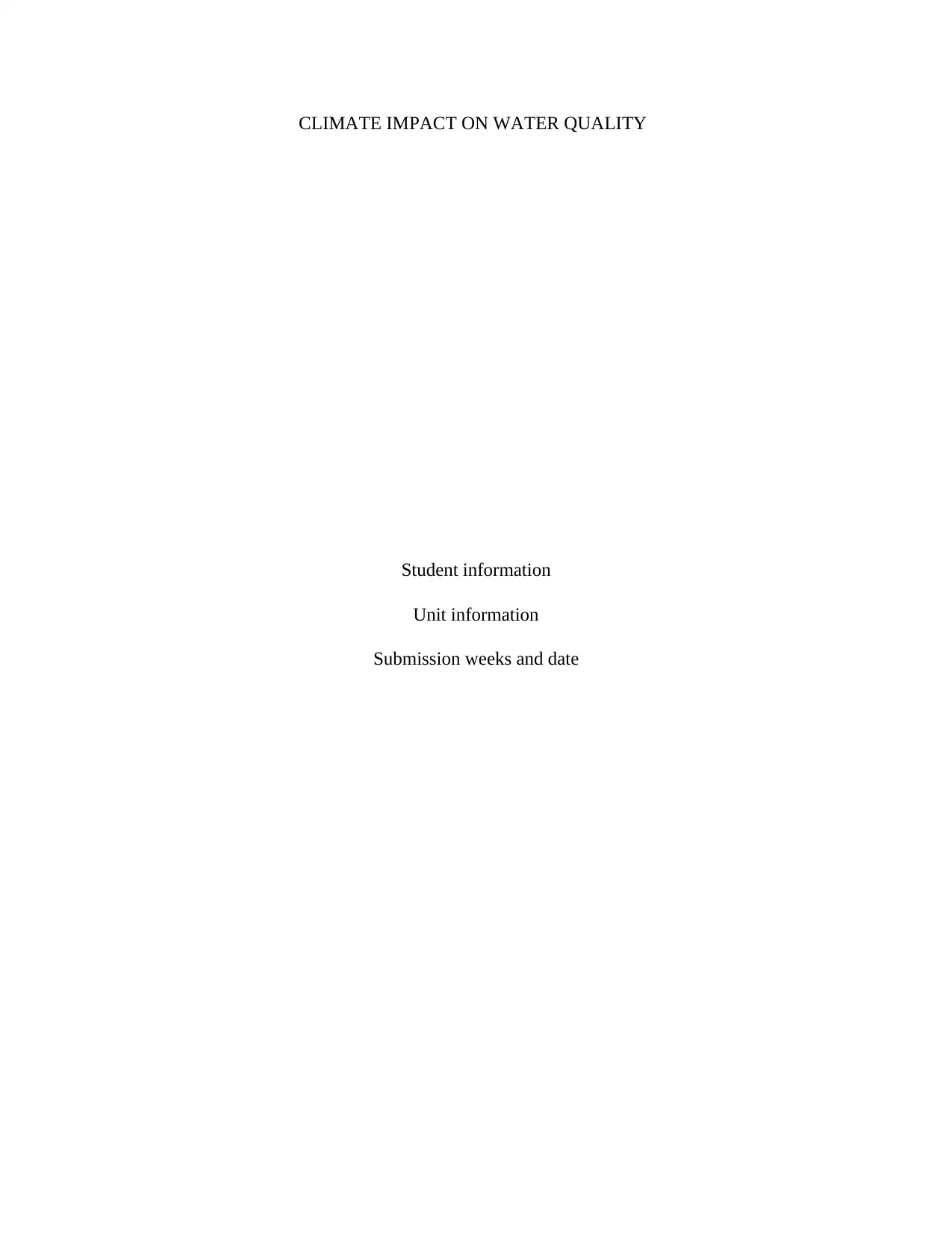
CLIMATE IMPACT ON WATER QUALITY
Student information
Unit information
Submission weeks and date
Student information
Unit information
Submission weeks and date
Secure Best Marks with AI Grader
Need help grading? Try our AI Grader for instant feedback on your assignments.
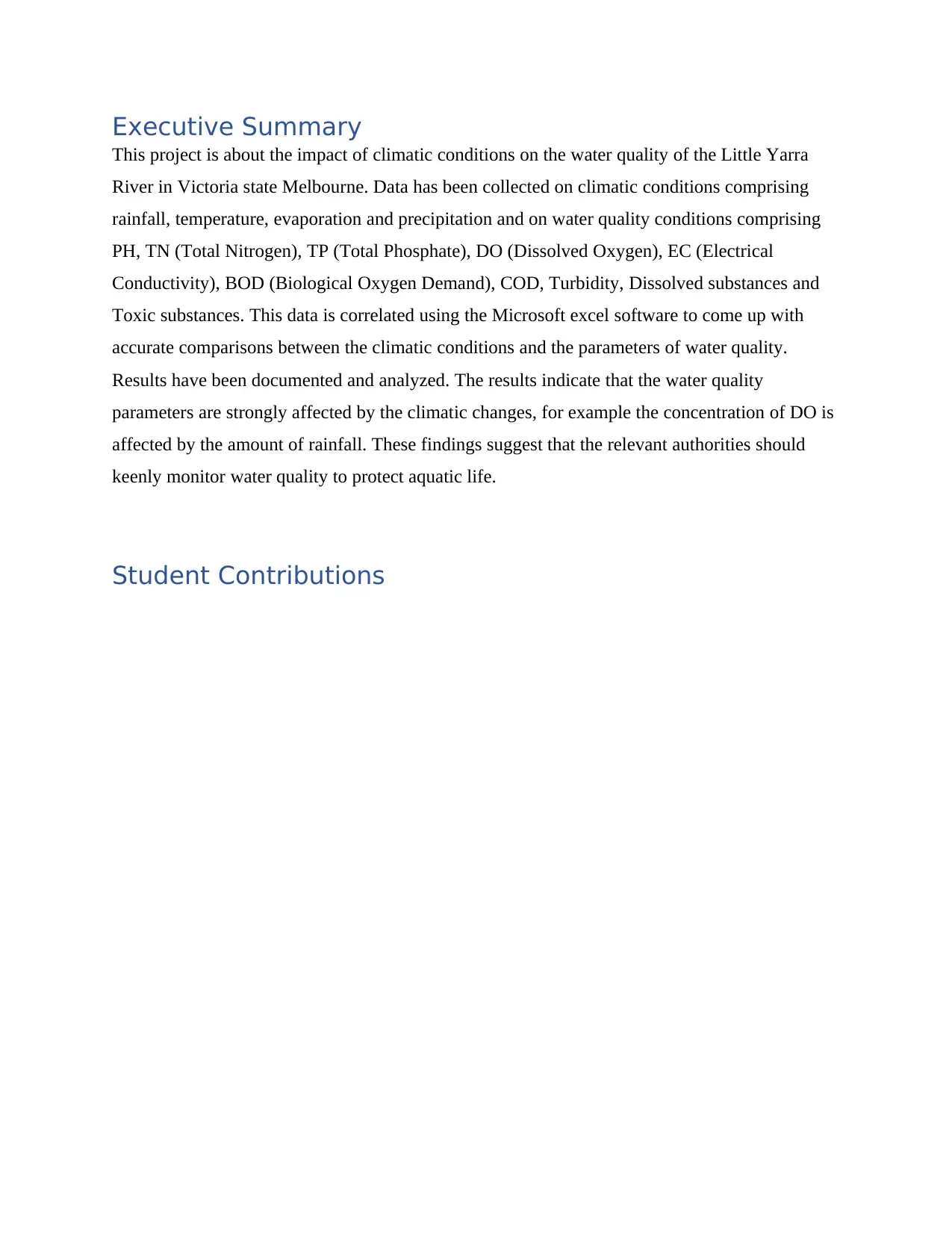
Executive Summary
This project is about the impact of climatic conditions on the water quality of the Little Yarra
River in Victoria state Melbourne. Data has been collected on climatic conditions comprising
rainfall, temperature, evaporation and precipitation and on water quality conditions comprising
PH, TN (Total Nitrogen), TP (Total Phosphate), DO (Dissolved Oxygen), EC (Electrical
Conductivity), BOD (Biological Oxygen Demand), COD, Turbidity, Dissolved substances and
Toxic substances. This data is correlated using the Microsoft excel software to come up with
accurate comparisons between the climatic conditions and the parameters of water quality.
Results have been documented and analyzed. The results indicate that the water quality
parameters are strongly affected by the climatic changes, for example the concentration of DO is
affected by the amount of rainfall. These findings suggest that the relevant authorities should
keenly monitor water quality to protect aquatic life.
Student Contributions
This project is about the impact of climatic conditions on the water quality of the Little Yarra
River in Victoria state Melbourne. Data has been collected on climatic conditions comprising
rainfall, temperature, evaporation and precipitation and on water quality conditions comprising
PH, TN (Total Nitrogen), TP (Total Phosphate), DO (Dissolved Oxygen), EC (Electrical
Conductivity), BOD (Biological Oxygen Demand), COD, Turbidity, Dissolved substances and
Toxic substances. This data is correlated using the Microsoft excel software to come up with
accurate comparisons between the climatic conditions and the parameters of water quality.
Results have been documented and analyzed. The results indicate that the water quality
parameters are strongly affected by the climatic changes, for example the concentration of DO is
affected by the amount of rainfall. These findings suggest that the relevant authorities should
keenly monitor water quality to protect aquatic life.
Student Contributions
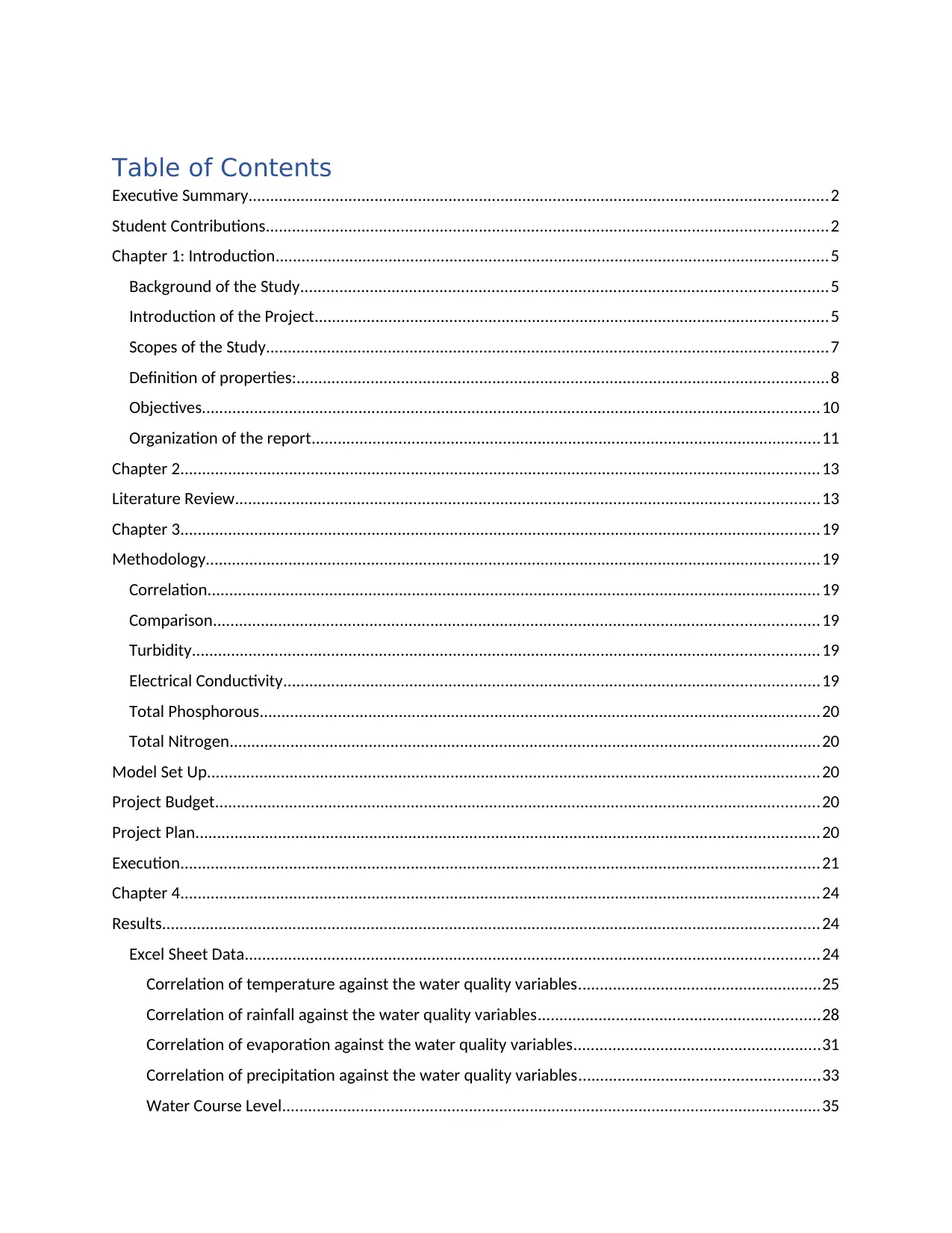
Table of Contents
Executive Summary.....................................................................................................................................2
Student Contributions.................................................................................................................................2
Chapter 1: Introduction...............................................................................................................................5
Background of the Study.........................................................................................................................5
Introduction of the Project......................................................................................................................5
Scopes of the Study.................................................................................................................................7
Definition of properties:..........................................................................................................................8
Objectives..............................................................................................................................................10
Organization of the report.....................................................................................................................11
Chapter 2...................................................................................................................................................13
Literature Review......................................................................................................................................13
Chapter 3...................................................................................................................................................19
Methodology.............................................................................................................................................19
Correlation.............................................................................................................................................19
Comparison...........................................................................................................................................19
Turbidity................................................................................................................................................19
Electrical Conductivity...........................................................................................................................19
Total Phosphorous.................................................................................................................................20
Total Nitrogen........................................................................................................................................20
Model Set Up.............................................................................................................................................20
Project Budget...........................................................................................................................................20
Project Plan...............................................................................................................................................20
Execution...................................................................................................................................................21
Chapter 4...................................................................................................................................................24
Results.......................................................................................................................................................24
Excel Sheet Data....................................................................................................................................24
Correlation of temperature against the water quality variables........................................................25
Correlation of rainfall against the water quality variables.................................................................28
Correlation of evaporation against the water quality variables.........................................................31
Correlation of precipitation against the water quality variables.......................................................33
Water Course Level............................................................................................................................35
Executive Summary.....................................................................................................................................2
Student Contributions.................................................................................................................................2
Chapter 1: Introduction...............................................................................................................................5
Background of the Study.........................................................................................................................5
Introduction of the Project......................................................................................................................5
Scopes of the Study.................................................................................................................................7
Definition of properties:..........................................................................................................................8
Objectives..............................................................................................................................................10
Organization of the report.....................................................................................................................11
Chapter 2...................................................................................................................................................13
Literature Review......................................................................................................................................13
Chapter 3...................................................................................................................................................19
Methodology.............................................................................................................................................19
Correlation.............................................................................................................................................19
Comparison...........................................................................................................................................19
Turbidity................................................................................................................................................19
Electrical Conductivity...........................................................................................................................19
Total Phosphorous.................................................................................................................................20
Total Nitrogen........................................................................................................................................20
Model Set Up.............................................................................................................................................20
Project Budget...........................................................................................................................................20
Project Plan...............................................................................................................................................20
Execution...................................................................................................................................................21
Chapter 4...................................................................................................................................................24
Results.......................................................................................................................................................24
Excel Sheet Data....................................................................................................................................24
Correlation of temperature against the water quality variables........................................................25
Correlation of rainfall against the water quality variables.................................................................28
Correlation of evaporation against the water quality variables.........................................................31
Correlation of precipitation against the water quality variables.......................................................33
Water Course Level............................................................................................................................35
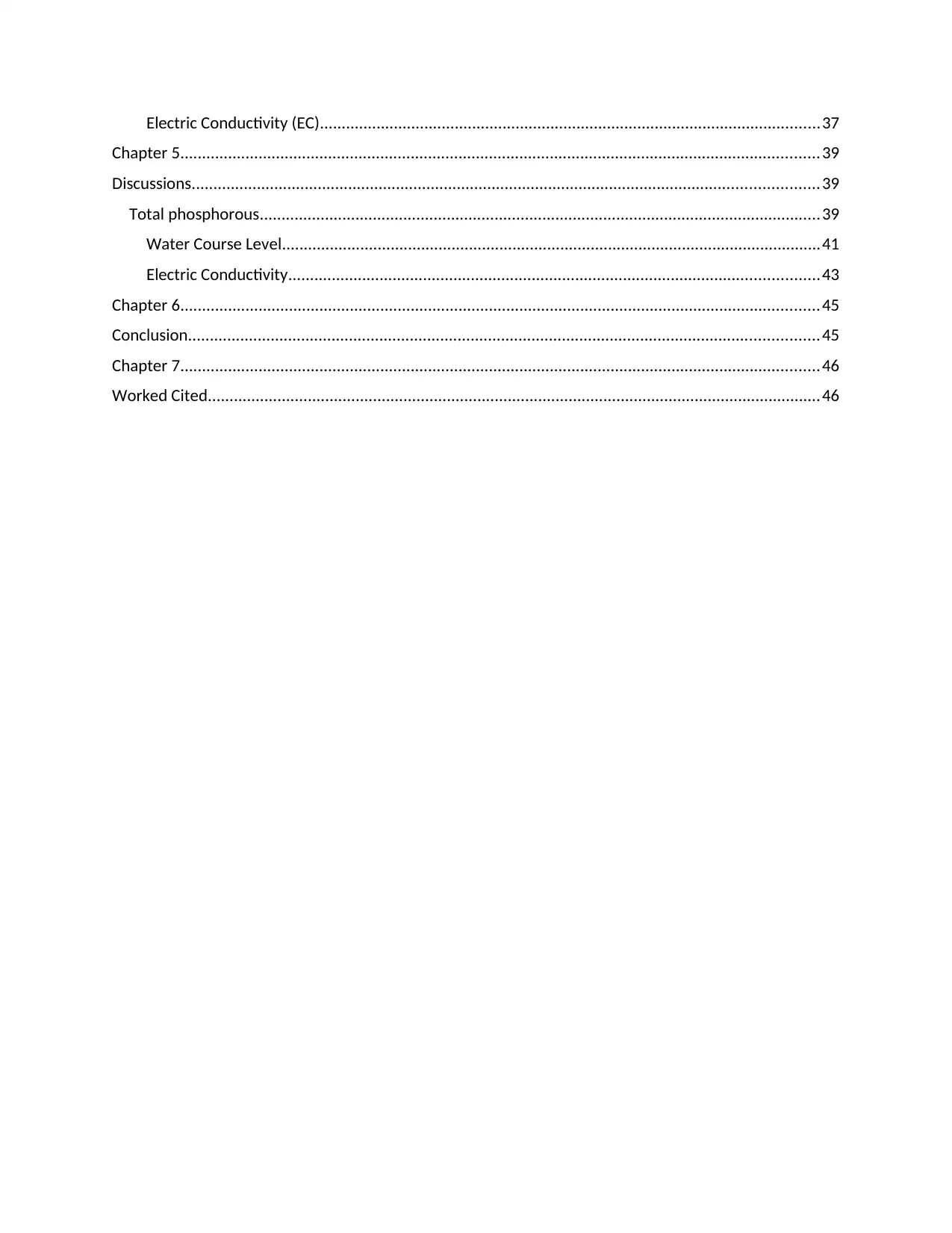
Electric Conductivity (EC)...................................................................................................................37
Chapter 5...................................................................................................................................................39
Discussions................................................................................................................................................39
Total phosphorous.................................................................................................................................39
Water Course Level............................................................................................................................41
Electric Conductivity..........................................................................................................................43
Chapter 6...................................................................................................................................................45
Conclusion.................................................................................................................................................45
Chapter 7...................................................................................................................................................46
Worked Cited.............................................................................................................................................46
Chapter 5...................................................................................................................................................39
Discussions................................................................................................................................................39
Total phosphorous.................................................................................................................................39
Water Course Level............................................................................................................................41
Electric Conductivity..........................................................................................................................43
Chapter 6...................................................................................................................................................45
Conclusion.................................................................................................................................................45
Chapter 7...................................................................................................................................................46
Worked Cited.............................................................................................................................................46
Secure Best Marks with AI Grader
Need help grading? Try our AI Grader for instant feedback on your assignments.
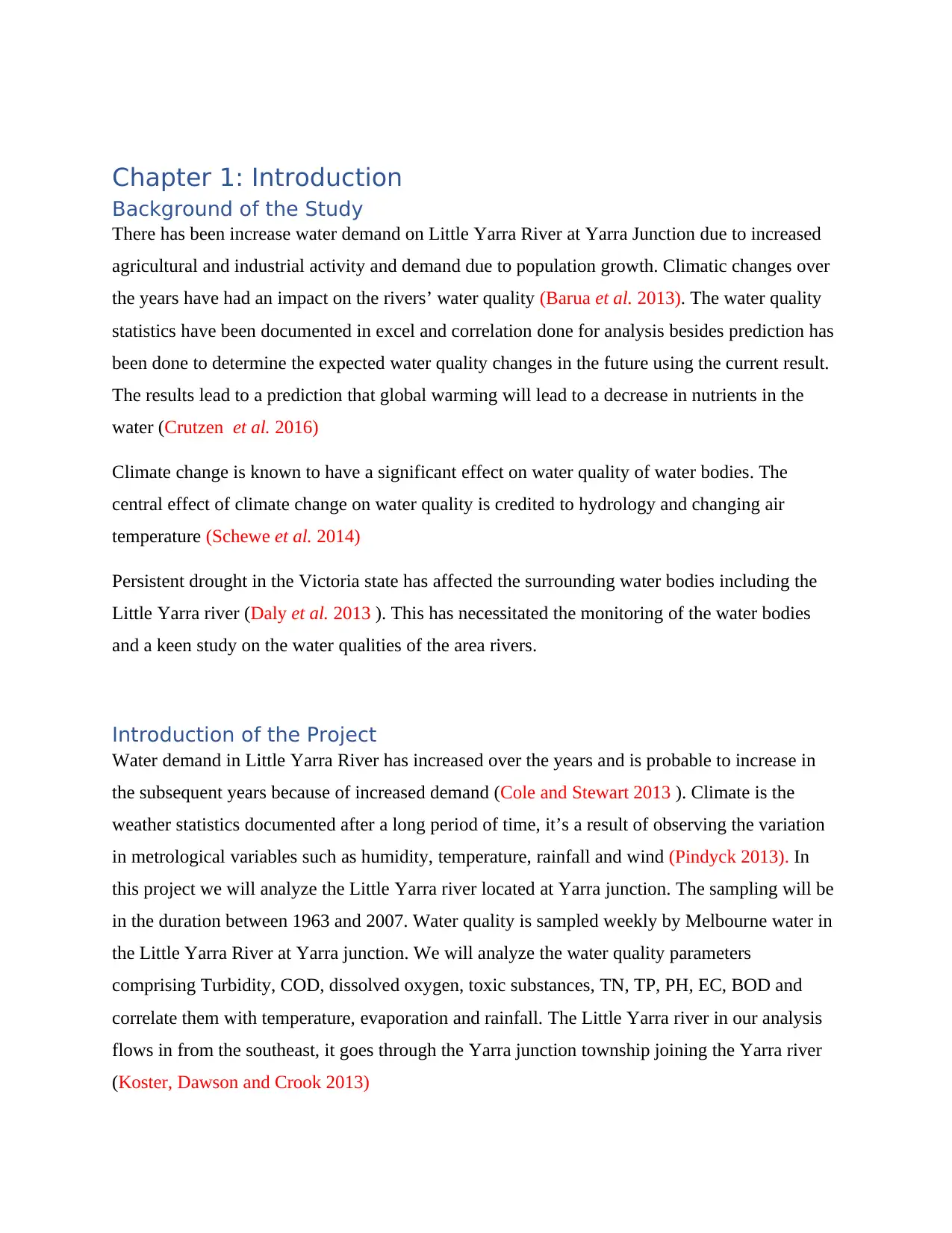
Chapter 1: Introduction
Background of the Study
There has been increase water demand on Little Yarra River at Yarra Junction due to increased
agricultural and industrial activity and demand due to population growth. Climatic changes over
the years have had an impact on the rivers’ water quality (Barua et al. 2013). The water quality
statistics have been documented in excel and correlation done for analysis besides prediction has
been done to determine the expected water quality changes in the future using the current result.
The results lead to a prediction that global warming will lead to a decrease in nutrients in the
water (Crutzen et al. 2016)
Climate change is known to have a significant effect on water quality of water bodies. The
central effect of climate change on water quality is credited to hydrology and changing air
temperature (Schewe et al. 2014)
Persistent drought in the Victoria state has affected the surrounding water bodies including the
Little Yarra river (Daly et al. 2013 ). This has necessitated the monitoring of the water bodies
and a keen study on the water qualities of the area rivers.
Introduction of the Project
Water demand in Little Yarra River has increased over the years and is probable to increase in
the subsequent years because of increased demand (Cole and Stewart 2013 ). Climate is the
weather statistics documented after a long period of time, it’s a result of observing the variation
in metrological variables such as humidity, temperature, rainfall and wind (Pindyck 2013). In
this project we will analyze the Little Yarra river located at Yarra junction. The sampling will be
in the duration between 1963 and 2007. Water quality is sampled weekly by Melbourne water in
the Little Yarra River at Yarra junction. We will analyze the water quality parameters
comprising Turbidity, COD, dissolved oxygen, toxic substances, TN, TP, PH, EC, BOD and
correlate them with temperature, evaporation and rainfall. The Little Yarra river in our analysis
flows in from the southeast, it goes through the Yarra junction township joining the Yarra river
(Koster, Dawson and Crook 2013)
Background of the Study
There has been increase water demand on Little Yarra River at Yarra Junction due to increased
agricultural and industrial activity and demand due to population growth. Climatic changes over
the years have had an impact on the rivers’ water quality (Barua et al. 2013). The water quality
statistics have been documented in excel and correlation done for analysis besides prediction has
been done to determine the expected water quality changes in the future using the current result.
The results lead to a prediction that global warming will lead to a decrease in nutrients in the
water (Crutzen et al. 2016)
Climate change is known to have a significant effect on water quality of water bodies. The
central effect of climate change on water quality is credited to hydrology and changing air
temperature (Schewe et al. 2014)
Persistent drought in the Victoria state has affected the surrounding water bodies including the
Little Yarra river (Daly et al. 2013 ). This has necessitated the monitoring of the water bodies
and a keen study on the water qualities of the area rivers.
Introduction of the Project
Water demand in Little Yarra River has increased over the years and is probable to increase in
the subsequent years because of increased demand (Cole and Stewart 2013 ). Climate is the
weather statistics documented after a long period of time, it’s a result of observing the variation
in metrological variables such as humidity, temperature, rainfall and wind (Pindyck 2013). In
this project we will analyze the Little Yarra river located at Yarra junction. The sampling will be
in the duration between 1963 and 2007. Water quality is sampled weekly by Melbourne water in
the Little Yarra River at Yarra junction. We will analyze the water quality parameters
comprising Turbidity, COD, dissolved oxygen, toxic substances, TN, TP, PH, EC, BOD and
correlate them with temperature, evaporation and rainfall. The Little Yarra river in our analysis
flows in from the southeast, it goes through the Yarra junction township joining the Yarra river
(Koster, Dawson and Crook 2013)
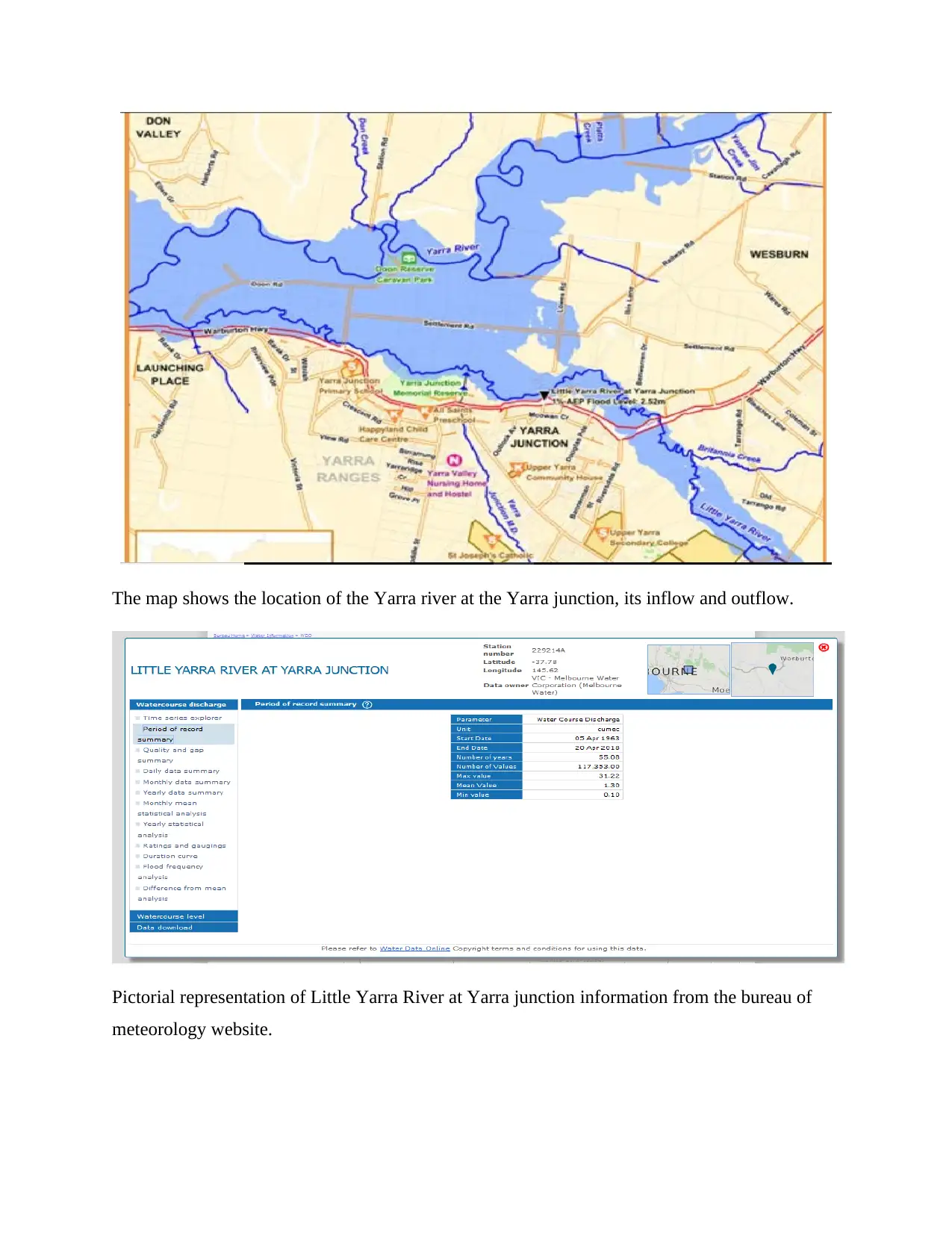
The map shows the location of the Yarra river at the Yarra junction, its inflow and outflow.
Pictorial representation of Little Yarra River at Yarra junction information from the bureau of
meteorology website.
Pictorial representation of Little Yarra River at Yarra junction information from the bureau of
meteorology website.
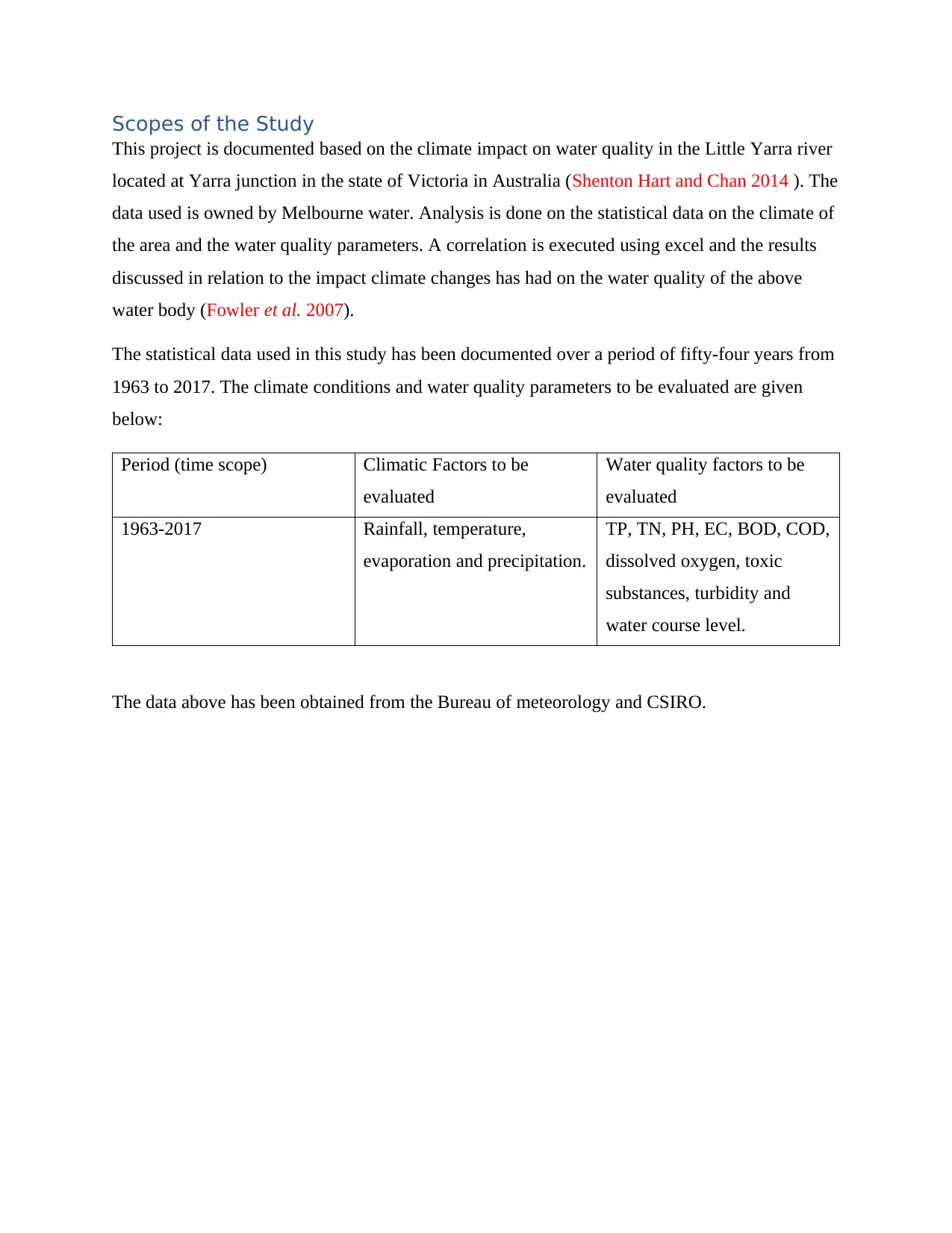
Scopes of the Study
This project is documented based on the climate impact on water quality in the Little Yarra river
located at Yarra junction in the state of Victoria in Australia (Shenton Hart and Chan 2014 ). The
data used is owned by Melbourne water. Analysis is done on the statistical data on the climate of
the area and the water quality parameters. A correlation is executed using excel and the results
discussed in relation to the impact climate changes has had on the water quality of the above
water body (Fowler et al. 2007).
The statistical data used in this study has been documented over a period of fifty-four years from
1963 to 2017. The climate conditions and water quality parameters to be evaluated are given
below:
Period (time scope) Climatic Factors to be
evaluated
Water quality factors to be
evaluated
1963-2017 Rainfall, temperature,
evaporation and precipitation.
TP, TN, PH, EC, BOD, COD,
dissolved oxygen, toxic
substances, turbidity and
water course level.
The data above has been obtained from the Bureau of meteorology and CSIRO.
This project is documented based on the climate impact on water quality in the Little Yarra river
located at Yarra junction in the state of Victoria in Australia (Shenton Hart and Chan 2014 ). The
data used is owned by Melbourne water. Analysis is done on the statistical data on the climate of
the area and the water quality parameters. A correlation is executed using excel and the results
discussed in relation to the impact climate changes has had on the water quality of the above
water body (Fowler et al. 2007).
The statistical data used in this study has been documented over a period of fifty-four years from
1963 to 2017. The climate conditions and water quality parameters to be evaluated are given
below:
Period (time scope) Climatic Factors to be
evaluated
Water quality factors to be
evaluated
1963-2017 Rainfall, temperature,
evaporation and precipitation.
TP, TN, PH, EC, BOD, COD,
dissolved oxygen, toxic
substances, turbidity and
water course level.
The data above has been obtained from the Bureau of meteorology and CSIRO.
Paraphrase This Document
Need a fresh take? Get an instant paraphrase of this document with our AI Paraphraser
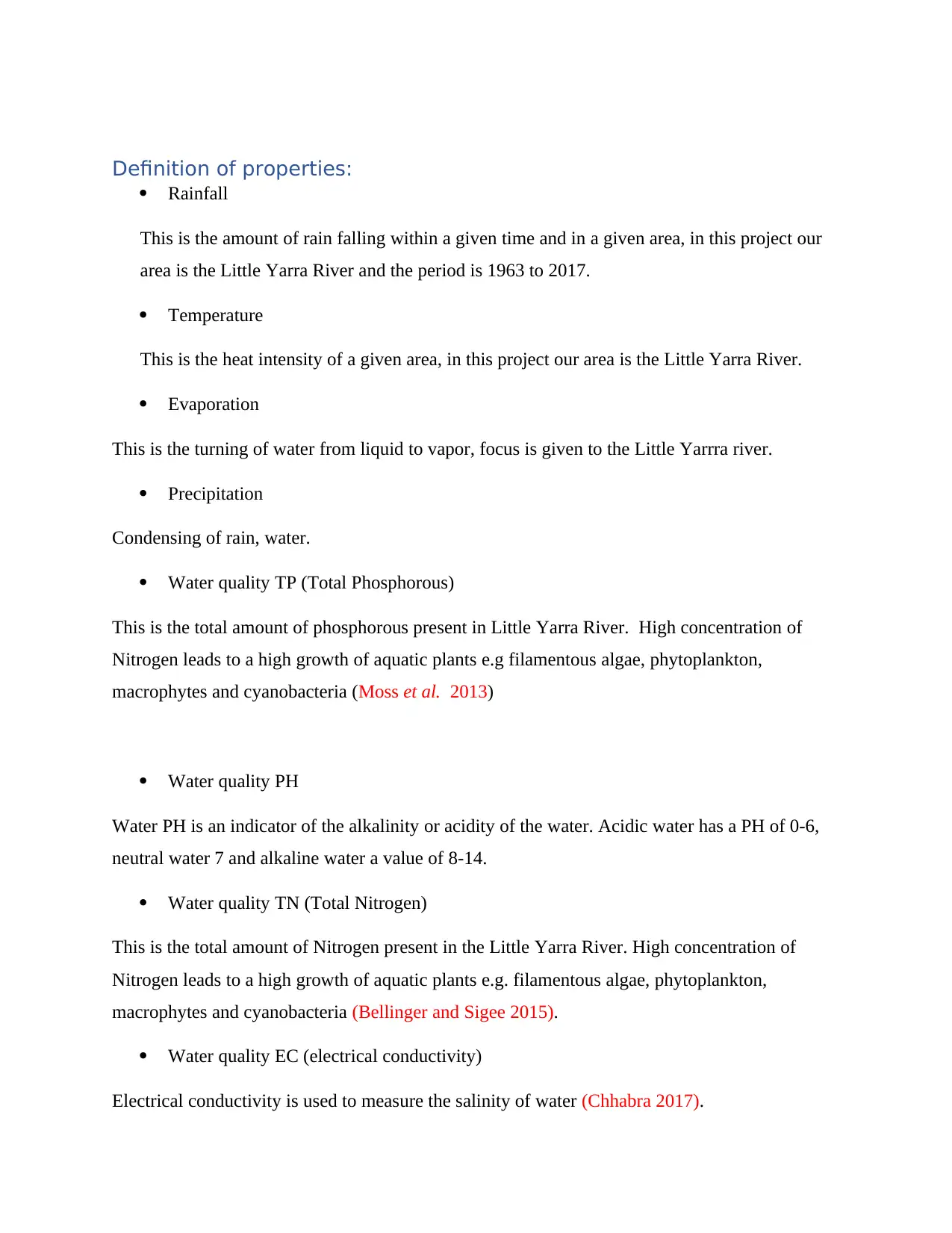
Definition of properties:
Rainfall
This is the amount of rain falling within a given time and in a given area, in this project our
area is the Little Yarra River and the period is 1963 to 2017.
Temperature
This is the heat intensity of a given area, in this project our area is the Little Yarra River.
Evaporation
This is the turning of water from liquid to vapor, focus is given to the Little Yarrra river.
Precipitation
Condensing of rain, water.
Water quality TP (Total Phosphorous)
This is the total amount of phosphorous present in Little Yarra River. High concentration of
Nitrogen leads to a high growth of aquatic plants e.g filamentous algae, phytoplankton,
macrophytes and cyanobacteria (Moss et al. 2013)
Water quality PH
Water PH is an indicator of the alkalinity or acidity of the water. Acidic water has a PH of 0-6,
neutral water 7 and alkaline water a value of 8-14.
Water quality TN (Total Nitrogen)
This is the total amount of Nitrogen present in the Little Yarra River. High concentration of
Nitrogen leads to a high growth of aquatic plants e.g. filamentous algae, phytoplankton,
macrophytes and cyanobacteria (Bellinger and Sigee 2015).
Water quality EC (electrical conductivity)
Electrical conductivity is used to measure the salinity of water (Chhabra 2017).
Rainfall
This is the amount of rain falling within a given time and in a given area, in this project our
area is the Little Yarra River and the period is 1963 to 2017.
Temperature
This is the heat intensity of a given area, in this project our area is the Little Yarra River.
Evaporation
This is the turning of water from liquid to vapor, focus is given to the Little Yarrra river.
Precipitation
Condensing of rain, water.
Water quality TP (Total Phosphorous)
This is the total amount of phosphorous present in Little Yarra River. High concentration of
Nitrogen leads to a high growth of aquatic plants e.g filamentous algae, phytoplankton,
macrophytes and cyanobacteria (Moss et al. 2013)
Water quality PH
Water PH is an indicator of the alkalinity or acidity of the water. Acidic water has a PH of 0-6,
neutral water 7 and alkaline water a value of 8-14.
Water quality TN (Total Nitrogen)
This is the total amount of Nitrogen present in the Little Yarra River. High concentration of
Nitrogen leads to a high growth of aquatic plants e.g. filamentous algae, phytoplankton,
macrophytes and cyanobacteria (Bellinger and Sigee 2015).
Water quality EC (electrical conductivity)
Electrical conductivity is used to measure the salinity of water (Chhabra 2017).
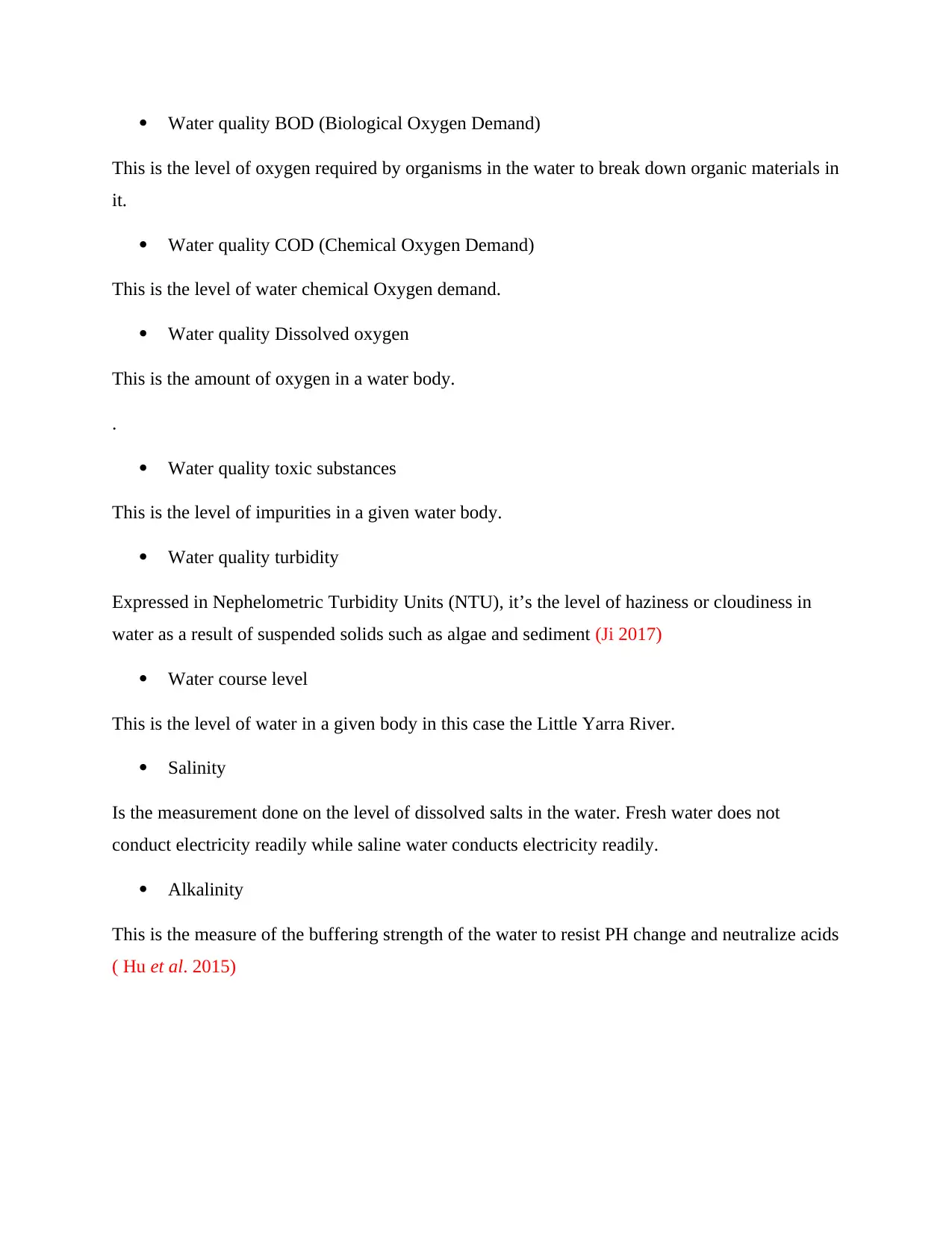
Water quality BOD (Biological Oxygen Demand)
This is the level of oxygen required by organisms in the water to break down organic materials in
it.
Water quality COD (Chemical Oxygen Demand)
This is the level of water chemical Oxygen demand.
Water quality Dissolved oxygen
This is the amount of oxygen in a water body.
.
Water quality toxic substances
This is the level of impurities in a given water body.
Water quality turbidity
Expressed in Nephelometric Turbidity Units (NTU), it’s the level of haziness or cloudiness in
water as a result of suspended solids such as algae and sediment (Ji 2017)
Water course level
This is the level of water in a given body in this case the Little Yarra River.
Salinity
Is the measurement done on the level of dissolved salts in the water. Fresh water does not
conduct electricity readily while saline water conducts electricity readily.
Alkalinity
This is the measure of the buffering strength of the water to resist PH change and neutralize acids
( Hu et al. 2015)
This is the level of oxygen required by organisms in the water to break down organic materials in
it.
Water quality COD (Chemical Oxygen Demand)
This is the level of water chemical Oxygen demand.
Water quality Dissolved oxygen
This is the amount of oxygen in a water body.
.
Water quality toxic substances
This is the level of impurities in a given water body.
Water quality turbidity
Expressed in Nephelometric Turbidity Units (NTU), it’s the level of haziness or cloudiness in
water as a result of suspended solids such as algae and sediment (Ji 2017)
Water course level
This is the level of water in a given body in this case the Little Yarra River.
Salinity
Is the measurement done on the level of dissolved salts in the water. Fresh water does not
conduct electricity readily while saline water conducts electricity readily.
Alkalinity
This is the measure of the buffering strength of the water to resist PH change and neutralize acids
( Hu et al. 2015)
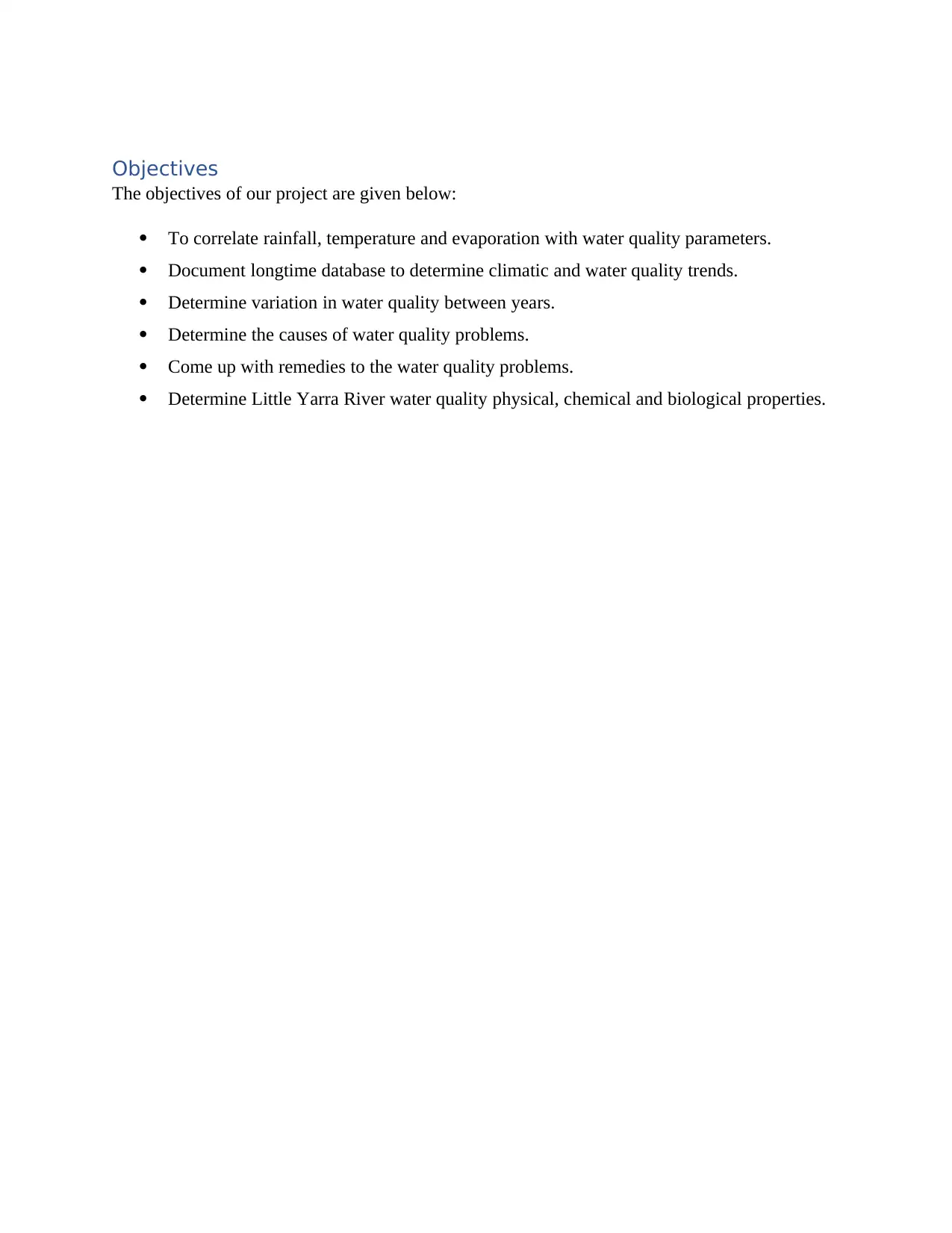
Objectives
The objectives of our project are given below:
To correlate rainfall, temperature and evaporation with water quality parameters.
Document longtime database to determine climatic and water quality trends.
Determine variation in water quality between years.
Determine the causes of water quality problems.
Come up with remedies to the water quality problems.
Determine Little Yarra River water quality physical, chemical and biological properties.
The objectives of our project are given below:
To correlate rainfall, temperature and evaporation with water quality parameters.
Document longtime database to determine climatic and water quality trends.
Determine variation in water quality between years.
Determine the causes of water quality problems.
Come up with remedies to the water quality problems.
Determine Little Yarra River water quality physical, chemical and biological properties.
Secure Best Marks with AI Grader
Need help grading? Try our AI Grader for instant feedback on your assignments.
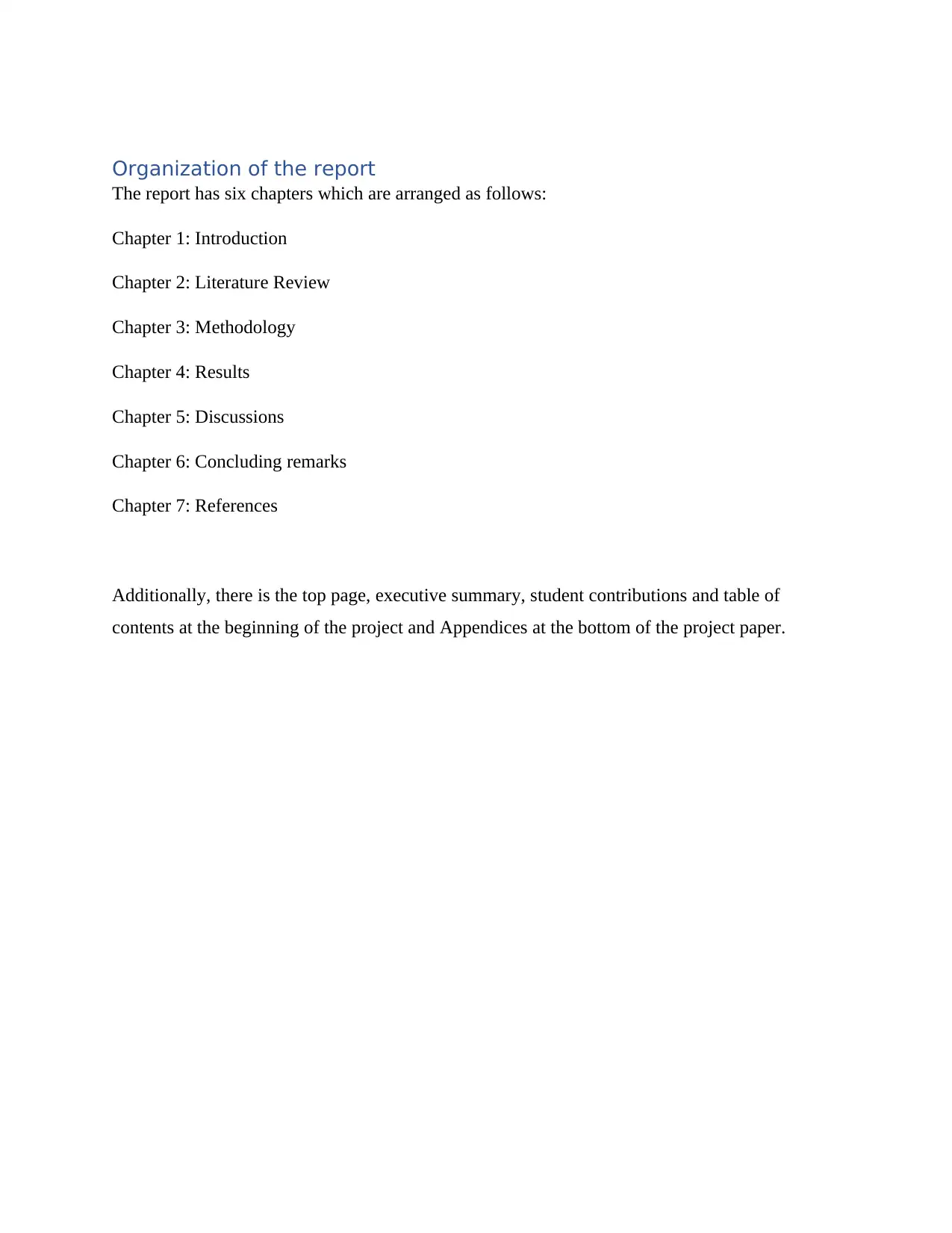
Organization of the report
The report has six chapters which are arranged as follows:
Chapter 1: Introduction
Chapter 2: Literature Review
Chapter 3: Methodology
Chapter 4: Results
Chapter 5: Discussions
Chapter 6: Concluding remarks
Chapter 7: References
Additionally, there is the top page, executive summary, student contributions and table of
contents at the beginning of the project and Appendices at the bottom of the project paper.
The report has six chapters which are arranged as follows:
Chapter 1: Introduction
Chapter 2: Literature Review
Chapter 3: Methodology
Chapter 4: Results
Chapter 5: Discussions
Chapter 6: Concluding remarks
Chapter 7: References
Additionally, there is the top page, executive summary, student contributions and table of
contents at the beginning of the project and Appendices at the bottom of the project paper.
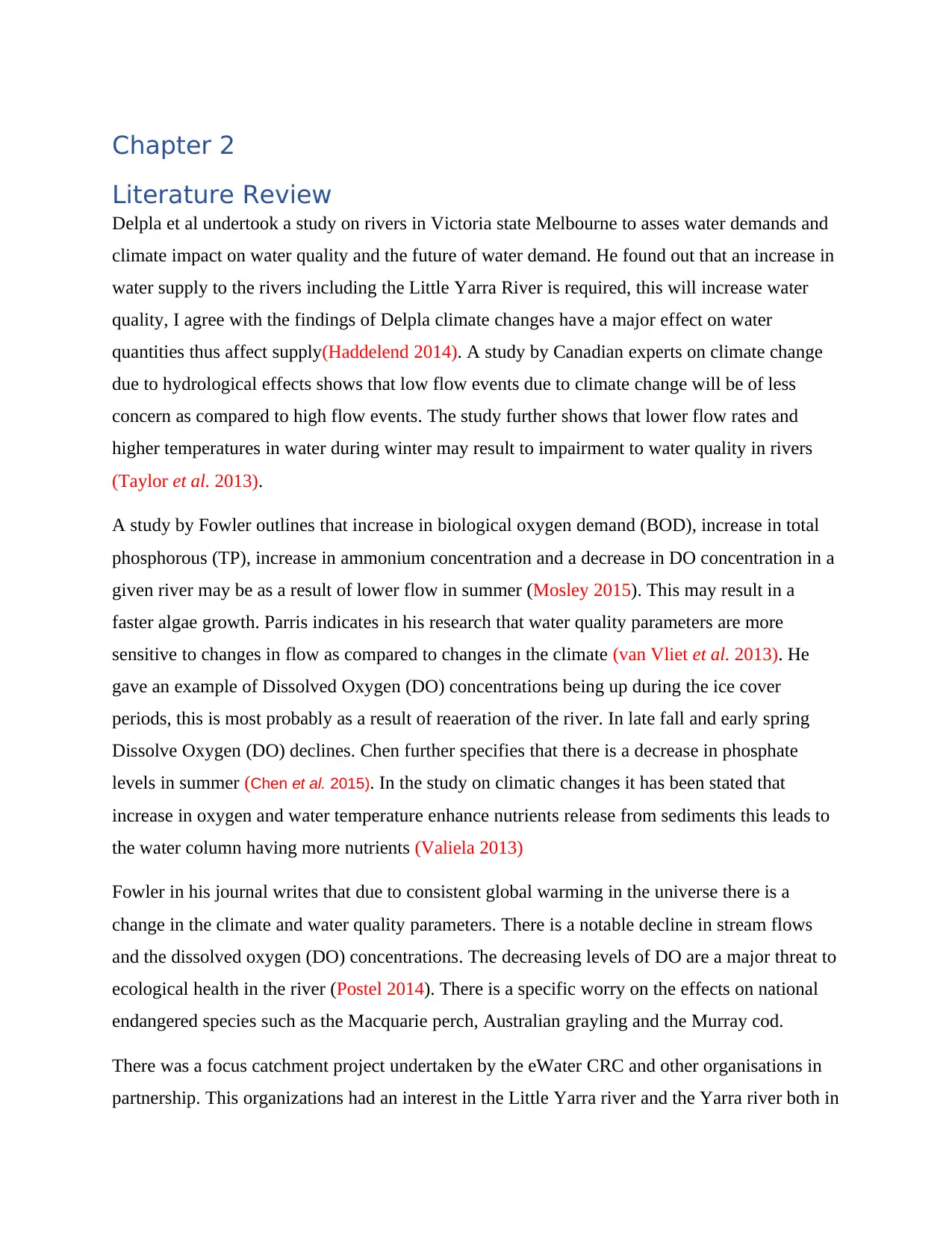
Chapter 2
Literature Review
Delpla et al undertook a study on rivers in Victoria state Melbourne to asses water demands and
climate impact on water quality and the future of water demand. He found out that an increase in
water supply to the rivers including the Little Yarra River is required, this will increase water
quality, I agree with the findings of Delpla climate changes have a major effect on water
quantities thus affect supply(Haddelend 2014). A study by Canadian experts on climate change
due to hydrological effects shows that low flow events due to climate change will be of less
concern as compared to high flow events. The study further shows that lower flow rates and
higher temperatures in water during winter may result to impairment to water quality in rivers
(Taylor et al. 2013).
A study by Fowler outlines that increase in biological oxygen demand (BOD), increase in total
phosphorous (TP), increase in ammonium concentration and a decrease in DO concentration in a
given river may be as a result of lower flow in summer (Mosley 2015). This may result in a
faster algae growth. Parris indicates in his research that water quality parameters are more
sensitive to changes in flow as compared to changes in the climate (van Vliet et al. 2013). He
gave an example of Dissolved Oxygen (DO) concentrations being up during the ice cover
periods, this is most probably as a result of reaeration of the river. In late fall and early spring
Dissolve Oxygen (DO) declines. Chen further specifies that there is a decrease in phosphate
levels in summer (Chen et al. 2015). In the study on climatic changes it has been stated that
increase in oxygen and water temperature enhance nutrients release from sediments this leads to
the water column having more nutrients (Valiela 2013)
Fowler in his journal writes that due to consistent global warming in the universe there is a
change in the climate and water quality parameters. There is a notable decline in stream flows
and the dissolved oxygen (DO) concentrations. The decreasing levels of DO are a major threat to
ecological health in the river (Postel 2014). There is a specific worry on the effects on national
endangered species such as the Macquarie perch, Australian grayling and the Murray cod.
There was a focus catchment project undertaken by the eWater CRC and other organisations in
partnership. This organizations had an interest in the Little Yarra river and the Yarra river both in
Literature Review
Delpla et al undertook a study on rivers in Victoria state Melbourne to asses water demands and
climate impact on water quality and the future of water demand. He found out that an increase in
water supply to the rivers including the Little Yarra River is required, this will increase water
quality, I agree with the findings of Delpla climate changes have a major effect on water
quantities thus affect supply(Haddelend 2014). A study by Canadian experts on climate change
due to hydrological effects shows that low flow events due to climate change will be of less
concern as compared to high flow events. The study further shows that lower flow rates and
higher temperatures in water during winter may result to impairment to water quality in rivers
(Taylor et al. 2013).
A study by Fowler outlines that increase in biological oxygen demand (BOD), increase in total
phosphorous (TP), increase in ammonium concentration and a decrease in DO concentration in a
given river may be as a result of lower flow in summer (Mosley 2015). This may result in a
faster algae growth. Parris indicates in his research that water quality parameters are more
sensitive to changes in flow as compared to changes in the climate (van Vliet et al. 2013). He
gave an example of Dissolved Oxygen (DO) concentrations being up during the ice cover
periods, this is most probably as a result of reaeration of the river. In late fall and early spring
Dissolve Oxygen (DO) declines. Chen further specifies that there is a decrease in phosphate
levels in summer (Chen et al. 2015). In the study on climatic changes it has been stated that
increase in oxygen and water temperature enhance nutrients release from sediments this leads to
the water column having more nutrients (Valiela 2013)
Fowler in his journal writes that due to consistent global warming in the universe there is a
change in the climate and water quality parameters. There is a notable decline in stream flows
and the dissolved oxygen (DO) concentrations. The decreasing levels of DO are a major threat to
ecological health in the river (Postel 2014). There is a specific worry on the effects on national
endangered species such as the Macquarie perch, Australian grayling and the Murray cod.
There was a focus catchment project undertaken by the eWater CRC and other organisations in
partnership. This organizations had an interest in the Little Yarra river and the Yarra river both in
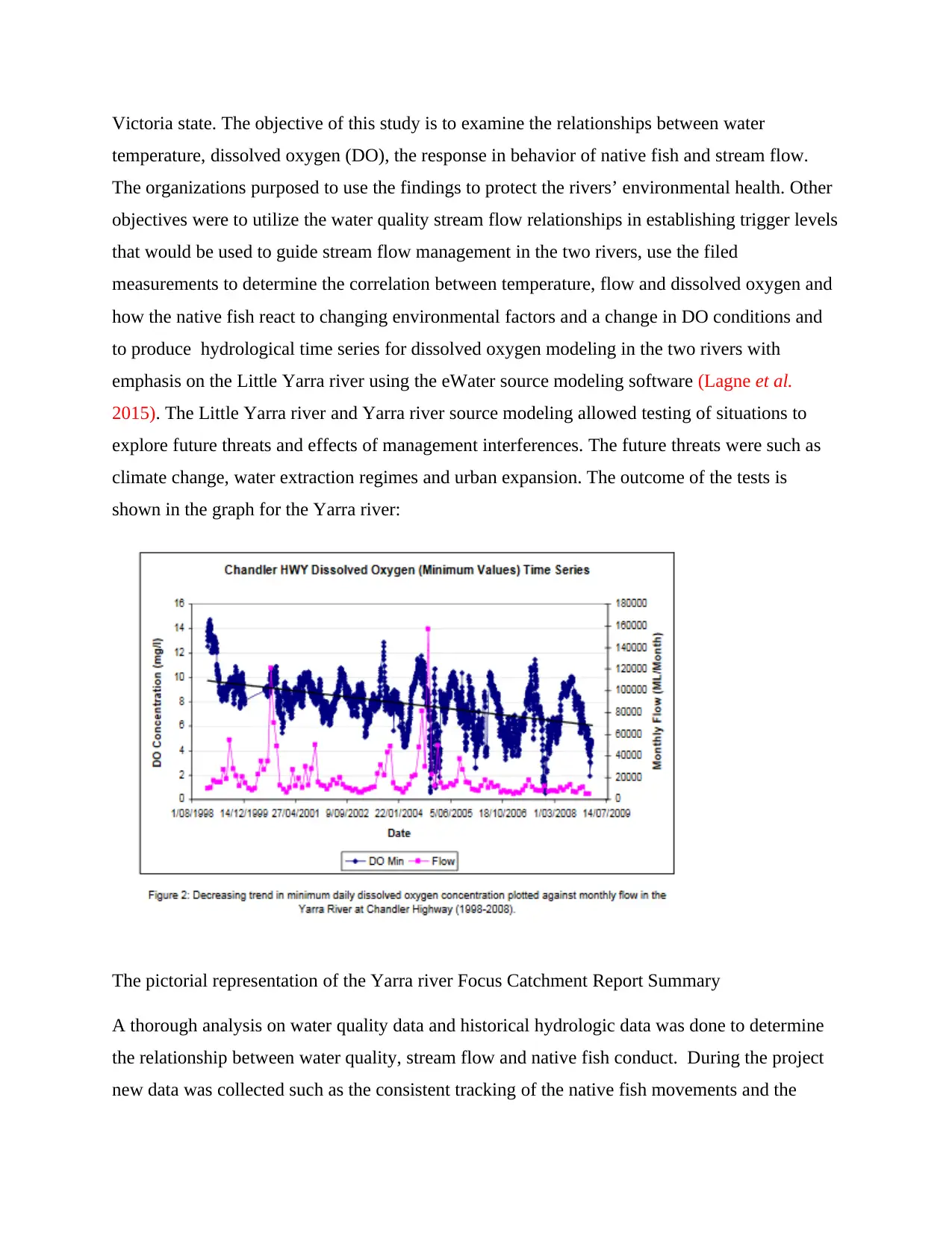
Victoria state. The objective of this study is to examine the relationships between water
temperature, dissolved oxygen (DO), the response in behavior of native fish and stream flow.
The organizations purposed to use the findings to protect the rivers’ environmental health. Other
objectives were to utilize the water quality stream flow relationships in establishing trigger levels
that would be used to guide stream flow management in the two rivers, use the filed
measurements to determine the correlation between temperature, flow and dissolved oxygen and
how the native fish react to changing environmental factors and a change in DO conditions and
to produce hydrological time series for dissolved oxygen modeling in the two rivers with
emphasis on the Little Yarra river using the eWater source modeling software (Lagne et al.
2015). The Little Yarra river and Yarra river source modeling allowed testing of situations to
explore future threats and effects of management interferences. The future threats were such as
climate change, water extraction regimes and urban expansion. The outcome of the tests is
shown in the graph for the Yarra river:
The pictorial representation of the Yarra river Focus Catchment Report Summary
A thorough analysis on water quality data and historical hydrologic data was done to determine
the relationship between water quality, stream flow and native fish conduct. During the project
new data was collected such as the consistent tracking of the native fish movements and the
temperature, dissolved oxygen (DO), the response in behavior of native fish and stream flow.
The organizations purposed to use the findings to protect the rivers’ environmental health. Other
objectives were to utilize the water quality stream flow relationships in establishing trigger levels
that would be used to guide stream flow management in the two rivers, use the filed
measurements to determine the correlation between temperature, flow and dissolved oxygen and
how the native fish react to changing environmental factors and a change in DO conditions and
to produce hydrological time series for dissolved oxygen modeling in the two rivers with
emphasis on the Little Yarra river using the eWater source modeling software (Lagne et al.
2015). The Little Yarra river and Yarra river source modeling allowed testing of situations to
explore future threats and effects of management interferences. The future threats were such as
climate change, water extraction regimes and urban expansion. The outcome of the tests is
shown in the graph for the Yarra river:
The pictorial representation of the Yarra river Focus Catchment Report Summary
A thorough analysis on water quality data and historical hydrologic data was done to determine
the relationship between water quality, stream flow and native fish conduct. During the project
new data was collected such as the consistent tracking of the native fish movements and the
Paraphrase This Document
Need a fresh take? Get an instant paraphrase of this document with our AI Paraphraser
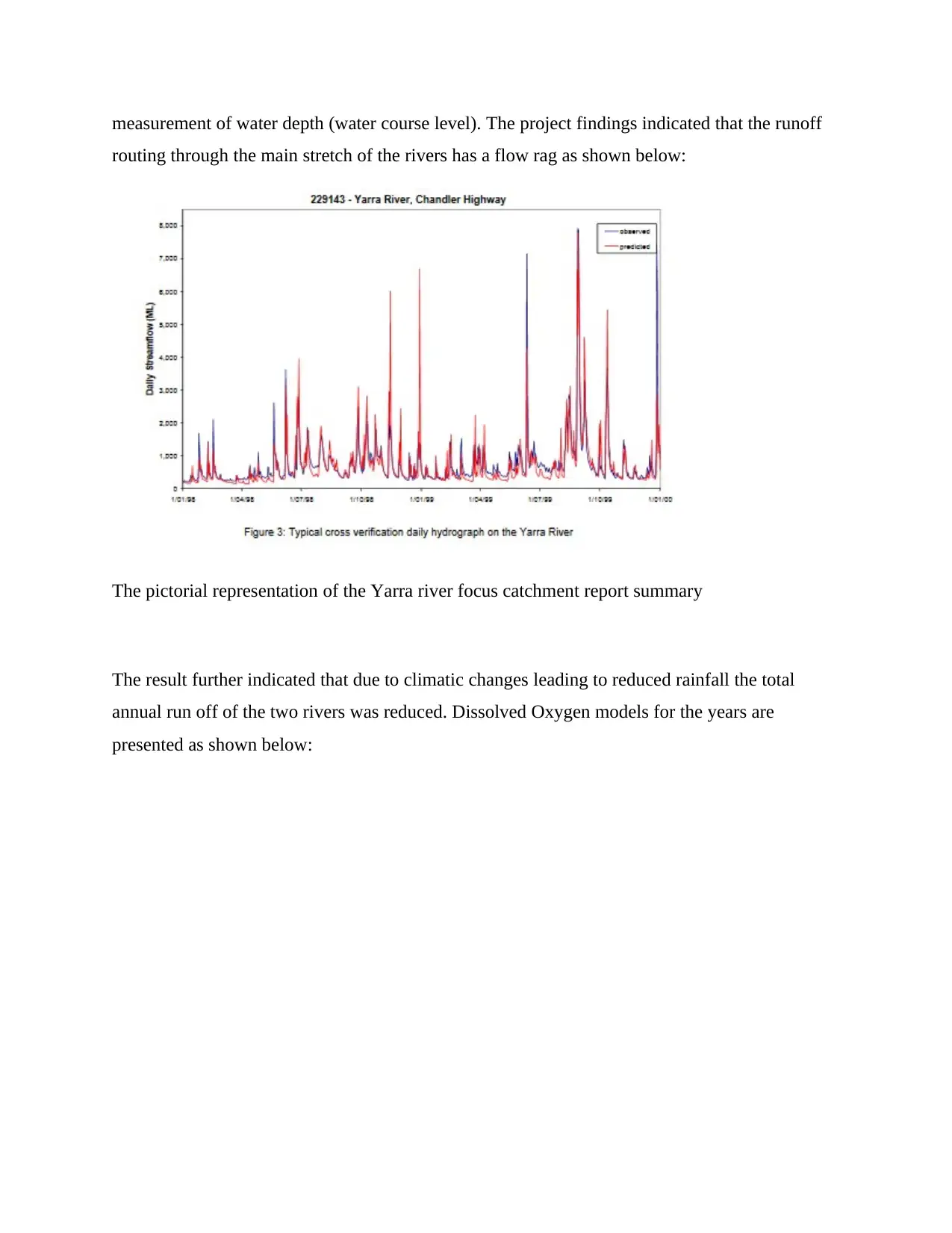
measurement of water depth (water course level). The project findings indicated that the runoff
routing through the main stretch of the rivers has a flow rag as shown below:
The pictorial representation of the Yarra river focus catchment report summary
The result further indicated that due to climatic changes leading to reduced rainfall the total
annual run off of the two rivers was reduced. Dissolved Oxygen models for the years are
presented as shown below:
routing through the main stretch of the rivers has a flow rag as shown below:
The pictorial representation of the Yarra river focus catchment report summary
The result further indicated that due to climatic changes leading to reduced rainfall the total
annual run off of the two rivers was reduced. Dissolved Oxygen models for the years are
presented as shown below:
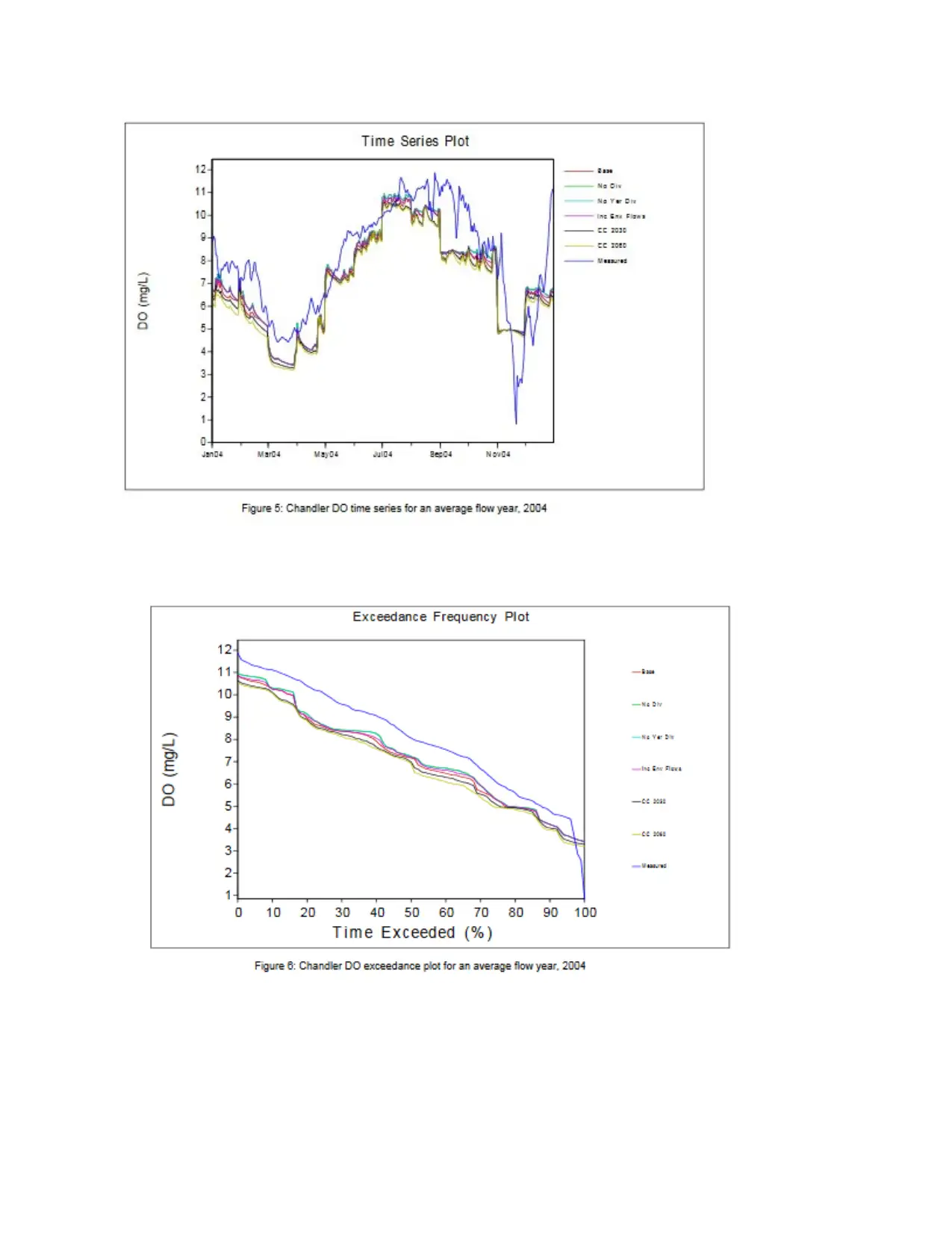
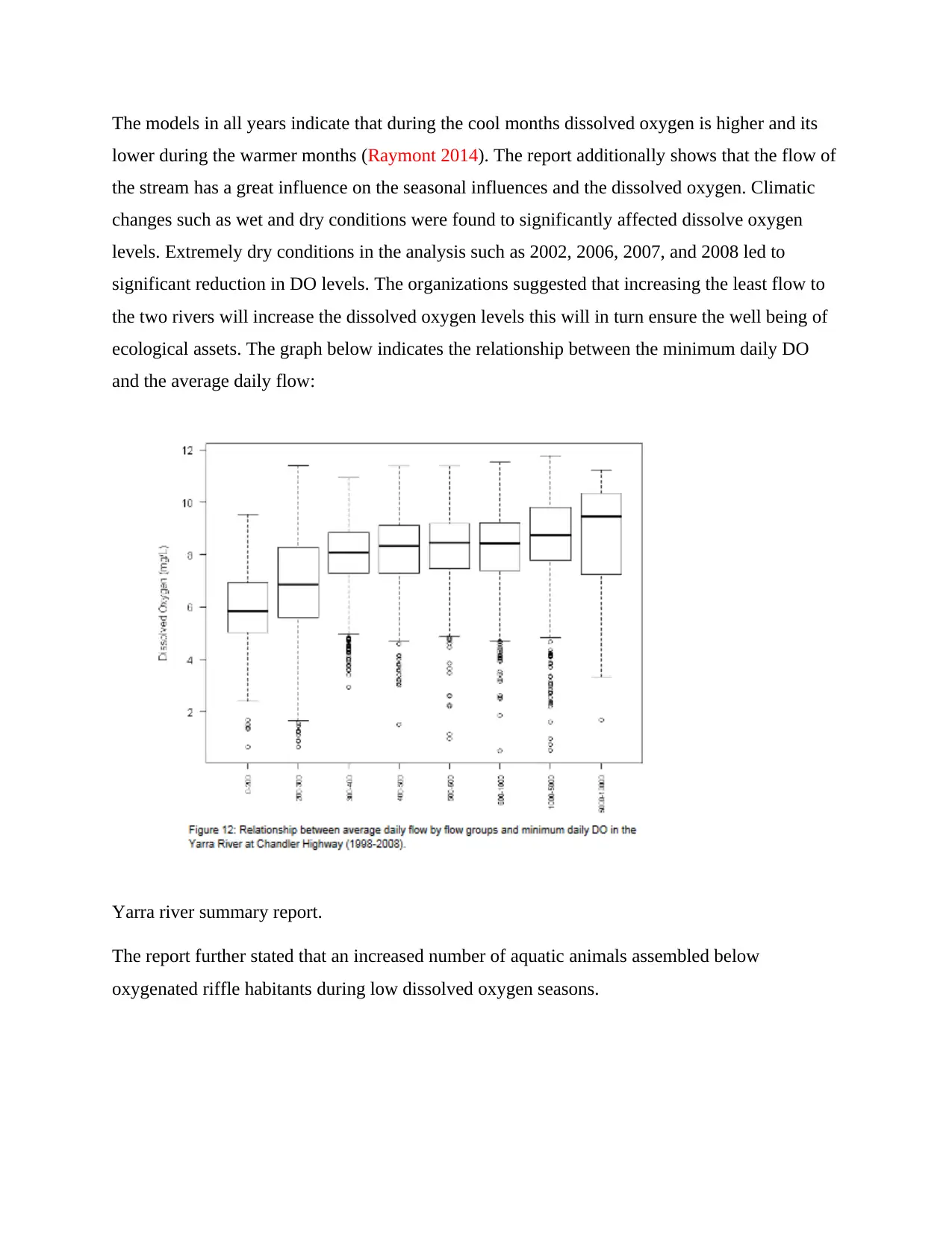
The models in all years indicate that during the cool months dissolved oxygen is higher and its
lower during the warmer months (Raymont 2014). The report additionally shows that the flow of
the stream has a great influence on the seasonal influences and the dissolved oxygen. Climatic
changes such as wet and dry conditions were found to significantly affected dissolve oxygen
levels. Extremely dry conditions in the analysis such as 2002, 2006, 2007, and 2008 led to
significant reduction in DO levels. The organizations suggested that increasing the least flow to
the two rivers will increase the dissolved oxygen levels this will in turn ensure the well being of
ecological assets. The graph below indicates the relationship between the minimum daily DO
and the average daily flow:
Yarra river summary report.
The report further stated that an increased number of aquatic animals assembled below
oxygenated riffle habitants during low dissolved oxygen seasons.
lower during the warmer months (Raymont 2014). The report additionally shows that the flow of
the stream has a great influence on the seasonal influences and the dissolved oxygen. Climatic
changes such as wet and dry conditions were found to significantly affected dissolve oxygen
levels. Extremely dry conditions in the analysis such as 2002, 2006, 2007, and 2008 led to
significant reduction in DO levels. The organizations suggested that increasing the least flow to
the two rivers will increase the dissolved oxygen levels this will in turn ensure the well being of
ecological assets. The graph below indicates the relationship between the minimum daily DO
and the average daily flow:
Yarra river summary report.
The report further stated that an increased number of aquatic animals assembled below
oxygenated riffle habitants during low dissolved oxygen seasons.
Secure Best Marks with AI Grader
Need help grading? Try our AI Grader for instant feedback on your assignments.
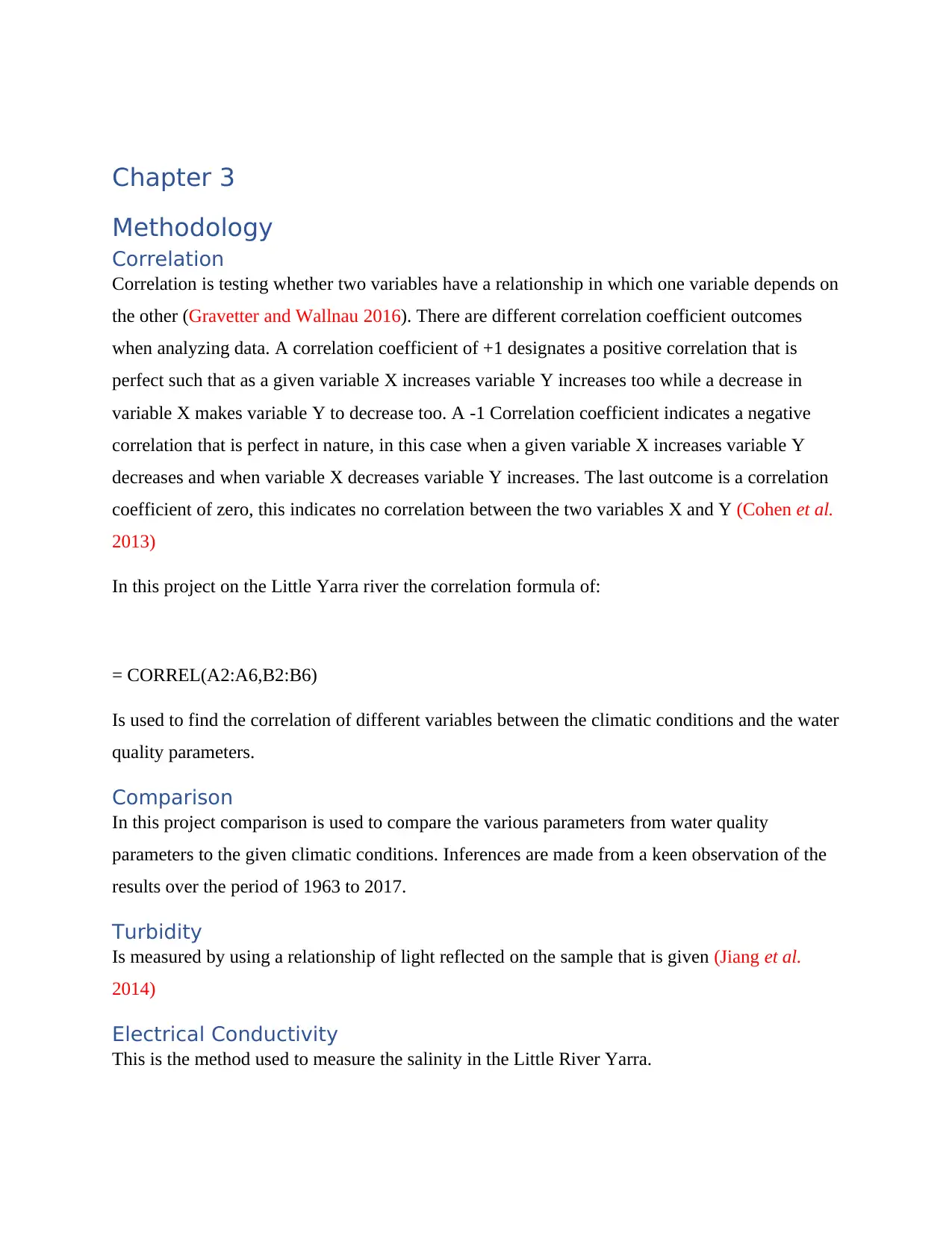
Chapter 3
Methodology
Correlation
Correlation is testing whether two variables have a relationship in which one variable depends on
the other (Gravetter and Wallnau 2016). There are different correlation coefficient outcomes
when analyzing data. A correlation coefficient of +1 designates a positive correlation that is
perfect such that as a given variable X increases variable Y increases too while a decrease in
variable X makes variable Y to decrease too. A -1 Correlation coefficient indicates a negative
correlation that is perfect in nature, in this case when a given variable X increases variable Y
decreases and when variable X decreases variable Y increases. The last outcome is a correlation
coefficient of zero, this indicates no correlation between the two variables X and Y (Cohen et al.
2013)
In this project on the Little Yarra river the correlation formula of:
= CORREL(A2:A6,B2:B6)
Is used to find the correlation of different variables between the climatic conditions and the water
quality parameters.
Comparison
In this project comparison is used to compare the various parameters from water quality
parameters to the given climatic conditions. Inferences are made from a keen observation of the
results over the period of 1963 to 2017.
Turbidity
Is measured by using a relationship of light reflected on the sample that is given (Jiang et al.
2014)
Electrical Conductivity
This is the method used to measure the salinity in the Little River Yarra.
Methodology
Correlation
Correlation is testing whether two variables have a relationship in which one variable depends on
the other (Gravetter and Wallnau 2016). There are different correlation coefficient outcomes
when analyzing data. A correlation coefficient of +1 designates a positive correlation that is
perfect such that as a given variable X increases variable Y increases too while a decrease in
variable X makes variable Y to decrease too. A -1 Correlation coefficient indicates a negative
correlation that is perfect in nature, in this case when a given variable X increases variable Y
decreases and when variable X decreases variable Y increases. The last outcome is a correlation
coefficient of zero, this indicates no correlation between the two variables X and Y (Cohen et al.
2013)
In this project on the Little Yarra river the correlation formula of:
= CORREL(A2:A6,B2:B6)
Is used to find the correlation of different variables between the climatic conditions and the water
quality parameters.
Comparison
In this project comparison is used to compare the various parameters from water quality
parameters to the given climatic conditions. Inferences are made from a keen observation of the
results over the period of 1963 to 2017.
Turbidity
Is measured by using a relationship of light reflected on the sample that is given (Jiang et al.
2014)
Electrical Conductivity
This is the method used to measure the salinity in the Little River Yarra.
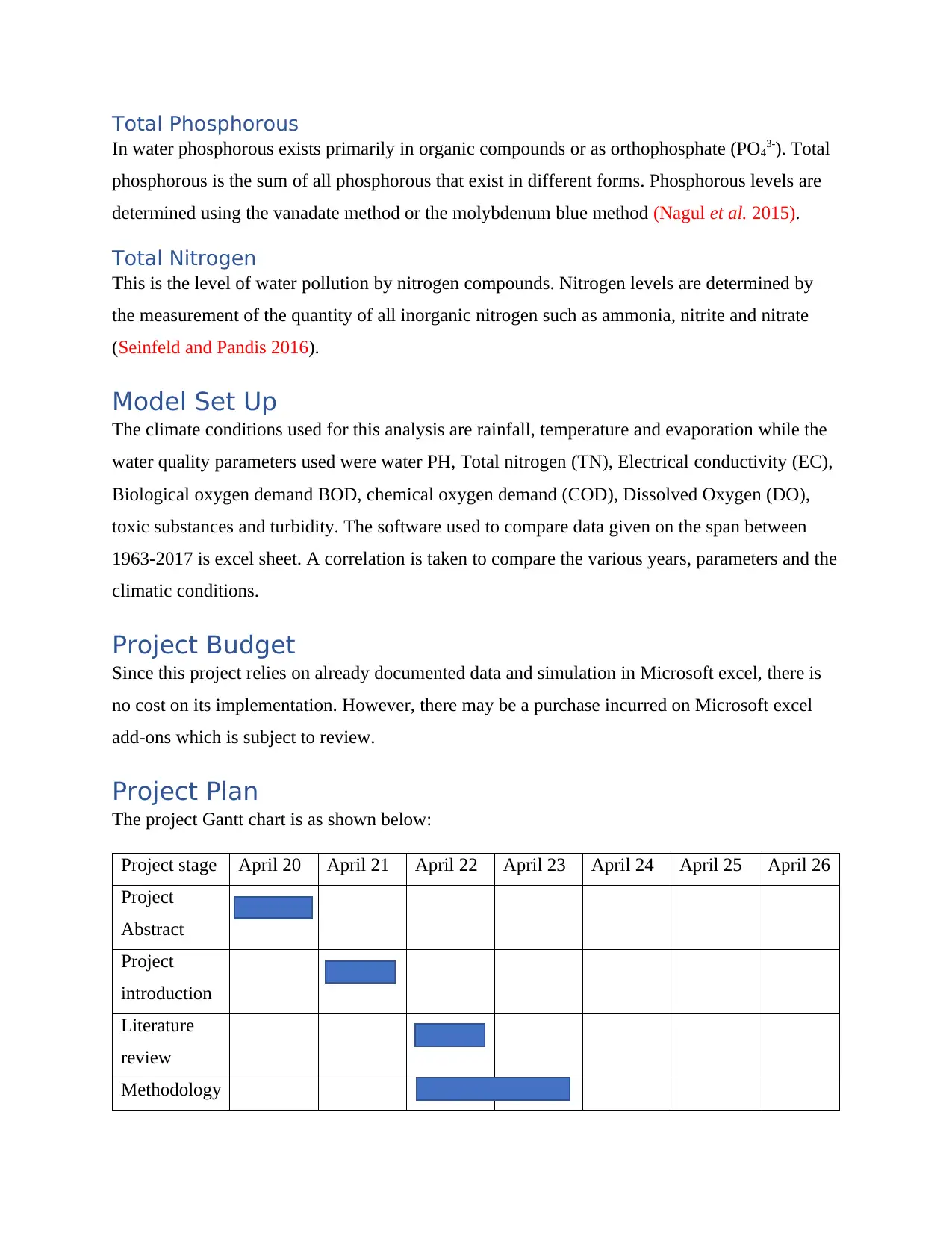
Total Phosphorous
In water phosphorous exists primarily in organic compounds or as orthophosphate (PO43-). Total
phosphorous is the sum of all phosphorous that exist in different forms. Phosphorous levels are
determined using the vanadate method or the molybdenum blue method (Nagul et al. 2015).
Total Nitrogen
This is the level of water pollution by nitrogen compounds. Nitrogen levels are determined by
the measurement of the quantity of all inorganic nitrogen such as ammonia, nitrite and nitrate
(Seinfeld and Pandis 2016).
Model Set Up
The climate conditions used for this analysis are rainfall, temperature and evaporation while the
water quality parameters used were water PH, Total nitrogen (TN), Electrical conductivity (EC),
Biological oxygen demand BOD, chemical oxygen demand (COD), Dissolved Oxygen (DO),
toxic substances and turbidity. The software used to compare data given on the span between
1963-2017 is excel sheet. A correlation is taken to compare the various years, parameters and the
climatic conditions.
Project Budget
Since this project relies on already documented data and simulation in Microsoft excel, there is
no cost on its implementation. However, there may be a purchase incurred on Microsoft excel
add-ons which is subject to review.
Project Plan
The project Gantt chart is as shown below:
Project stage April 20 April 21 April 22 April 23 April 24 April 25 April 26
Project
Abstract
Project
introduction
Literature
review
Methodology
In water phosphorous exists primarily in organic compounds or as orthophosphate (PO43-). Total
phosphorous is the sum of all phosphorous that exist in different forms. Phosphorous levels are
determined using the vanadate method or the molybdenum blue method (Nagul et al. 2015).
Total Nitrogen
This is the level of water pollution by nitrogen compounds. Nitrogen levels are determined by
the measurement of the quantity of all inorganic nitrogen such as ammonia, nitrite and nitrate
(Seinfeld and Pandis 2016).
Model Set Up
The climate conditions used for this analysis are rainfall, temperature and evaporation while the
water quality parameters used were water PH, Total nitrogen (TN), Electrical conductivity (EC),
Biological oxygen demand BOD, chemical oxygen demand (COD), Dissolved Oxygen (DO),
toxic substances and turbidity. The software used to compare data given on the span between
1963-2017 is excel sheet. A correlation is taken to compare the various years, parameters and the
climatic conditions.
Project Budget
Since this project relies on already documented data and simulation in Microsoft excel, there is
no cost on its implementation. However, there may be a purchase incurred on Microsoft excel
add-ons which is subject to review.
Project Plan
The project Gantt chart is as shown below:
Project stage April 20 April 21 April 22 April 23 April 24 April 25 April 26
Project
Abstract
Project
introduction
Literature
review
Methodology
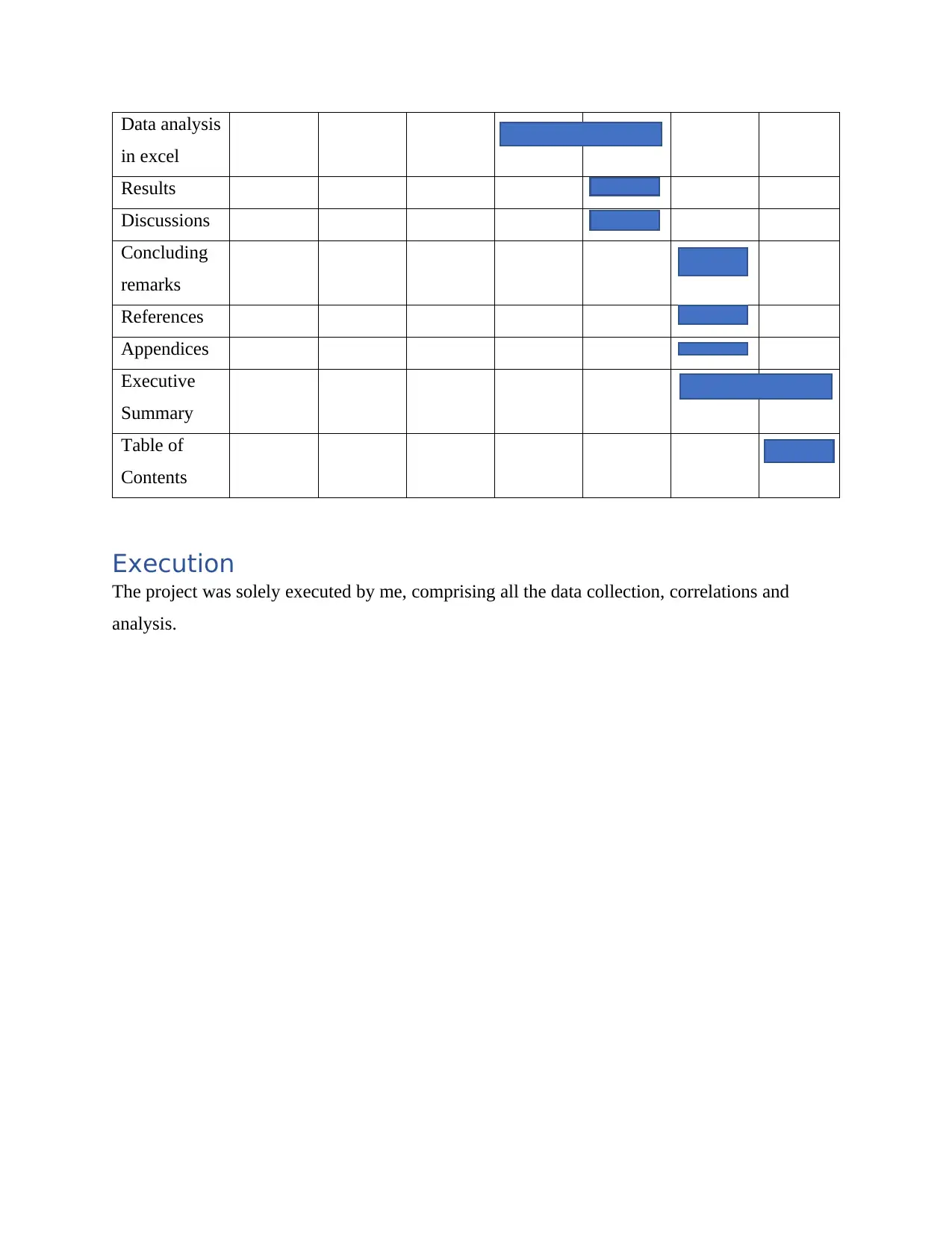
Data analysis
in excel
Results
Discussions
Concluding
remarks
References
Appendices
Executive
Summary
Table of
Contents
Execution
The project was solely executed by me, comprising all the data collection, correlations and
analysis.
in excel
Results
Discussions
Concluding
remarks
References
Appendices
Executive
Summary
Table of
Contents
Execution
The project was solely executed by me, comprising all the data collection, correlations and
analysis.
Paraphrase This Document
Need a fresh take? Get an instant paraphrase of this document with our AI Paraphraser
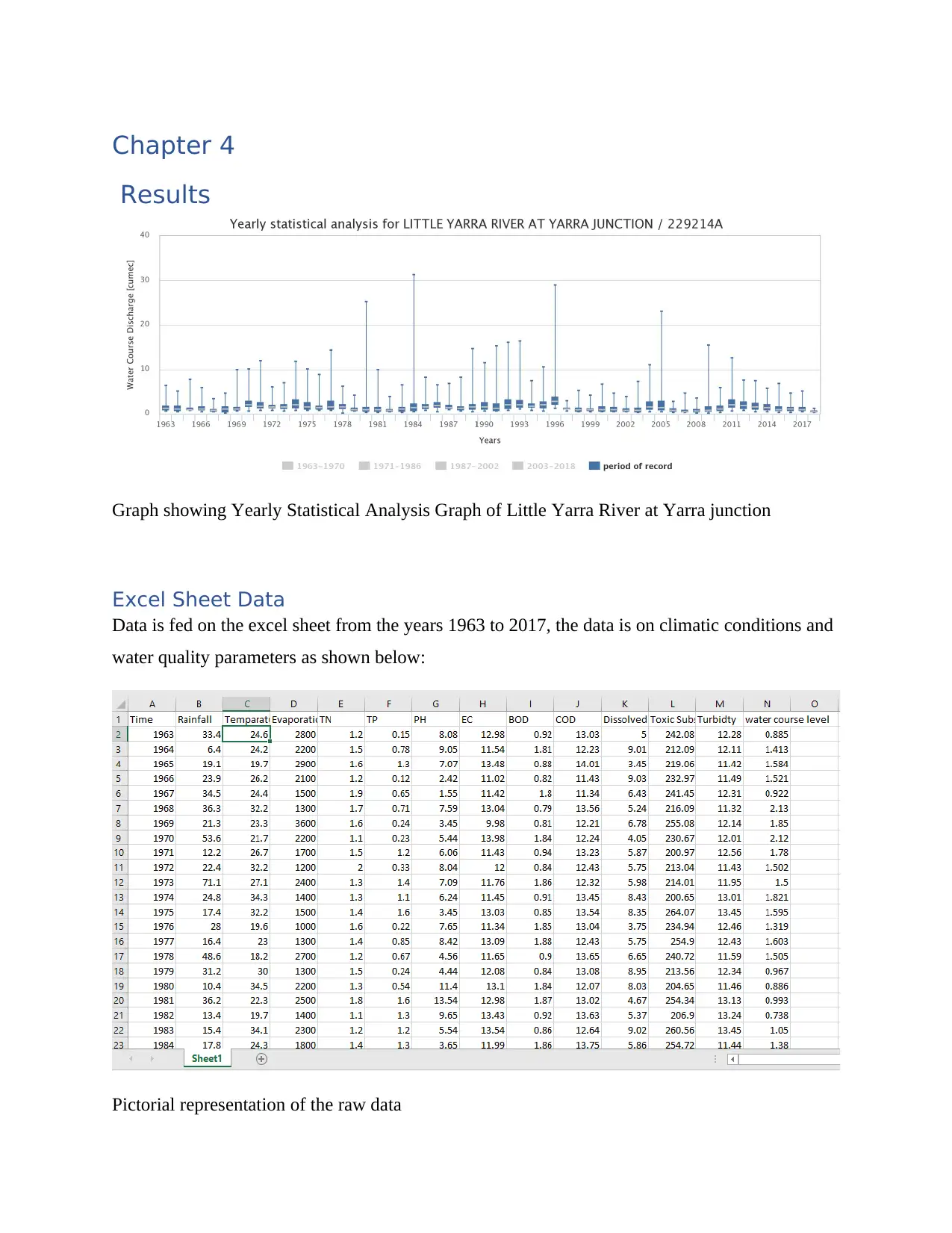
Chapter 4
Results
Graph showing Yearly Statistical Analysis Graph of Little Yarra River at Yarra junction
Excel Sheet Data
Data is fed on the excel sheet from the years 1963 to 2017, the data is on climatic conditions and
water quality parameters as shown below:
Pictorial representation of the raw data
Results
Graph showing Yearly Statistical Analysis Graph of Little Yarra River at Yarra junction
Excel Sheet Data
Data is fed on the excel sheet from the years 1963 to 2017, the data is on climatic conditions and
water quality parameters as shown below:
Pictorial representation of the raw data
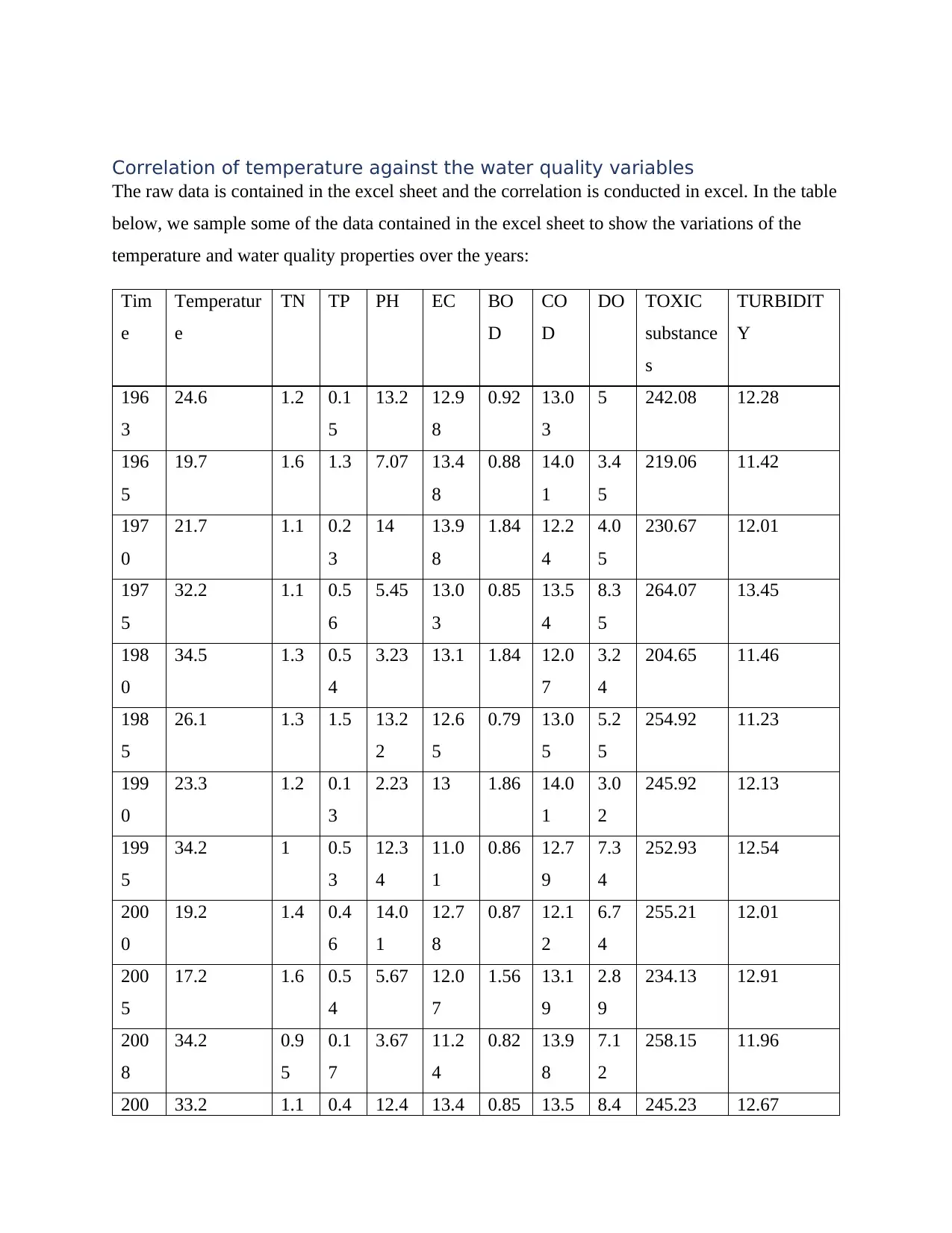
Correlation of temperature against the water quality variables
The raw data is contained in the excel sheet and the correlation is conducted in excel. In the table
below, we sample some of the data contained in the excel sheet to show the variations of the
temperature and water quality properties over the years:
Tim
e
Temperatur
e
TN TP PH EC BO
D
CO
D
DO TOXIC
substance
s
TURBIDIT
Y
196
3
24.6 1.2 0.1
5
13.2 12.9
8
0.92 13.0
3
5 242.08 12.28
196
5
19.7 1.6 1.3 7.07 13.4
8
0.88 14.0
1
3.4
5
219.06 11.42
197
0
21.7 1.1 0.2
3
14 13.9
8
1.84 12.2
4
4.0
5
230.67 12.01
197
5
32.2 1.1 0.5
6
5.45 13.0
3
0.85 13.5
4
8.3
5
264.07 13.45
198
0
34.5 1.3 0.5
4
3.23 13.1 1.84 12.0
7
3.2
4
204.65 11.46
198
5
26.1 1.3 1.5 13.2
2
12.6
5
0.79 13.0
5
5.2
5
254.92 11.23
199
0
23.3 1.2 0.1
3
2.23 13 1.86 14.0
1
3.0
2
245.92 12.13
199
5
34.2 1 0.5
3
12.3
4
11.0
1
0.86 12.7
9
7.3
4
252.93 12.54
200
0
19.2 1.4 0.4
6
14.0
1
12.7
8
0.87 12.1
2
6.7
4
255.21 12.01
200
5
17.2 1.6 0.5
4
5.67 12.0
7
1.56 13.1
9
2.8
9
234.13 12.91
200
8
34.2 0.9
5
0.1
7
3.67 11.2
4
0.82 13.9
8
7.1
2
258.15 11.96
200 33.2 1.1 0.4 12.4 13.4 0.85 13.5 8.4 245.23 12.67
The raw data is contained in the excel sheet and the correlation is conducted in excel. In the table
below, we sample some of the data contained in the excel sheet to show the variations of the
temperature and water quality properties over the years:
Tim
e
Temperatur
e
TN TP PH EC BO
D
CO
D
DO TOXIC
substance
s
TURBIDIT
Y
196
3
24.6 1.2 0.1
5
13.2 12.9
8
0.92 13.0
3
5 242.08 12.28
196
5
19.7 1.6 1.3 7.07 13.4
8
0.88 14.0
1
3.4
5
219.06 11.42
197
0
21.7 1.1 0.2
3
14 13.9
8
1.84 12.2
4
4.0
5
230.67 12.01
197
5
32.2 1.1 0.5
6
5.45 13.0
3
0.85 13.5
4
8.3
5
264.07 13.45
198
0
34.5 1.3 0.5
4
3.23 13.1 1.84 12.0
7
3.2
4
204.65 11.46
198
5
26.1 1.3 1.5 13.2
2
12.6
5
0.79 13.0
5
5.2
5
254.92 11.23
199
0
23.3 1.2 0.1
3
2.23 13 1.86 14.0
1
3.0
2
245.92 12.13
199
5
34.2 1 0.5
3
12.3
4
11.0
1
0.86 12.7
9
7.3
4
252.93 12.54
200
0
19.2 1.4 0.4
6
14.0
1
12.7
8
0.87 12.1
2
6.7
4
255.21 12.01
200
5
17.2 1.6 0.5
4
5.67 12.0
7
1.56 13.1
9
2.8
9
234.13 12.91
200
8
34.2 0.9
5
0.1
7
3.67 11.2
4
0.82 13.9
8
7.1
2
258.15 11.96
200 33.2 1.1 0.4 12.4 13.4 0.85 13.5 8.4 245.23 12.67
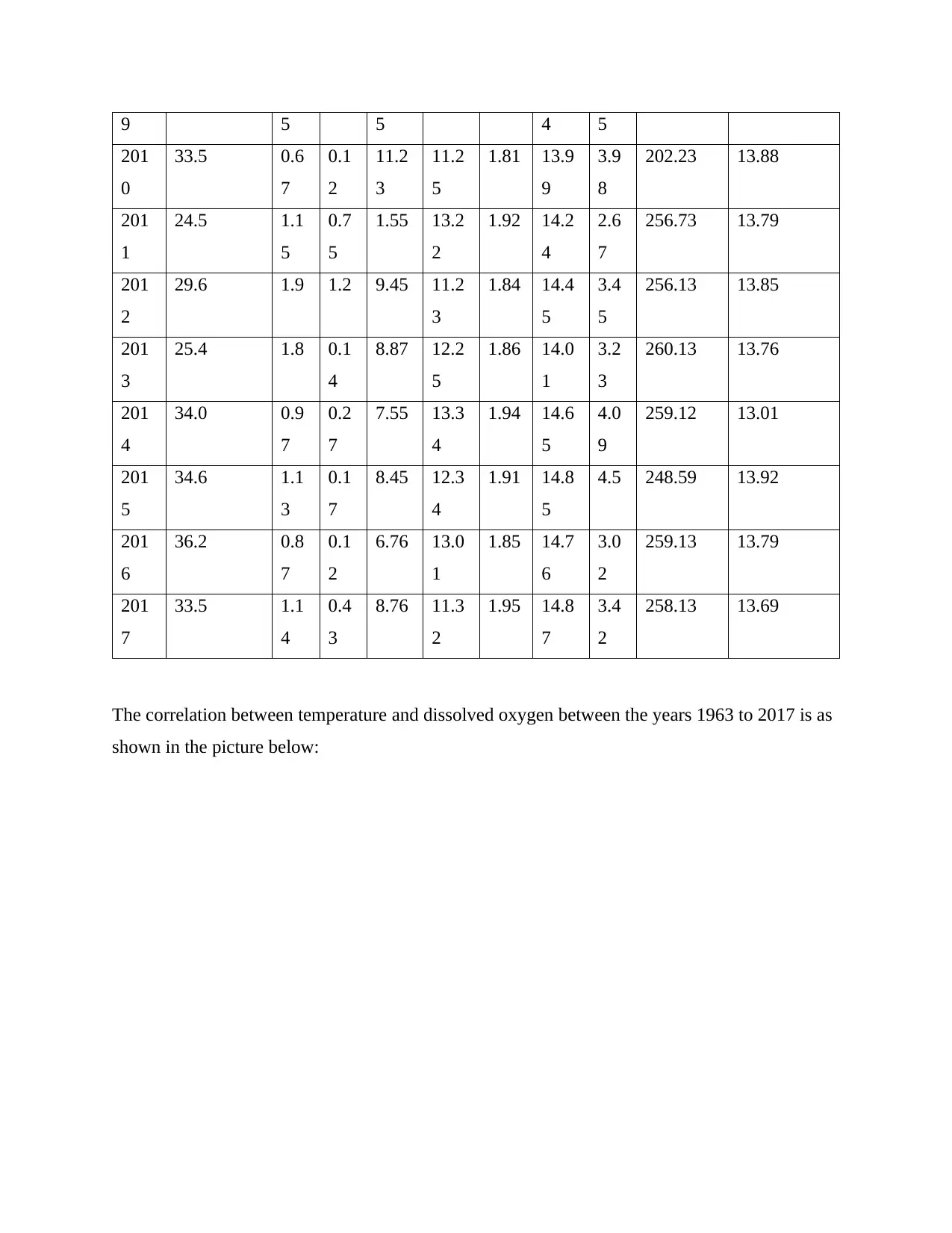
9 5 5 4 5
201
0
33.5 0.6
7
0.1
2
11.2
3
11.2
5
1.81 13.9
9
3.9
8
202.23 13.88
201
1
24.5 1.1
5
0.7
5
1.55 13.2
2
1.92 14.2
4
2.6
7
256.73 13.79
201
2
29.6 1.9 1.2 9.45 11.2
3
1.84 14.4
5
3.4
5
256.13 13.85
201
3
25.4 1.8 0.1
4
8.87 12.2
5
1.86 14.0
1
3.2
3
260.13 13.76
201
4
34.0 0.9
7
0.2
7
7.55 13.3
4
1.94 14.6
5
4.0
9
259.12 13.01
201
5
34.6 1.1
3
0.1
7
8.45 12.3
4
1.91 14.8
5
4.5 248.59 13.92
201
6
36.2 0.8
7
0.1
2
6.76 13.0
1
1.85 14.7
6
3.0
2
259.13 13.79
201
7
33.5 1.1
4
0.4
3
8.76 11.3
2
1.95 14.8
7
3.4
2
258.13 13.69
The correlation between temperature and dissolved oxygen between the years 1963 to 2017 is as
shown in the picture below:
201
0
33.5 0.6
7
0.1
2
11.2
3
11.2
5
1.81 13.9
9
3.9
8
202.23 13.88
201
1
24.5 1.1
5
0.7
5
1.55 13.2
2
1.92 14.2
4
2.6
7
256.73 13.79
201
2
29.6 1.9 1.2 9.45 11.2
3
1.84 14.4
5
3.4
5
256.13 13.85
201
3
25.4 1.8 0.1
4
8.87 12.2
5
1.86 14.0
1
3.2
3
260.13 13.76
201
4
34.0 0.9
7
0.2
7
7.55 13.3
4
1.94 14.6
5
4.0
9
259.12 13.01
201
5
34.6 1.1
3
0.1
7
8.45 12.3
4
1.91 14.8
5
4.5 248.59 13.92
201
6
36.2 0.8
7
0.1
2
6.76 13.0
1
1.85 14.7
6
3.0
2
259.13 13.79
201
7
33.5 1.1
4
0.4
3
8.76 11.3
2
1.95 14.8
7
3.4
2
258.13 13.69
The correlation between temperature and dissolved oxygen between the years 1963 to 2017 is as
shown in the picture below:
Secure Best Marks with AI Grader
Need help grading? Try our AI Grader for instant feedback on your assignments.
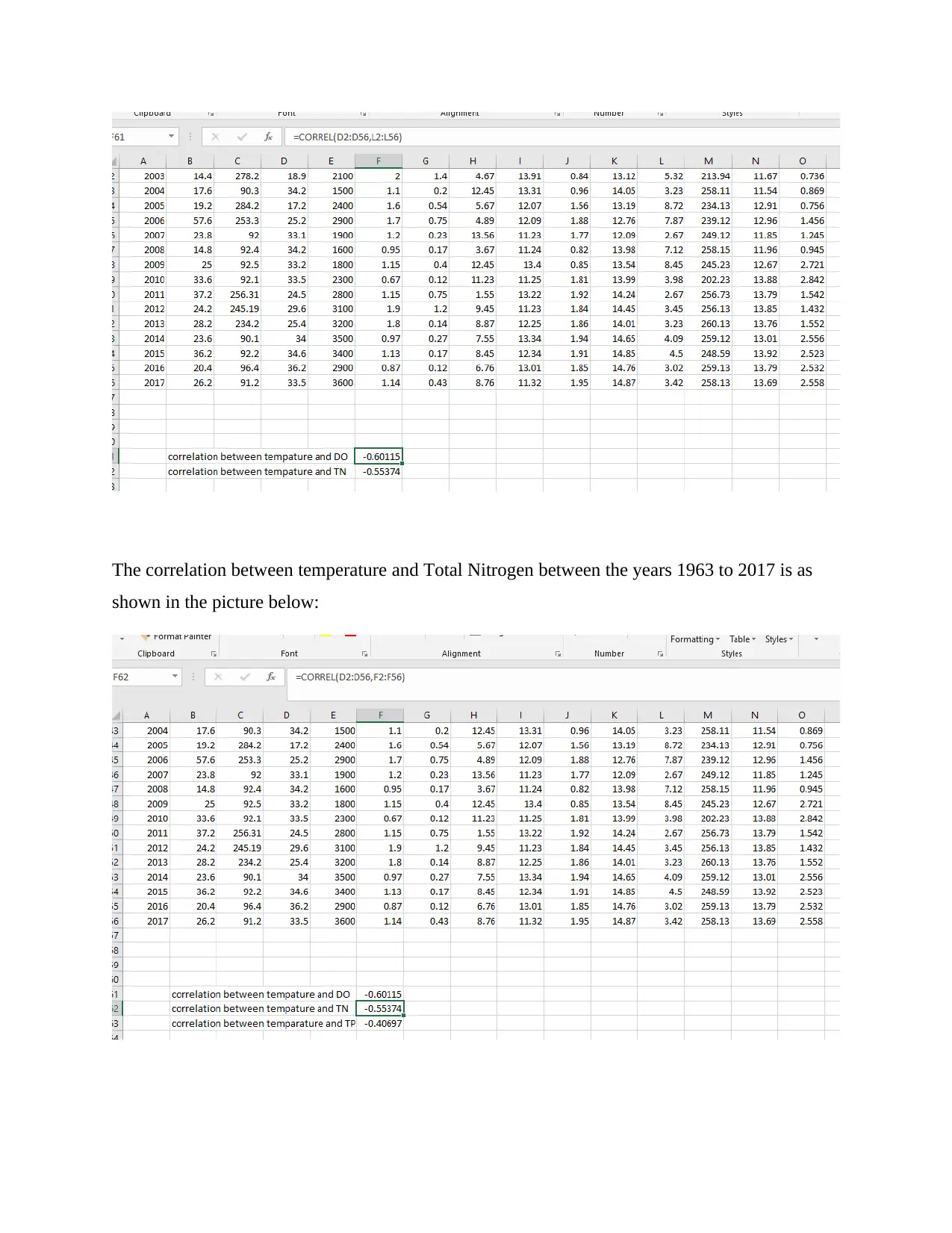
The correlation between temperature and Total Nitrogen between the years 1963 to 2017 is as
shown in the picture below:
shown in the picture below:
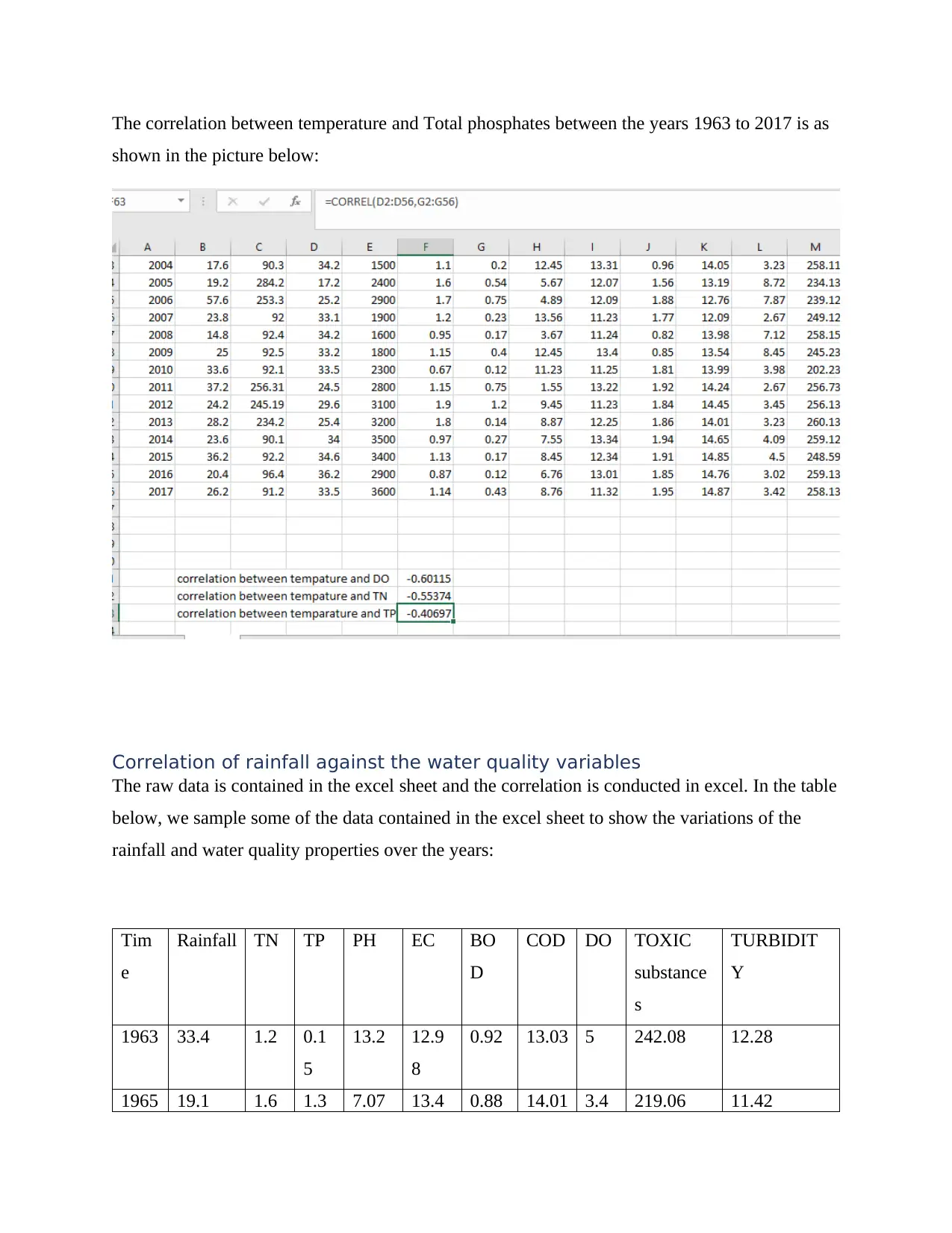
The correlation between temperature and Total phosphates between the years 1963 to 2017 is as
shown in the picture below:
Correlation of rainfall against the water quality variables
The raw data is contained in the excel sheet and the correlation is conducted in excel. In the table
below, we sample some of the data contained in the excel sheet to show the variations of the
rainfall and water quality properties over the years:
Tim
e
Rainfall TN TP PH EC BO
D
COD DO TOXIC
substance
s
TURBIDIT
Y
1963 33.4 1.2 0.1
5
13.2 12.9
8
0.92 13.03 5 242.08 12.28
1965 19.1 1.6 1.3 7.07 13.4 0.88 14.01 3.4 219.06 11.42
shown in the picture below:
Correlation of rainfall against the water quality variables
The raw data is contained in the excel sheet and the correlation is conducted in excel. In the table
below, we sample some of the data contained in the excel sheet to show the variations of the
rainfall and water quality properties over the years:
Tim
e
Rainfall TN TP PH EC BO
D
COD DO TOXIC
substance
s
TURBIDIT
Y
1963 33.4 1.2 0.1
5
13.2 12.9
8
0.92 13.03 5 242.08 12.28
1965 19.1 1.6 1.3 7.07 13.4 0.88 14.01 3.4 219.06 11.42
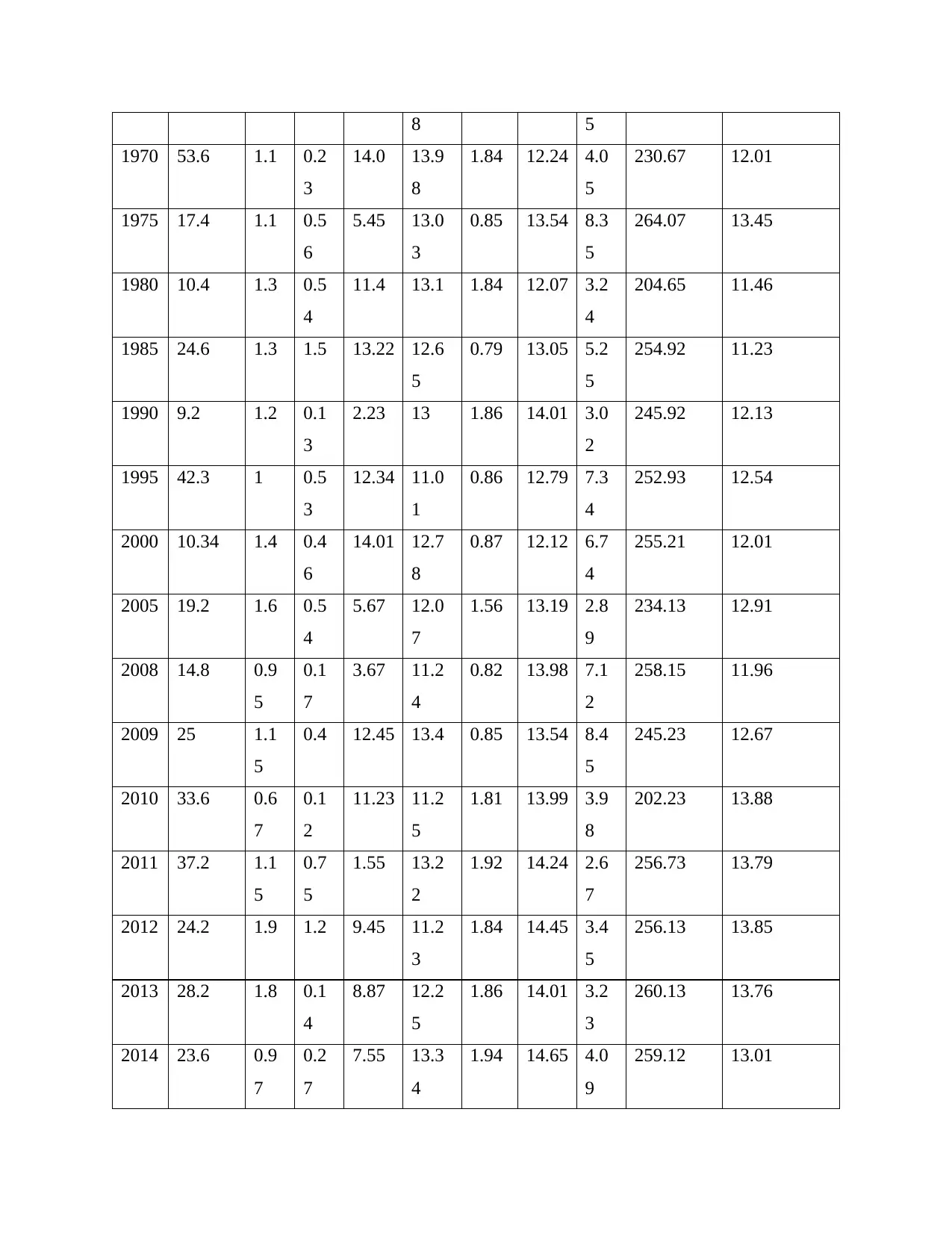
8 5
1970 53.6 1.1 0.2
3
14.0 13.9
8
1.84 12.24 4.0
5
230.67 12.01
1975 17.4 1.1 0.5
6
5.45 13.0
3
0.85 13.54 8.3
5
264.07 13.45
1980 10.4 1.3 0.5
4
11.4 13.1 1.84 12.07 3.2
4
204.65 11.46
1985 24.6 1.3 1.5 13.22 12.6
5
0.79 13.05 5.2
5
254.92 11.23
1990 9.2 1.2 0.1
3
2.23 13 1.86 14.01 3.0
2
245.92 12.13
1995 42.3 1 0.5
3
12.34 11.0
1
0.86 12.79 7.3
4
252.93 12.54
2000 10.34 1.4 0.4
6
14.01 12.7
8
0.87 12.12 6.7
4
255.21 12.01
2005 19.2 1.6 0.5
4
5.67 12.0
7
1.56 13.19 2.8
9
234.13 12.91
2008 14.8 0.9
5
0.1
7
3.67 11.2
4
0.82 13.98 7.1
2
258.15 11.96
2009 25 1.1
5
0.4 12.45 13.4 0.85 13.54 8.4
5
245.23 12.67
2010 33.6 0.6
7
0.1
2
11.23 11.2
5
1.81 13.99 3.9
8
202.23 13.88
2011 37.2 1.1
5
0.7
5
1.55 13.2
2
1.92 14.24 2.6
7
256.73 13.79
2012 24.2 1.9 1.2 9.45 11.2
3
1.84 14.45 3.4
5
256.13 13.85
2013 28.2 1.8 0.1
4
8.87 12.2
5
1.86 14.01 3.2
3
260.13 13.76
2014 23.6 0.9
7
0.2
7
7.55 13.3
4
1.94 14.65 4.0
9
259.12 13.01
1970 53.6 1.1 0.2
3
14.0 13.9
8
1.84 12.24 4.0
5
230.67 12.01
1975 17.4 1.1 0.5
6
5.45 13.0
3
0.85 13.54 8.3
5
264.07 13.45
1980 10.4 1.3 0.5
4
11.4 13.1 1.84 12.07 3.2
4
204.65 11.46
1985 24.6 1.3 1.5 13.22 12.6
5
0.79 13.05 5.2
5
254.92 11.23
1990 9.2 1.2 0.1
3
2.23 13 1.86 14.01 3.0
2
245.92 12.13
1995 42.3 1 0.5
3
12.34 11.0
1
0.86 12.79 7.3
4
252.93 12.54
2000 10.34 1.4 0.4
6
14.01 12.7
8
0.87 12.12 6.7
4
255.21 12.01
2005 19.2 1.6 0.5
4
5.67 12.0
7
1.56 13.19 2.8
9
234.13 12.91
2008 14.8 0.9
5
0.1
7
3.67 11.2
4
0.82 13.98 7.1
2
258.15 11.96
2009 25 1.1
5
0.4 12.45 13.4 0.85 13.54 8.4
5
245.23 12.67
2010 33.6 0.6
7
0.1
2
11.23 11.2
5
1.81 13.99 3.9
8
202.23 13.88
2011 37.2 1.1
5
0.7
5
1.55 13.2
2
1.92 14.24 2.6
7
256.73 13.79
2012 24.2 1.9 1.2 9.45 11.2
3
1.84 14.45 3.4
5
256.13 13.85
2013 28.2 1.8 0.1
4
8.87 12.2
5
1.86 14.01 3.2
3
260.13 13.76
2014 23.6 0.9
7
0.2
7
7.55 13.3
4
1.94 14.65 4.0
9
259.12 13.01
Paraphrase This Document
Need a fresh take? Get an instant paraphrase of this document with our AI Paraphraser
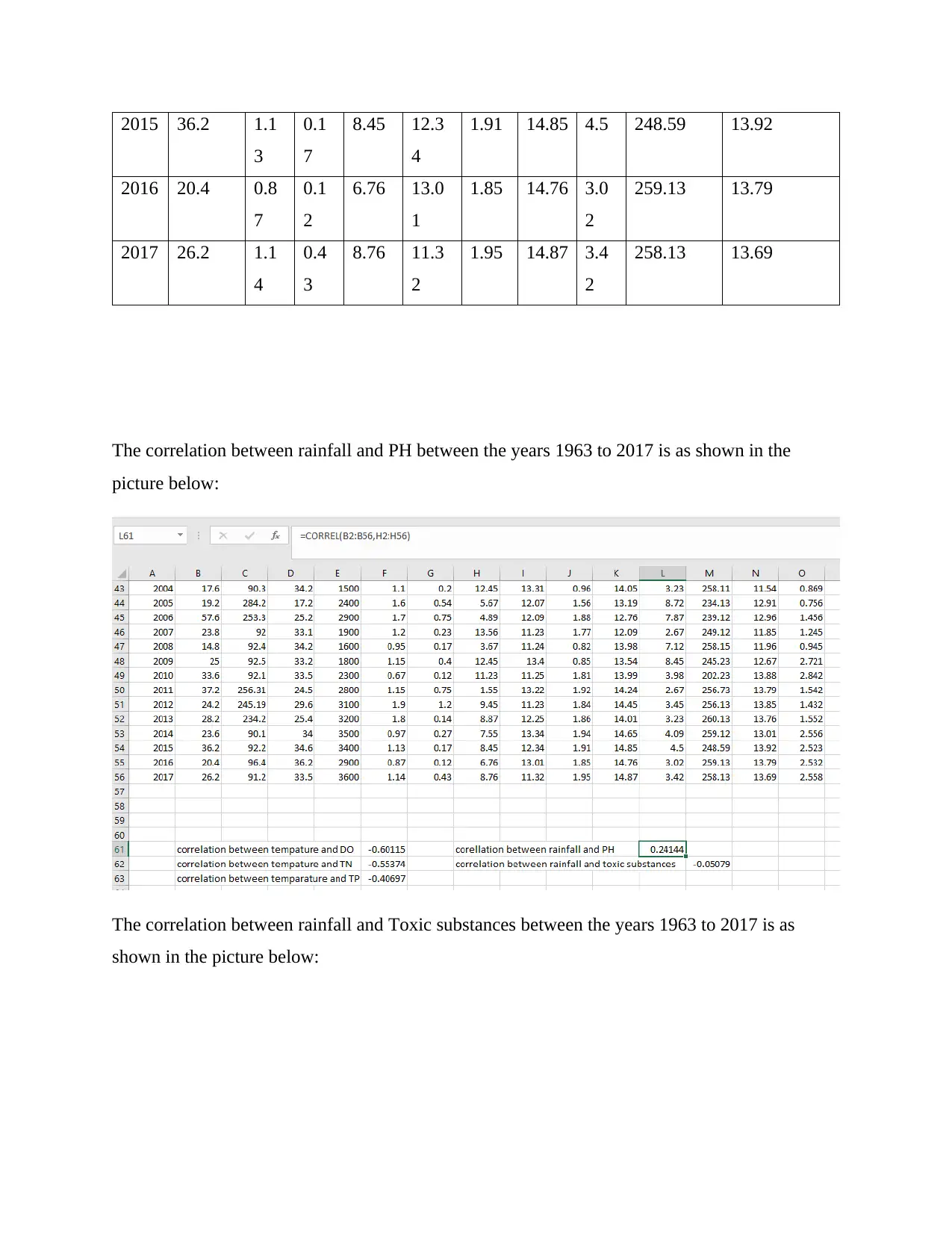
2015 36.2 1.1
3
0.1
7
8.45 12.3
4
1.91 14.85 4.5 248.59 13.92
2016 20.4 0.8
7
0.1
2
6.76 13.0
1
1.85 14.76 3.0
2
259.13 13.79
2017 26.2 1.1
4
0.4
3
8.76 11.3
2
1.95 14.87 3.4
2
258.13 13.69
The correlation between rainfall and PH between the years 1963 to 2017 is as shown in the
picture below:
The correlation between rainfall and Toxic substances between the years 1963 to 2017 is as
shown in the picture below:
3
0.1
7
8.45 12.3
4
1.91 14.85 4.5 248.59 13.92
2016 20.4 0.8
7
0.1
2
6.76 13.0
1
1.85 14.76 3.0
2
259.13 13.79
2017 26.2 1.1
4
0.4
3
8.76 11.3
2
1.95 14.87 3.4
2
258.13 13.69
The correlation between rainfall and PH between the years 1963 to 2017 is as shown in the
picture below:
The correlation between rainfall and Toxic substances between the years 1963 to 2017 is as
shown in the picture below:
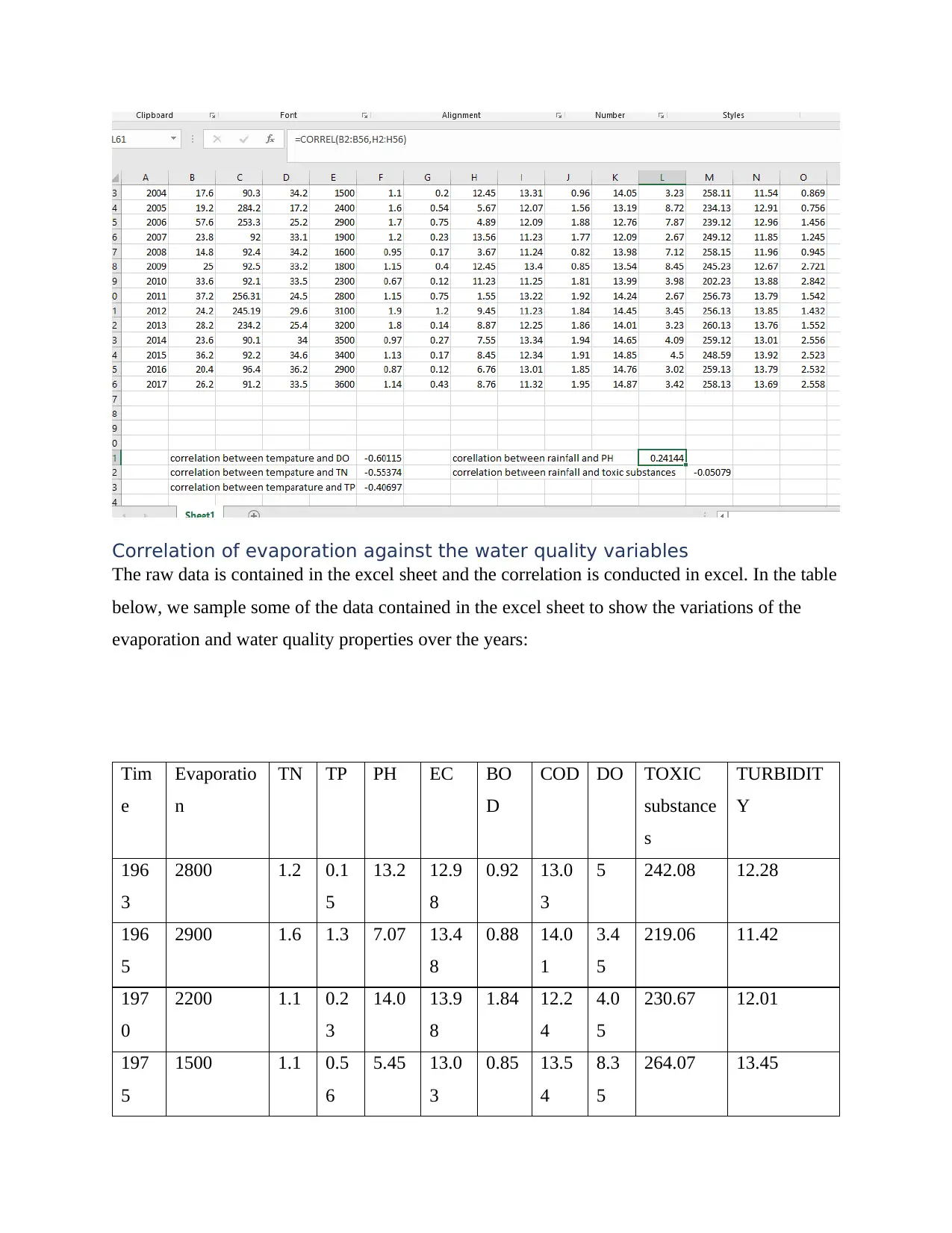
Correlation of evaporation against the water quality variables
The raw data is contained in the excel sheet and the correlation is conducted in excel. In the table
below, we sample some of the data contained in the excel sheet to show the variations of the
evaporation and water quality properties over the years:
Tim
e
Evaporatio
n
TN TP PH EC BO
D
COD DO TOXIC
substance
s
TURBIDIT
Y
196
3
2800 1.2 0.1
5
13.2 12.9
8
0.92 13.0
3
5 242.08 12.28
196
5
2900 1.6 1.3 7.07 13.4
8
0.88 14.0
1
3.4
5
219.06 11.42
197
0
2200 1.1 0.2
3
14.0 13.9
8
1.84 12.2
4
4.0
5
230.67 12.01
197
5
1500 1.1 0.5
6
5.45 13.0
3
0.85 13.5
4
8.3
5
264.07 13.45
The raw data is contained in the excel sheet and the correlation is conducted in excel. In the table
below, we sample some of the data contained in the excel sheet to show the variations of the
evaporation and water quality properties over the years:
Tim
e
Evaporatio
n
TN TP PH EC BO
D
COD DO TOXIC
substance
s
TURBIDIT
Y
196
3
2800 1.2 0.1
5
13.2 12.9
8
0.92 13.0
3
5 242.08 12.28
196
5
2900 1.6 1.3 7.07 13.4
8
0.88 14.0
1
3.4
5
219.06 11.42
197
0
2200 1.1 0.2
3
14.0 13.9
8
1.84 12.2
4
4.0
5
230.67 12.01
197
5
1500 1.1 0.5
6
5.45 13.0
3
0.85 13.5
4
8.3
5
264.07 13.45
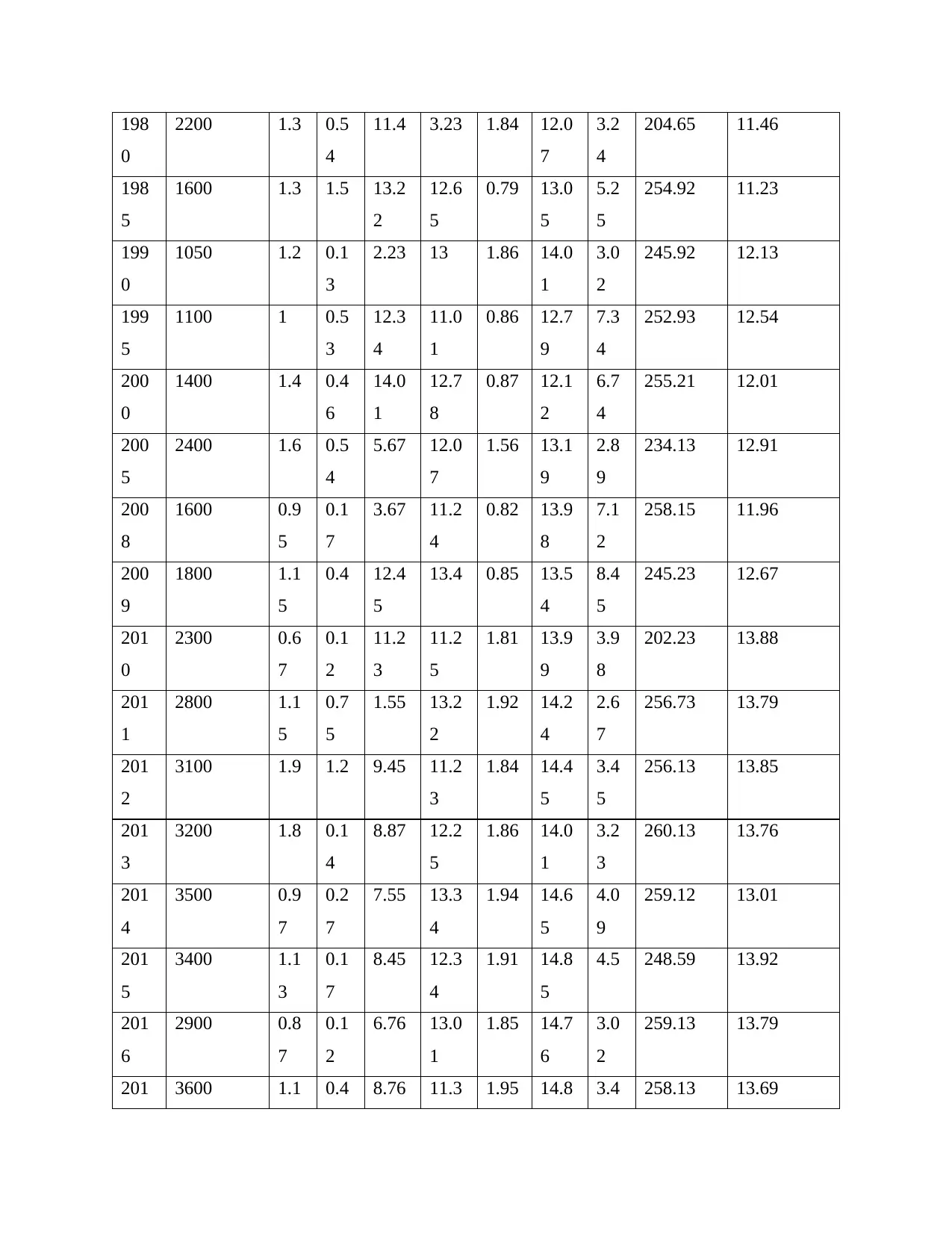
198
0
2200 1.3 0.5
4
11.4 3.23 1.84 12.0
7
3.2
4
204.65 11.46
198
5
1600 1.3 1.5 13.2
2
12.6
5
0.79 13.0
5
5.2
5
254.92 11.23
199
0
1050 1.2 0.1
3
2.23 13 1.86 14.0
1
3.0
2
245.92 12.13
199
5
1100 1 0.5
3
12.3
4
11.0
1
0.86 12.7
9
7.3
4
252.93 12.54
200
0
1400 1.4 0.4
6
14.0
1
12.7
8
0.87 12.1
2
6.7
4
255.21 12.01
200
5
2400 1.6 0.5
4
5.67 12.0
7
1.56 13.1
9
2.8
9
234.13 12.91
200
8
1600 0.9
5
0.1
7
3.67 11.2
4
0.82 13.9
8
7.1
2
258.15 11.96
200
9
1800 1.1
5
0.4 12.4
5
13.4 0.85 13.5
4
8.4
5
245.23 12.67
201
0
2300 0.6
7
0.1
2
11.2
3
11.2
5
1.81 13.9
9
3.9
8
202.23 13.88
201
1
2800 1.1
5
0.7
5
1.55 13.2
2
1.92 14.2
4
2.6
7
256.73 13.79
201
2
3100 1.9 1.2 9.45 11.2
3
1.84 14.4
5
3.4
5
256.13 13.85
201
3
3200 1.8 0.1
4
8.87 12.2
5
1.86 14.0
1
3.2
3
260.13 13.76
201
4
3500 0.9
7
0.2
7
7.55 13.3
4
1.94 14.6
5
4.0
9
259.12 13.01
201
5
3400 1.1
3
0.1
7
8.45 12.3
4
1.91 14.8
5
4.5 248.59 13.92
201
6
2900 0.8
7
0.1
2
6.76 13.0
1
1.85 14.7
6
3.0
2
259.13 13.79
201 3600 1.1 0.4 8.76 11.3 1.95 14.8 3.4 258.13 13.69
0
2200 1.3 0.5
4
11.4 3.23 1.84 12.0
7
3.2
4
204.65 11.46
198
5
1600 1.3 1.5 13.2
2
12.6
5
0.79 13.0
5
5.2
5
254.92 11.23
199
0
1050 1.2 0.1
3
2.23 13 1.86 14.0
1
3.0
2
245.92 12.13
199
5
1100 1 0.5
3
12.3
4
11.0
1
0.86 12.7
9
7.3
4
252.93 12.54
200
0
1400 1.4 0.4
6
14.0
1
12.7
8
0.87 12.1
2
6.7
4
255.21 12.01
200
5
2400 1.6 0.5
4
5.67 12.0
7
1.56 13.1
9
2.8
9
234.13 12.91
200
8
1600 0.9
5
0.1
7
3.67 11.2
4
0.82 13.9
8
7.1
2
258.15 11.96
200
9
1800 1.1
5
0.4 12.4
5
13.4 0.85 13.5
4
8.4
5
245.23 12.67
201
0
2300 0.6
7
0.1
2
11.2
3
11.2
5
1.81 13.9
9
3.9
8
202.23 13.88
201
1
2800 1.1
5
0.7
5
1.55 13.2
2
1.92 14.2
4
2.6
7
256.73 13.79
201
2
3100 1.9 1.2 9.45 11.2
3
1.84 14.4
5
3.4
5
256.13 13.85
201
3
3200 1.8 0.1
4
8.87 12.2
5
1.86 14.0
1
3.2
3
260.13 13.76
201
4
3500 0.9
7
0.2
7
7.55 13.3
4
1.94 14.6
5
4.0
9
259.12 13.01
201
5
3400 1.1
3
0.1
7
8.45 12.3
4
1.91 14.8
5
4.5 248.59 13.92
201
6
2900 0.8
7
0.1
2
6.76 13.0
1
1.85 14.7
6
3.0
2
259.13 13.79
201 3600 1.1 0.4 8.76 11.3 1.95 14.8 3.4 258.13 13.69
Secure Best Marks with AI Grader
Need help grading? Try our AI Grader for instant feedback on your assignments.
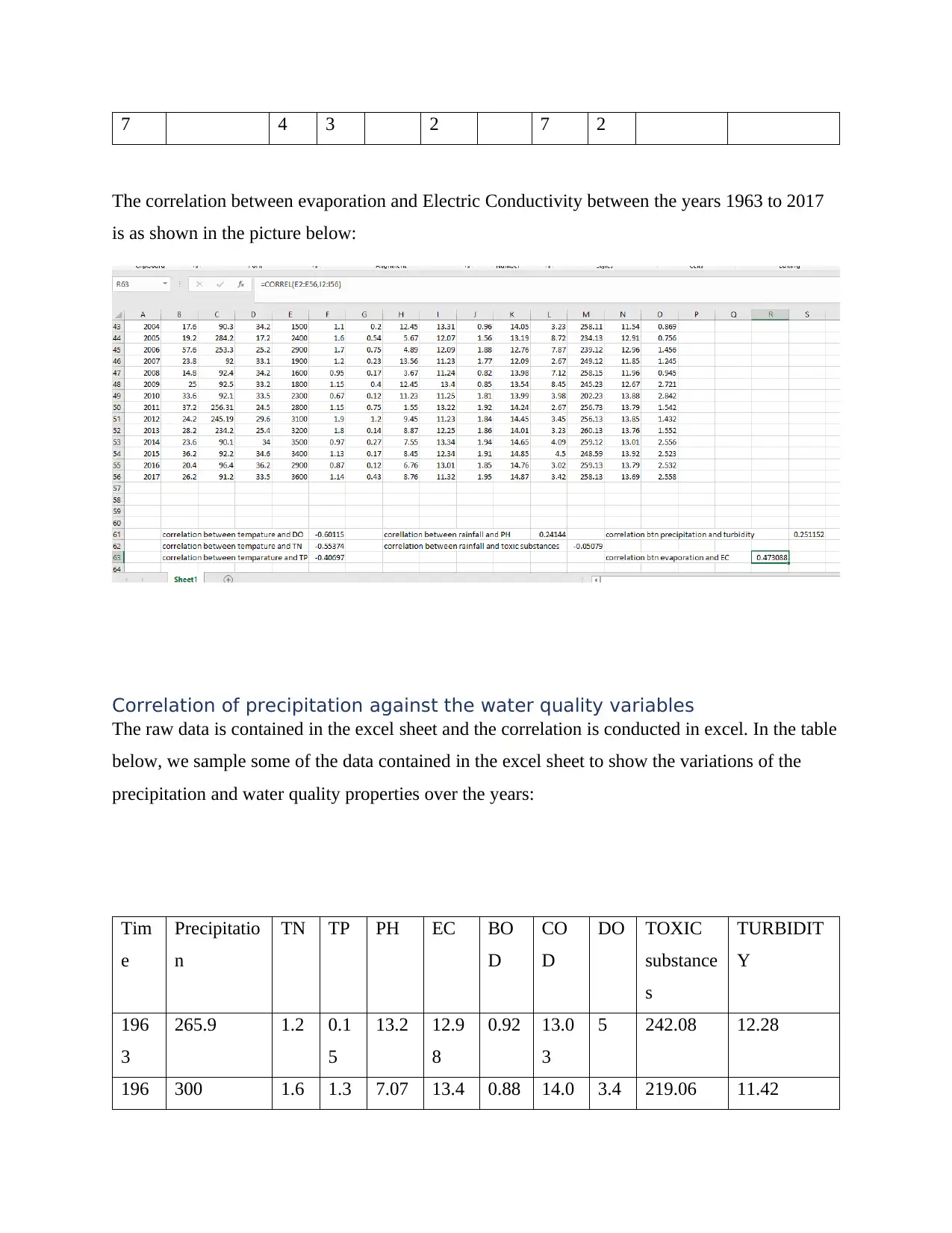
7 4 3 2 7 2
The correlation between evaporation and Electric Conductivity between the years 1963 to 2017
is as shown in the picture below:
Correlation of precipitation against the water quality variables
The raw data is contained in the excel sheet and the correlation is conducted in excel. In the table
below, we sample some of the data contained in the excel sheet to show the variations of the
precipitation and water quality properties over the years:
Tim
e
Precipitatio
n
TN TP PH EC BO
D
CO
D
DO TOXIC
substance
s
TURBIDIT
Y
196
3
265.9 1.2 0.1
5
13.2 12.9
8
0.92 13.0
3
5 242.08 12.28
196 300 1.6 1.3 7.07 13.4 0.88 14.0 3.4 219.06 11.42
The correlation between evaporation and Electric Conductivity between the years 1963 to 2017
is as shown in the picture below:
Correlation of precipitation against the water quality variables
The raw data is contained in the excel sheet and the correlation is conducted in excel. In the table
below, we sample some of the data contained in the excel sheet to show the variations of the
precipitation and water quality properties over the years:
Tim
e
Precipitatio
n
TN TP PH EC BO
D
CO
D
DO TOXIC
substance
s
TURBIDIT
Y
196
3
265.9 1.2 0.1
5
13.2 12.9
8
0.92 13.0
3
5 242.08 12.28
196 300 1.6 1.3 7.07 13.4 0.88 14.0 3.4 219.06 11.42
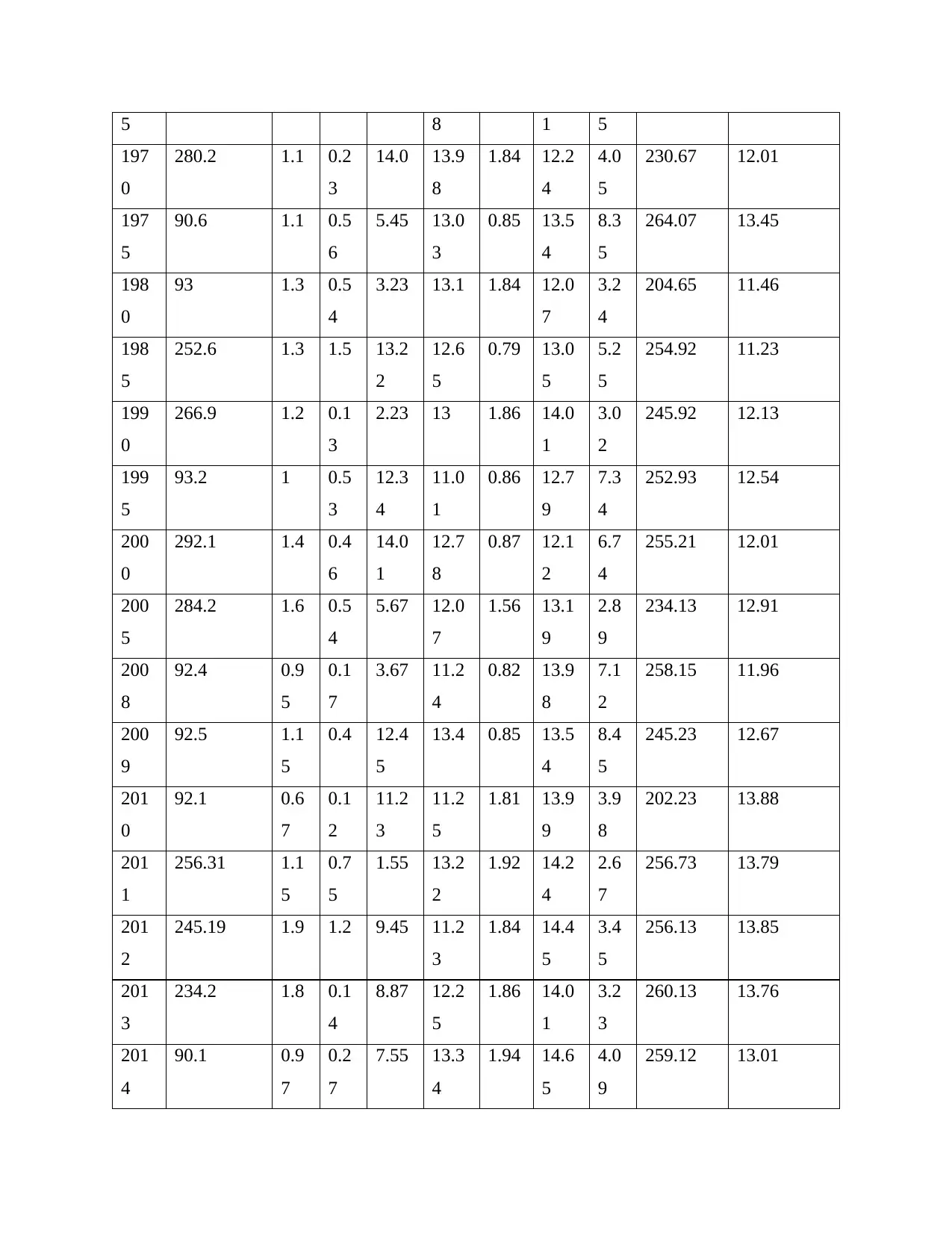
5 8 1 5
197
0
280.2 1.1 0.2
3
14.0 13.9
8
1.84 12.2
4
4.0
5
230.67 12.01
197
5
90.6 1.1 0.5
6
5.45 13.0
3
0.85 13.5
4
8.3
5
264.07 13.45
198
0
93 1.3 0.5
4
3.23 13.1 1.84 12.0
7
3.2
4
204.65 11.46
198
5
252.6 1.3 1.5 13.2
2
12.6
5
0.79 13.0
5
5.2
5
254.92 11.23
199
0
266.9 1.2 0.1
3
2.23 13 1.86 14.0
1
3.0
2
245.92 12.13
199
5
93.2 1 0.5
3
12.3
4
11.0
1
0.86 12.7
9
7.3
4
252.93 12.54
200
0
292.1 1.4 0.4
6
14.0
1
12.7
8
0.87 12.1
2
6.7
4
255.21 12.01
200
5
284.2 1.6 0.5
4
5.67 12.0
7
1.56 13.1
9
2.8
9
234.13 12.91
200
8
92.4 0.9
5
0.1
7
3.67 11.2
4
0.82 13.9
8
7.1
2
258.15 11.96
200
9
92.5 1.1
5
0.4 12.4
5
13.4 0.85 13.5
4
8.4
5
245.23 12.67
201
0
92.1 0.6
7
0.1
2
11.2
3
11.2
5
1.81 13.9
9
3.9
8
202.23 13.88
201
1
256.31 1.1
5
0.7
5
1.55 13.2
2
1.92 14.2
4
2.6
7
256.73 13.79
201
2
245.19 1.9 1.2 9.45 11.2
3
1.84 14.4
5
3.4
5
256.13 13.85
201
3
234.2 1.8 0.1
4
8.87 12.2
5
1.86 14.0
1
3.2
3
260.13 13.76
201
4
90.1 0.9
7
0.2
7
7.55 13.3
4
1.94 14.6
5
4.0
9
259.12 13.01
197
0
280.2 1.1 0.2
3
14.0 13.9
8
1.84 12.2
4
4.0
5
230.67 12.01
197
5
90.6 1.1 0.5
6
5.45 13.0
3
0.85 13.5
4
8.3
5
264.07 13.45
198
0
93 1.3 0.5
4
3.23 13.1 1.84 12.0
7
3.2
4
204.65 11.46
198
5
252.6 1.3 1.5 13.2
2
12.6
5
0.79 13.0
5
5.2
5
254.92 11.23
199
0
266.9 1.2 0.1
3
2.23 13 1.86 14.0
1
3.0
2
245.92 12.13
199
5
93.2 1 0.5
3
12.3
4
11.0
1
0.86 12.7
9
7.3
4
252.93 12.54
200
0
292.1 1.4 0.4
6
14.0
1
12.7
8
0.87 12.1
2
6.7
4
255.21 12.01
200
5
284.2 1.6 0.5
4
5.67 12.0
7
1.56 13.1
9
2.8
9
234.13 12.91
200
8
92.4 0.9
5
0.1
7
3.67 11.2
4
0.82 13.9
8
7.1
2
258.15 11.96
200
9
92.5 1.1
5
0.4 12.4
5
13.4 0.85 13.5
4
8.4
5
245.23 12.67
201
0
92.1 0.6
7
0.1
2
11.2
3
11.2
5
1.81 13.9
9
3.9
8
202.23 13.88
201
1
256.31 1.1
5
0.7
5
1.55 13.2
2
1.92 14.2
4
2.6
7
256.73 13.79
201
2
245.19 1.9 1.2 9.45 11.2
3
1.84 14.4
5
3.4
5
256.13 13.85
201
3
234.2 1.8 0.1
4
8.87 12.2
5
1.86 14.0
1
3.2
3
260.13 13.76
201
4
90.1 0.9
7
0.2
7
7.55 13.3
4
1.94 14.6
5
4.0
9
259.12 13.01
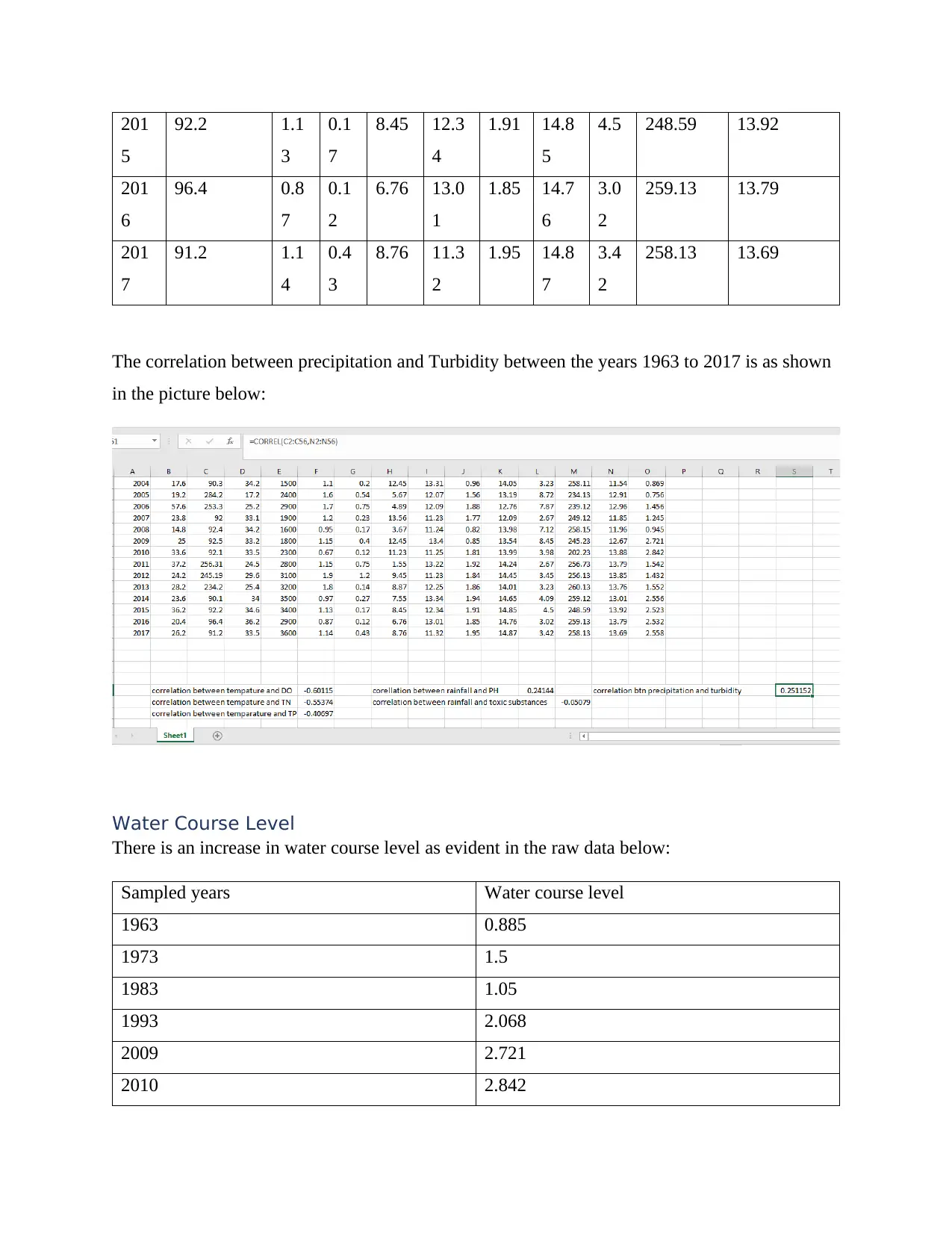
201
5
92.2 1.1
3
0.1
7
8.45 12.3
4
1.91 14.8
5
4.5 248.59 13.92
201
6
96.4 0.8
7
0.1
2
6.76 13.0
1
1.85 14.7
6
3.0
2
259.13 13.79
201
7
91.2 1.1
4
0.4
3
8.76 11.3
2
1.95 14.8
7
3.4
2
258.13 13.69
The correlation between precipitation and Turbidity between the years 1963 to 2017 is as shown
in the picture below:
Water Course Level
There is an increase in water course level as evident in the raw data below:
Sampled years Water course level
1963 0.885
1973 1.5
1983 1.05
1993 2.068
2009 2.721
2010 2.842
5
92.2 1.1
3
0.1
7
8.45 12.3
4
1.91 14.8
5
4.5 248.59 13.92
201
6
96.4 0.8
7
0.1
2
6.76 13.0
1
1.85 14.7
6
3.0
2
259.13 13.79
201
7
91.2 1.1
4
0.4
3
8.76 11.3
2
1.95 14.8
7
3.4
2
258.13 13.69
The correlation between precipitation and Turbidity between the years 1963 to 2017 is as shown
in the picture below:
Water Course Level
There is an increase in water course level as evident in the raw data below:
Sampled years Water course level
1963 0.885
1973 1.5
1983 1.05
1993 2.068
2009 2.721
2010 2.842
Paraphrase This Document
Need a fresh take? Get an instant paraphrase of this document with our AI Paraphraser
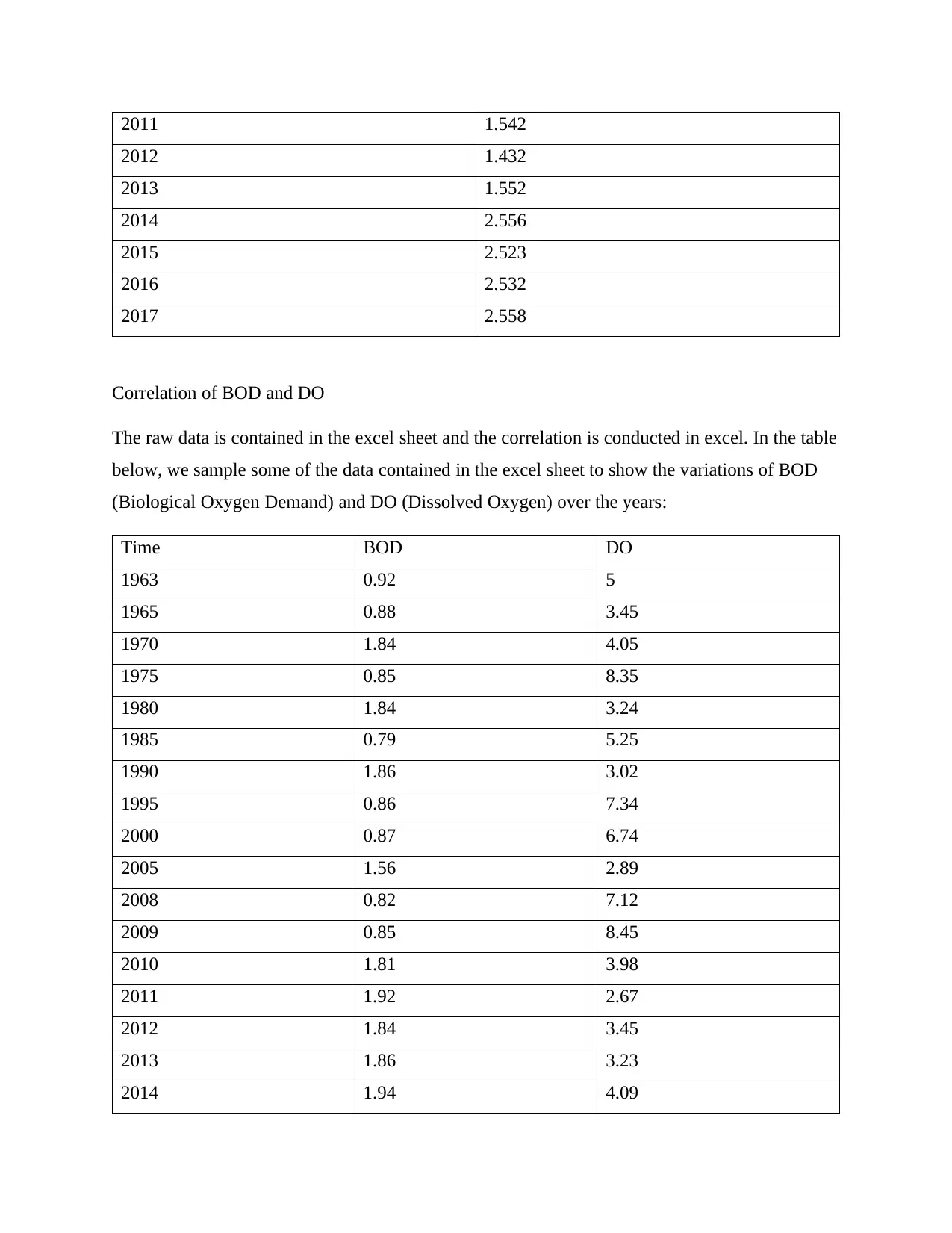
2011 1.542
2012 1.432
2013 1.552
2014 2.556
2015 2.523
2016 2.532
2017 2.558
Correlation of BOD and DO
The raw data is contained in the excel sheet and the correlation is conducted in excel. In the table
below, we sample some of the data contained in the excel sheet to show the variations of BOD
(Biological Oxygen Demand) and DO (Dissolved Oxygen) over the years:
Time BOD DO
1963 0.92 5
1965 0.88 3.45
1970 1.84 4.05
1975 0.85 8.35
1980 1.84 3.24
1985 0.79 5.25
1990 1.86 3.02
1995 0.86 7.34
2000 0.87 6.74
2005 1.56 2.89
2008 0.82 7.12
2009 0.85 8.45
2010 1.81 3.98
2011 1.92 2.67
2012 1.84 3.45
2013 1.86 3.23
2014 1.94 4.09
2012 1.432
2013 1.552
2014 2.556
2015 2.523
2016 2.532
2017 2.558
Correlation of BOD and DO
The raw data is contained in the excel sheet and the correlation is conducted in excel. In the table
below, we sample some of the data contained in the excel sheet to show the variations of BOD
(Biological Oxygen Demand) and DO (Dissolved Oxygen) over the years:
Time BOD DO
1963 0.92 5
1965 0.88 3.45
1970 1.84 4.05
1975 0.85 8.35
1980 1.84 3.24
1985 0.79 5.25
1990 1.86 3.02
1995 0.86 7.34
2000 0.87 6.74
2005 1.56 2.89
2008 0.82 7.12
2009 0.85 8.45
2010 1.81 3.98
2011 1.92 2.67
2012 1.84 3.45
2013 1.86 3.23
2014 1.94 4.09
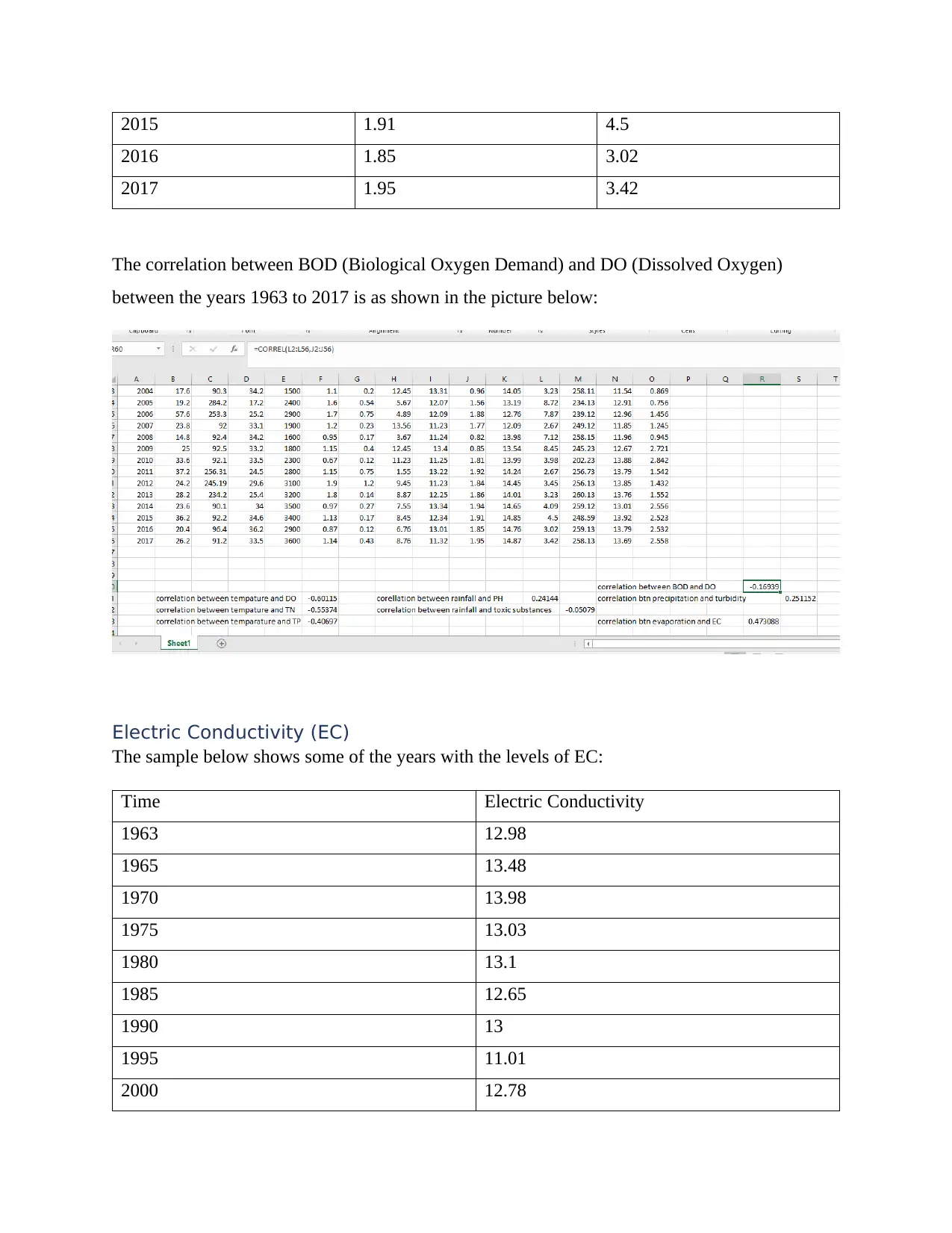
2015 1.91 4.5
2016 1.85 3.02
2017 1.95 3.42
The correlation between BOD (Biological Oxygen Demand) and DO (Dissolved Oxygen)
between the years 1963 to 2017 is as shown in the picture below:
Electric Conductivity (EC)
The sample below shows some of the years with the levels of EC:
Time Electric Conductivity
1963 12.98
1965 13.48
1970 13.98
1975 13.03
1980 13.1
1985 12.65
1990 13
1995 11.01
2000 12.78
2016 1.85 3.02
2017 1.95 3.42
The correlation between BOD (Biological Oxygen Demand) and DO (Dissolved Oxygen)
between the years 1963 to 2017 is as shown in the picture below:
Electric Conductivity (EC)
The sample below shows some of the years with the levels of EC:
Time Electric Conductivity
1963 12.98
1965 13.48
1970 13.98
1975 13.03
1980 13.1
1985 12.65
1990 13
1995 11.01
2000 12.78
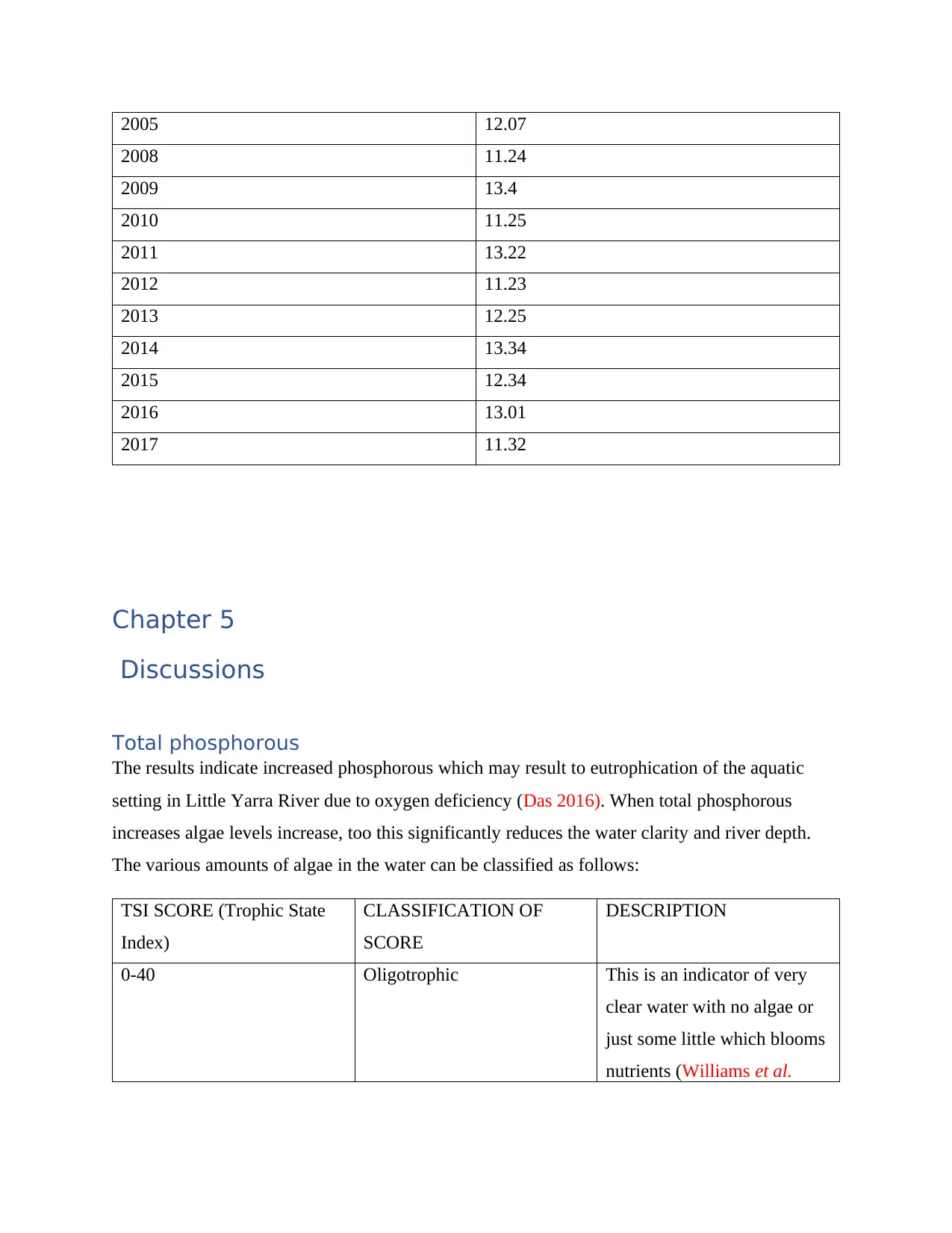
2005 12.07
2008 11.24
2009 13.4
2010 11.25
2011 13.22
2012 11.23
2013 12.25
2014 13.34
2015 12.34
2016 13.01
2017 11.32
Chapter 5
Discussions
Total phosphorous
The results indicate increased phosphorous which may result to eutrophication of the aquatic
setting in Little Yarra River due to oxygen deficiency (Das 2016). When total phosphorous
increases algae levels increase, too this significantly reduces the water clarity and river depth.
The various amounts of algae in the water can be classified as follows:
TSI SCORE (Trophic State
Index)
CLASSIFICATION OF
SCORE
DESCRIPTION
0-40 Oligotrophic This is an indicator of very
clear water with no algae or
just some little which blooms
nutrients (Williams et al.
2008 11.24
2009 13.4
2010 11.25
2011 13.22
2012 11.23
2013 12.25
2014 13.34
2015 12.34
2016 13.01
2017 11.32
Chapter 5
Discussions
Total phosphorous
The results indicate increased phosphorous which may result to eutrophication of the aquatic
setting in Little Yarra River due to oxygen deficiency (Das 2016). When total phosphorous
increases algae levels increase, too this significantly reduces the water clarity and river depth.
The various amounts of algae in the water can be classified as follows:
TSI SCORE (Trophic State
Index)
CLASSIFICATION OF
SCORE
DESCRIPTION
0-40 Oligotrophic This is an indicator of very
clear water with no algae or
just some little which blooms
nutrients (Williams et al.
Secure Best Marks with AI Grader
Need help grading? Try our AI Grader for instant feedback on your assignments.
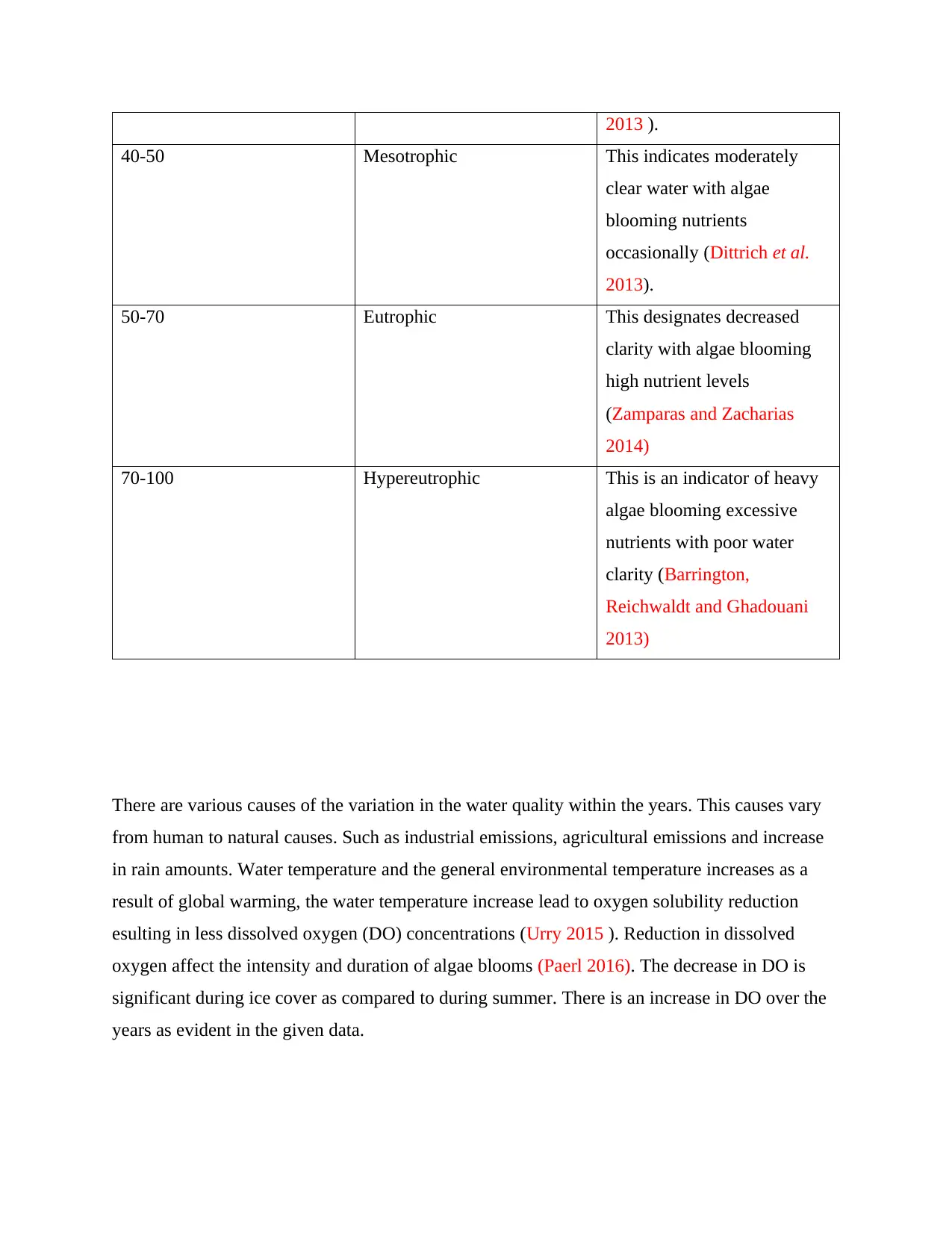
2013 ).
40-50 Mesotrophic This indicates moderately
clear water with algae
blooming nutrients
occasionally (Dittrich et al.
2013).
50-70 Eutrophic This designates decreased
clarity with algae blooming
high nutrient levels
(Zamparas and Zacharias
2014)
70-100 Hypereutrophic This is an indicator of heavy
algae blooming excessive
nutrients with poor water
clarity (Barrington,
Reichwaldt and Ghadouani
2013)
There are various causes of the variation in the water quality within the years. This causes vary
from human to natural causes. Such as industrial emissions, agricultural emissions and increase
in rain amounts. Water temperature and the general environmental temperature increases as a
result of global warming, the water temperature increase lead to oxygen solubility reduction
esulting in less dissolved oxygen (DO) concentrations (Urry 2015 ). Reduction in dissolved
oxygen affect the intensity and duration of algae blooms (Paerl 2016). The decrease in DO is
significant during ice cover as compared to during summer. There is an increase in DO over the
years as evident in the given data.
40-50 Mesotrophic This indicates moderately
clear water with algae
blooming nutrients
occasionally (Dittrich et al.
2013).
50-70 Eutrophic This designates decreased
clarity with algae blooming
high nutrient levels
(Zamparas and Zacharias
2014)
70-100 Hypereutrophic This is an indicator of heavy
algae blooming excessive
nutrients with poor water
clarity (Barrington,
Reichwaldt and Ghadouani
2013)
There are various causes of the variation in the water quality within the years. This causes vary
from human to natural causes. Such as industrial emissions, agricultural emissions and increase
in rain amounts. Water temperature and the general environmental temperature increases as a
result of global warming, the water temperature increase lead to oxygen solubility reduction
esulting in less dissolved oxygen (DO) concentrations (Urry 2015 ). Reduction in dissolved
oxygen affect the intensity and duration of algae blooms (Paerl 2016). The decrease in DO is
significant during ice cover as compared to during summer. There is an increase in DO over the
years as evident in the given data.
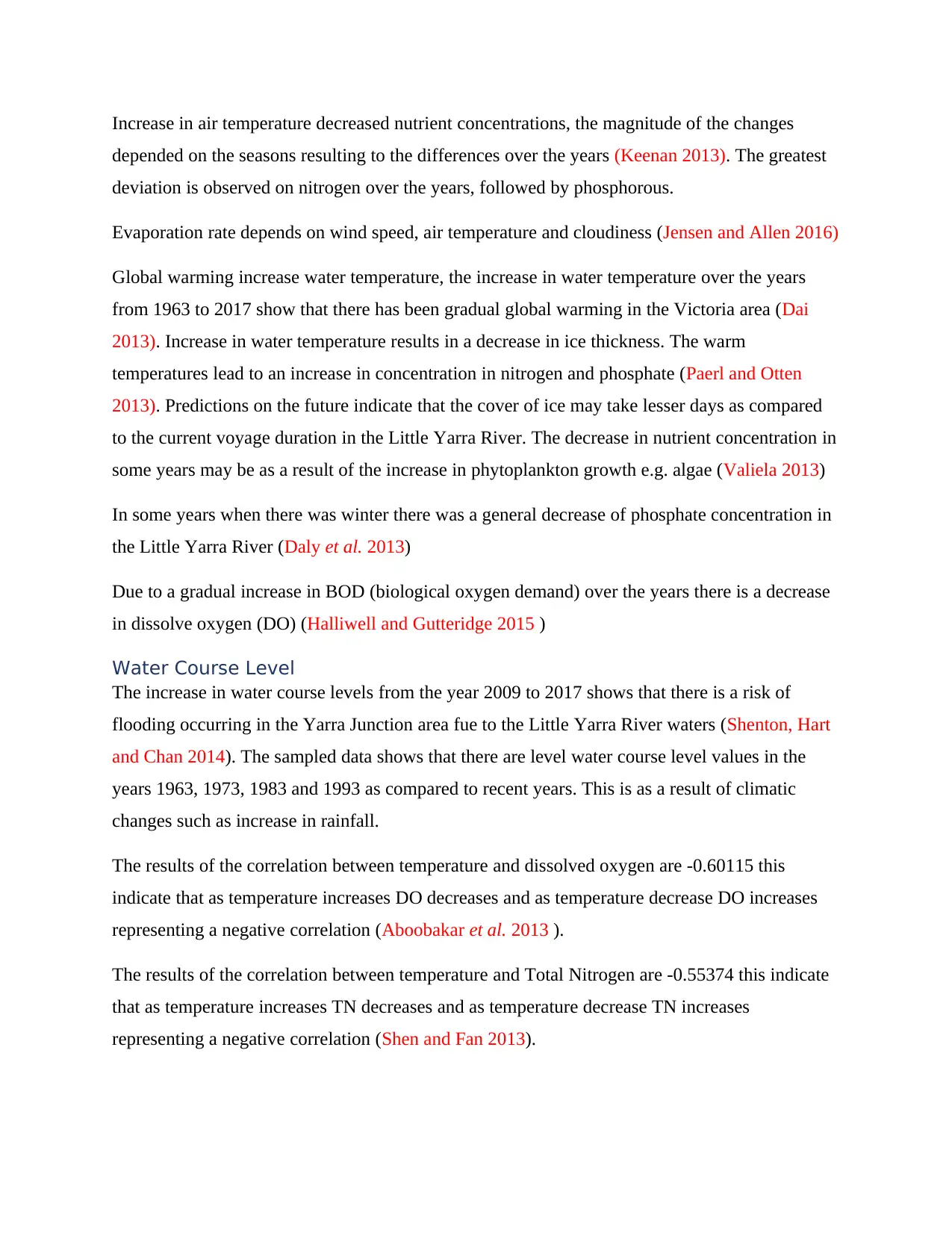
Increase in air temperature decreased nutrient concentrations, the magnitude of the changes
depended on the seasons resulting to the differences over the years (Keenan 2013). The greatest
deviation is observed on nitrogen over the years, followed by phosphorous.
Evaporation rate depends on wind speed, air temperature and cloudiness (Jensen and Allen 2016)
Global warming increase water temperature, the increase in water temperature over the years
from 1963 to 2017 show that there has been gradual global warming in the Victoria area (Dai
2013). Increase in water temperature results in a decrease in ice thickness. The warm
temperatures lead to an increase in concentration in nitrogen and phosphate (Paerl and Otten
2013). Predictions on the future indicate that the cover of ice may take lesser days as compared
to the current voyage duration in the Little Yarra River. The decrease in nutrient concentration in
some years may be as a result of the increase in phytoplankton growth e.g. algae (Valiela 2013)
In some years when there was winter there was a general decrease of phosphate concentration in
the Little Yarra River (Daly et al. 2013)
Due to a gradual increase in BOD (biological oxygen demand) over the years there is a decrease
in dissolve oxygen (DO) (Halliwell and Gutteridge 2015 )
Water Course Level
The increase in water course levels from the year 2009 to 2017 shows that there is a risk of
flooding occurring in the Yarra Junction area fue to the Little Yarra River waters (Shenton, Hart
and Chan 2014). The sampled data shows that there are level water course level values in the
years 1963, 1973, 1983 and 1993 as compared to recent years. This is as a result of climatic
changes such as increase in rainfall.
The results of the correlation between temperature and dissolved oxygen are -0.60115 this
indicate that as temperature increases DO decreases and as temperature decrease DO increases
representing a negative correlation (Aboobakar et al. 2013 ).
The results of the correlation between temperature and Total Nitrogen are -0.55374 this indicate
that as temperature increases TN decreases and as temperature decrease TN increases
representing a negative correlation (Shen and Fan 2013).
depended on the seasons resulting to the differences over the years (Keenan 2013). The greatest
deviation is observed on nitrogen over the years, followed by phosphorous.
Evaporation rate depends on wind speed, air temperature and cloudiness (Jensen and Allen 2016)
Global warming increase water temperature, the increase in water temperature over the years
from 1963 to 2017 show that there has been gradual global warming in the Victoria area (Dai
2013). Increase in water temperature results in a decrease in ice thickness. The warm
temperatures lead to an increase in concentration in nitrogen and phosphate (Paerl and Otten
2013). Predictions on the future indicate that the cover of ice may take lesser days as compared
to the current voyage duration in the Little Yarra River. The decrease in nutrient concentration in
some years may be as a result of the increase in phytoplankton growth e.g. algae (Valiela 2013)
In some years when there was winter there was a general decrease of phosphate concentration in
the Little Yarra River (Daly et al. 2013)
Due to a gradual increase in BOD (biological oxygen demand) over the years there is a decrease
in dissolve oxygen (DO) (Halliwell and Gutteridge 2015 )
Water Course Level
The increase in water course levels from the year 2009 to 2017 shows that there is a risk of
flooding occurring in the Yarra Junction area fue to the Little Yarra River waters (Shenton, Hart
and Chan 2014). The sampled data shows that there are level water course level values in the
years 1963, 1973, 1983 and 1993 as compared to recent years. This is as a result of climatic
changes such as increase in rainfall.
The results of the correlation between temperature and dissolved oxygen are -0.60115 this
indicate that as temperature increases DO decreases and as temperature decrease DO increases
representing a negative correlation (Aboobakar et al. 2013 ).
The results of the correlation between temperature and Total Nitrogen are -0.55374 this indicate
that as temperature increases TN decreases and as temperature decrease TN increases
representing a negative correlation (Shen and Fan 2013).
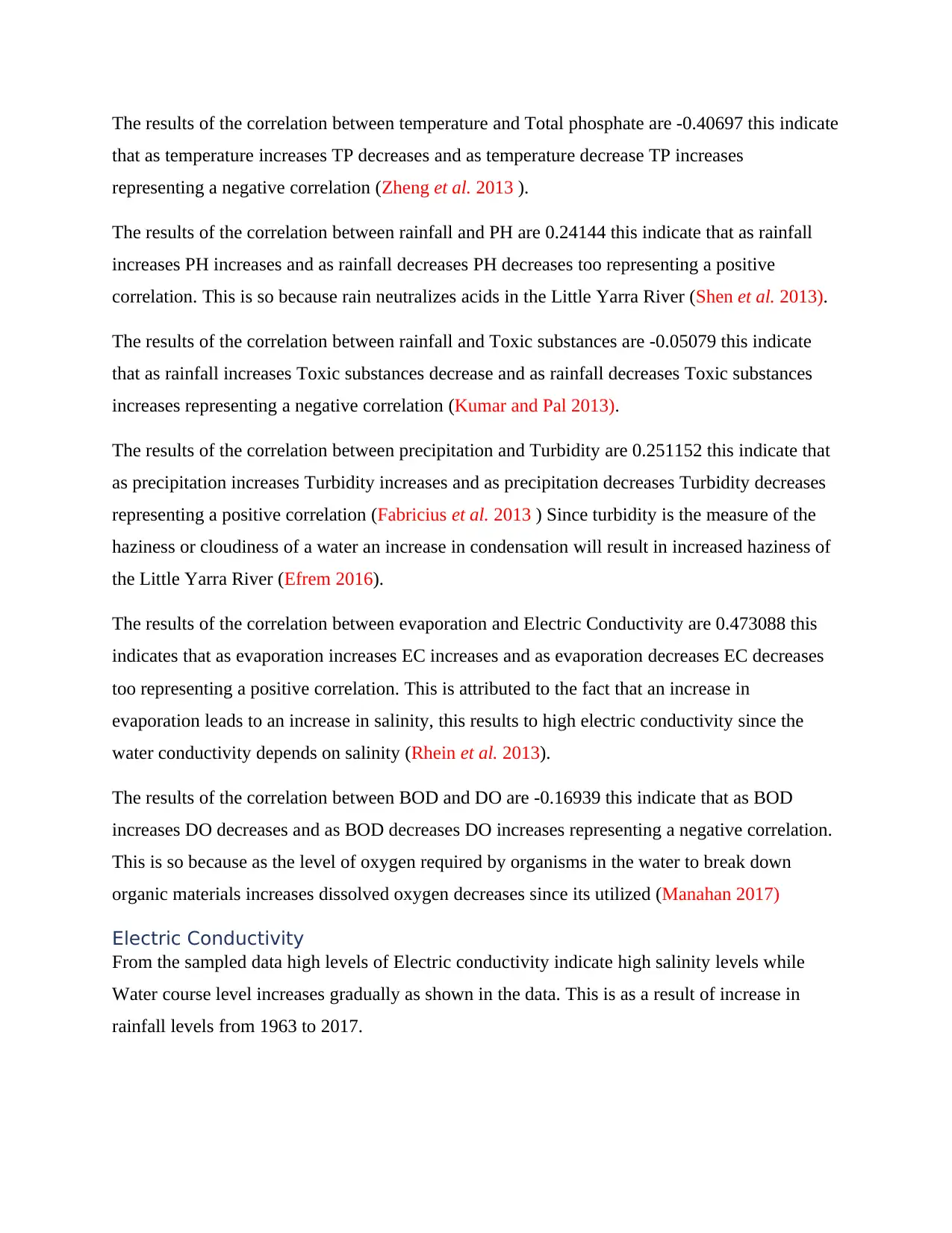
The results of the correlation between temperature and Total phosphate are -0.40697 this indicate
that as temperature increases TP decreases and as temperature decrease TP increases
representing a negative correlation (Zheng et al. 2013 ).
The results of the correlation between rainfall and PH are 0.24144 this indicate that as rainfall
increases PH increases and as rainfall decreases PH decreases too representing a positive
correlation. This is so because rain neutralizes acids in the Little Yarra River (Shen et al. 2013).
The results of the correlation between rainfall and Toxic substances are -0.05079 this indicate
that as rainfall increases Toxic substances decrease and as rainfall decreases Toxic substances
increases representing a negative correlation (Kumar and Pal 2013).
The results of the correlation between precipitation and Turbidity are 0.251152 this indicate that
as precipitation increases Turbidity increases and as precipitation decreases Turbidity decreases
representing a positive correlation (Fabricius et al. 2013 ) Since turbidity is the measure of the
haziness or cloudiness of a water an increase in condensation will result in increased haziness of
the Little Yarra River (Efrem 2016).
The results of the correlation between evaporation and Electric Conductivity are 0.473088 this
indicates that as evaporation increases EC increases and as evaporation decreases EC decreases
too representing a positive correlation. This is attributed to the fact that an increase in
evaporation leads to an increase in salinity, this results to high electric conductivity since the
water conductivity depends on salinity (Rhein et al. 2013).
The results of the correlation between BOD and DO are -0.16939 this indicate that as BOD
increases DO decreases and as BOD decreases DO increases representing a negative correlation.
This is so because as the level of oxygen required by organisms in the water to break down
organic materials increases dissolved oxygen decreases since its utilized (Manahan 2017)
Electric Conductivity
From the sampled data high levels of Electric conductivity indicate high salinity levels while
Water course level increases gradually as shown in the data. This is as a result of increase in
rainfall levels from 1963 to 2017.
that as temperature increases TP decreases and as temperature decrease TP increases
representing a negative correlation (Zheng et al. 2013 ).
The results of the correlation between rainfall and PH are 0.24144 this indicate that as rainfall
increases PH increases and as rainfall decreases PH decreases too representing a positive
correlation. This is so because rain neutralizes acids in the Little Yarra River (Shen et al. 2013).
The results of the correlation between rainfall and Toxic substances are -0.05079 this indicate
that as rainfall increases Toxic substances decrease and as rainfall decreases Toxic substances
increases representing a negative correlation (Kumar and Pal 2013).
The results of the correlation between precipitation and Turbidity are 0.251152 this indicate that
as precipitation increases Turbidity increases and as precipitation decreases Turbidity decreases
representing a positive correlation (Fabricius et al. 2013 ) Since turbidity is the measure of the
haziness or cloudiness of a water an increase in condensation will result in increased haziness of
the Little Yarra River (Efrem 2016).
The results of the correlation between evaporation and Electric Conductivity are 0.473088 this
indicates that as evaporation increases EC increases and as evaporation decreases EC decreases
too representing a positive correlation. This is attributed to the fact that an increase in
evaporation leads to an increase in salinity, this results to high electric conductivity since the
water conductivity depends on salinity (Rhein et al. 2013).
The results of the correlation between BOD and DO are -0.16939 this indicate that as BOD
increases DO decreases and as BOD decreases DO increases representing a negative correlation.
This is so because as the level of oxygen required by organisms in the water to break down
organic materials increases dissolved oxygen decreases since its utilized (Manahan 2017)
Electric Conductivity
From the sampled data high levels of Electric conductivity indicate high salinity levels while
Water course level increases gradually as shown in the data. This is as a result of increase in
rainfall levels from 1963 to 2017.
Paraphrase This Document
Need a fresh take? Get an instant paraphrase of this document with our AI Paraphraser

.
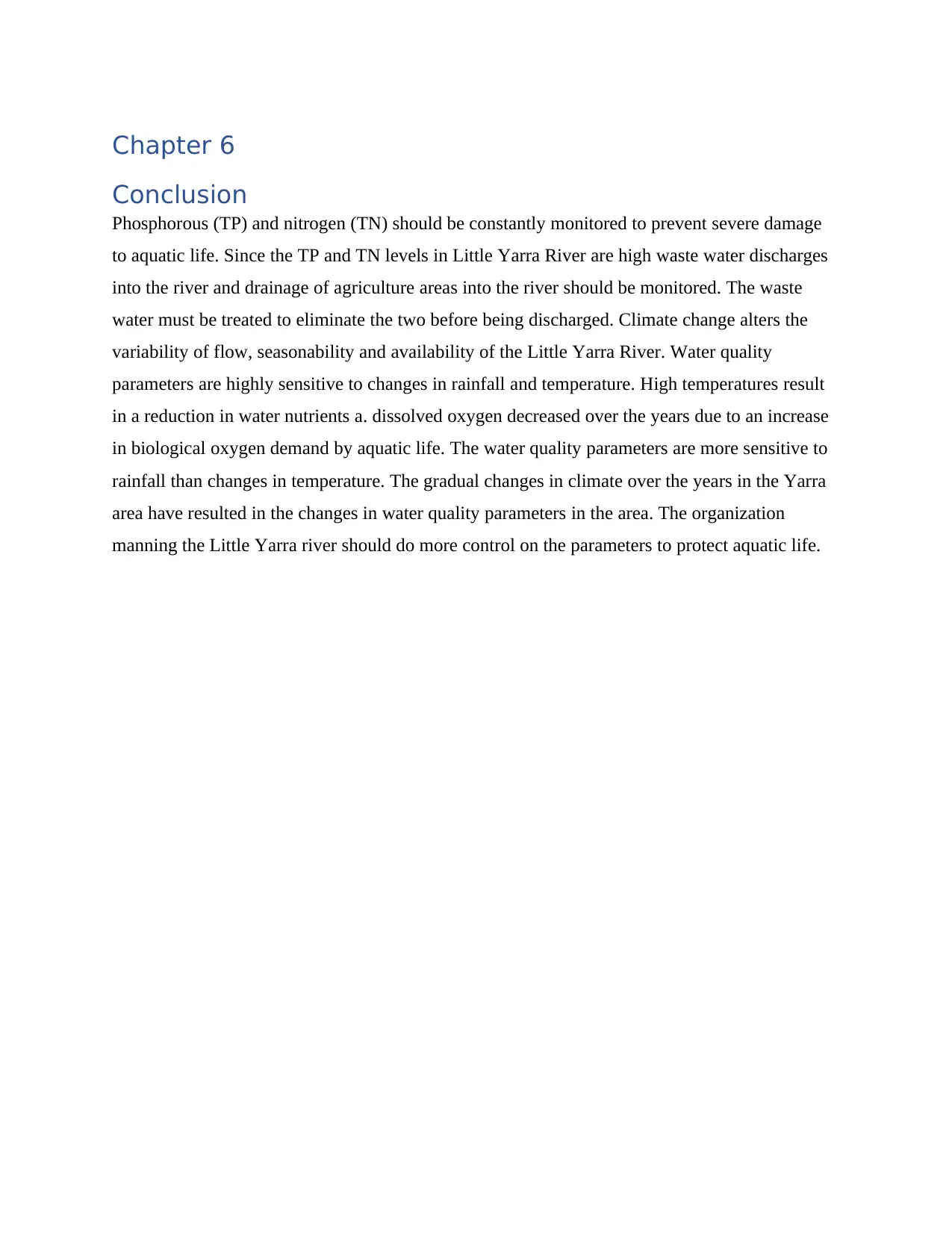
Chapter 6
Conclusion
Phosphorous (TP) and nitrogen (TN) should be constantly monitored to prevent severe damage
to aquatic life. Since the TP and TN levels in Little Yarra River are high waste water discharges
into the river and drainage of agriculture areas into the river should be monitored. The waste
water must be treated to eliminate the two before being discharged. Climate change alters the
variability of flow, seasonability and availability of the Little Yarra River. Water quality
parameters are highly sensitive to changes in rainfall and temperature. High temperatures result
in a reduction in water nutrients a. dissolved oxygen decreased over the years due to an increase
in biological oxygen demand by aquatic life. The water quality parameters are more sensitive to
rainfall than changes in temperature. The gradual changes in climate over the years in the Yarra
area have resulted in the changes in water quality parameters in the area. The organization
manning the Little Yarra river should do more control on the parameters to protect aquatic life.
Conclusion
Phosphorous (TP) and nitrogen (TN) should be constantly monitored to prevent severe damage
to aquatic life. Since the TP and TN levels in Little Yarra River are high waste water discharges
into the river and drainage of agriculture areas into the river should be monitored. The waste
water must be treated to eliminate the two before being discharged. Climate change alters the
variability of flow, seasonability and availability of the Little Yarra River. Water quality
parameters are highly sensitive to changes in rainfall and temperature. High temperatures result
in a reduction in water nutrients a. dissolved oxygen decreased over the years due to an increase
in biological oxygen demand by aquatic life. The water quality parameters are more sensitive to
rainfall than changes in temperature. The gradual changes in climate over the years in the Yarra
area have resulted in the changes in water quality parameters in the area. The organization
manning the Little Yarra river should do more control on the parameters to protect aquatic life.
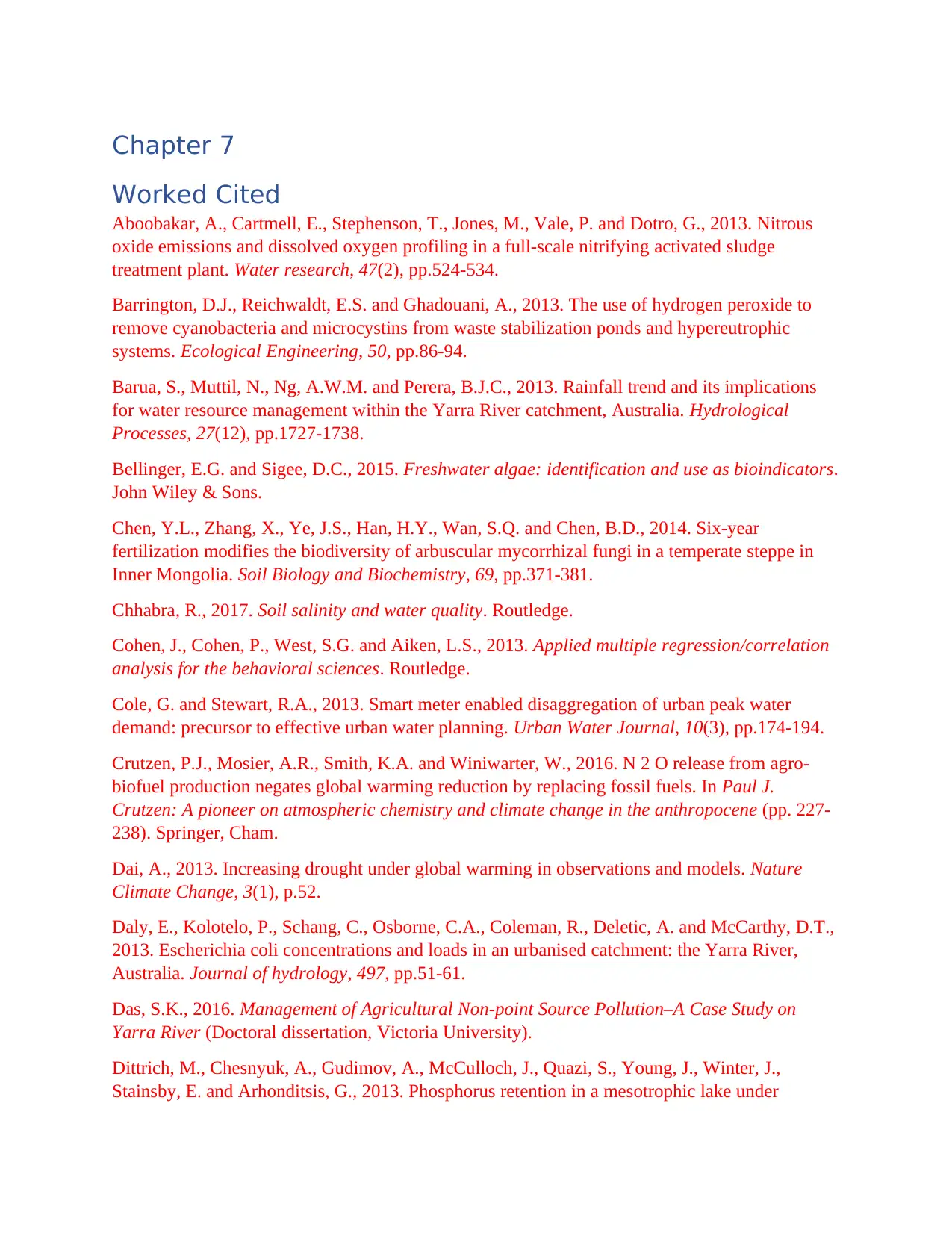
Chapter 7
Worked Cited
Aboobakar, A., Cartmell, E., Stephenson, T., Jones, M., Vale, P. and Dotro, G., 2013. Nitrous
oxide emissions and dissolved oxygen profiling in a full-scale nitrifying activated sludge
treatment plant. Water research, 47(2), pp.524-534.
Barrington, D.J., Reichwaldt, E.S. and Ghadouani, A., 2013. The use of hydrogen peroxide to
remove cyanobacteria and microcystins from waste stabilization ponds and hypereutrophic
systems. Ecological Engineering, 50, pp.86-94.
Barua, S., Muttil, N., Ng, A.W.M. and Perera, B.J.C., 2013. Rainfall trend and its implications
for water resource management within the Yarra River catchment, Australia. Hydrological
Processes, 27(12), pp.1727-1738.
Bellinger, E.G. and Sigee, D.C., 2015. Freshwater algae: identification and use as bioindicators.
John Wiley & Sons.
Chen, Y.L., Zhang, X., Ye, J.S., Han, H.Y., Wan, S.Q. and Chen, B.D., 2014. Six-year
fertilization modifies the biodiversity of arbuscular mycorrhizal fungi in a temperate steppe in
Inner Mongolia. Soil Biology and Biochemistry, 69, pp.371-381.
Chhabra, R., 2017. Soil salinity and water quality. Routledge.
Cohen, J., Cohen, P., West, S.G. and Aiken, L.S., 2013. Applied multiple regression/correlation
analysis for the behavioral sciences. Routledge.
Cole, G. and Stewart, R.A., 2013. Smart meter enabled disaggregation of urban peak water
demand: precursor to effective urban water planning. Urban Water Journal, 10(3), pp.174-194.
Crutzen, P.J., Mosier, A.R., Smith, K.A. and Winiwarter, W., 2016. N 2 O release from agro-
biofuel production negates global warming reduction by replacing fossil fuels. In Paul J.
Crutzen: A pioneer on atmospheric chemistry and climate change in the anthropocene (pp. 227-
238). Springer, Cham.
Dai, A., 2013. Increasing drought under global warming in observations and models. Nature
Climate Change, 3(1), p.52.
Daly, E., Kolotelo, P., Schang, C., Osborne, C.A., Coleman, R., Deletic, A. and McCarthy, D.T.,
2013. Escherichia coli concentrations and loads in an urbanised catchment: the Yarra River,
Australia. Journal of hydrology, 497, pp.51-61.
Das, S.K., 2016. Management of Agricultural Non-point Source Pollution–A Case Study on
Yarra River (Doctoral dissertation, Victoria University).
Dittrich, M., Chesnyuk, A., Gudimov, A., McCulloch, J., Quazi, S., Young, J., Winter, J.,
Stainsby, E. and Arhonditsis, G., 2013. Phosphorus retention in a mesotrophic lake under
Worked Cited
Aboobakar, A., Cartmell, E., Stephenson, T., Jones, M., Vale, P. and Dotro, G., 2013. Nitrous
oxide emissions and dissolved oxygen profiling in a full-scale nitrifying activated sludge
treatment plant. Water research, 47(2), pp.524-534.
Barrington, D.J., Reichwaldt, E.S. and Ghadouani, A., 2013. The use of hydrogen peroxide to
remove cyanobacteria and microcystins from waste stabilization ponds and hypereutrophic
systems. Ecological Engineering, 50, pp.86-94.
Barua, S., Muttil, N., Ng, A.W.M. and Perera, B.J.C., 2013. Rainfall trend and its implications
for water resource management within the Yarra River catchment, Australia. Hydrological
Processes, 27(12), pp.1727-1738.
Bellinger, E.G. and Sigee, D.C., 2015. Freshwater algae: identification and use as bioindicators.
John Wiley & Sons.
Chen, Y.L., Zhang, X., Ye, J.S., Han, H.Y., Wan, S.Q. and Chen, B.D., 2014. Six-year
fertilization modifies the biodiversity of arbuscular mycorrhizal fungi in a temperate steppe in
Inner Mongolia. Soil Biology and Biochemistry, 69, pp.371-381.
Chhabra, R., 2017. Soil salinity and water quality. Routledge.
Cohen, J., Cohen, P., West, S.G. and Aiken, L.S., 2013. Applied multiple regression/correlation
analysis for the behavioral sciences. Routledge.
Cole, G. and Stewart, R.A., 2013. Smart meter enabled disaggregation of urban peak water
demand: precursor to effective urban water planning. Urban Water Journal, 10(3), pp.174-194.
Crutzen, P.J., Mosier, A.R., Smith, K.A. and Winiwarter, W., 2016. N 2 O release from agro-
biofuel production negates global warming reduction by replacing fossil fuels. In Paul J.
Crutzen: A pioneer on atmospheric chemistry and climate change in the anthropocene (pp. 227-
238). Springer, Cham.
Dai, A., 2013. Increasing drought under global warming in observations and models. Nature
Climate Change, 3(1), p.52.
Daly, E., Kolotelo, P., Schang, C., Osborne, C.A., Coleman, R., Deletic, A. and McCarthy, D.T.,
2013. Escherichia coli concentrations and loads in an urbanised catchment: the Yarra River,
Australia. Journal of hydrology, 497, pp.51-61.
Das, S.K., 2016. Management of Agricultural Non-point Source Pollution–A Case Study on
Yarra River (Doctoral dissertation, Victoria University).
Dittrich, M., Chesnyuk, A., Gudimov, A., McCulloch, J., Quazi, S., Young, J., Winter, J.,
Stainsby, E. and Arhonditsis, G., 2013. Phosphorus retention in a mesotrophic lake under
Secure Best Marks with AI Grader
Need help grading? Try our AI Grader for instant feedback on your assignments.
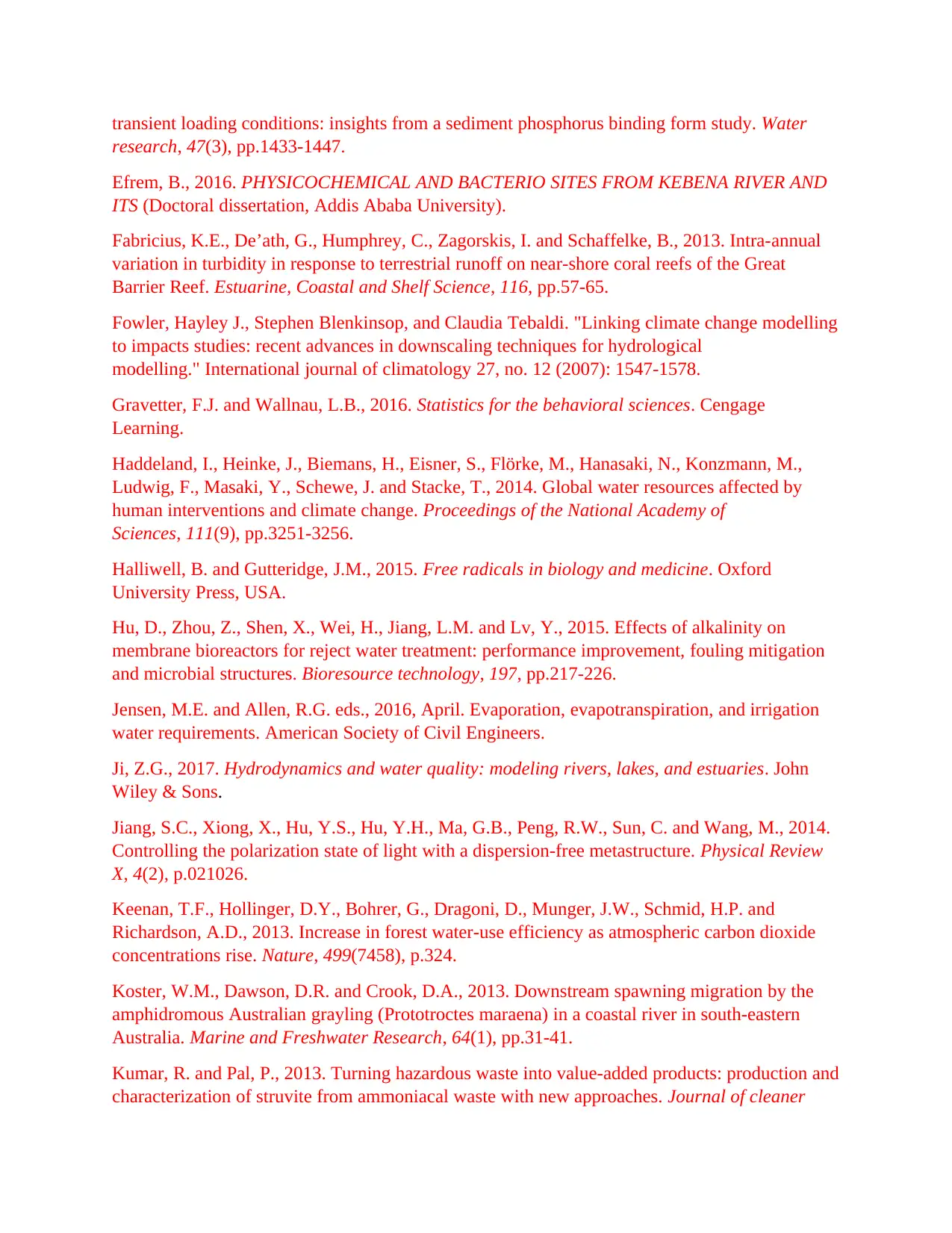
transient loading conditions: insights from a sediment phosphorus binding form study. Water
research, 47(3), pp.1433-1447.
Efrem, B., 2016. PHYSICOCHEMICAL AND BACTERIO SITES FROM KEBENA RIVER AND
ITS (Doctoral dissertation, Addis Ababa University).
Fabricius, K.E., De’ath, G., Humphrey, C., Zagorskis, I. and Schaffelke, B., 2013. Intra-annual
variation in turbidity in response to terrestrial runoff on near-shore coral reefs of the Great
Barrier Reef. Estuarine, Coastal and Shelf Science, 116, pp.57-65.
Fowler, Hayley J., Stephen Blenkinsop, and Claudia Tebaldi. "Linking climate change modelling
to impacts studies: recent advances in downscaling techniques for hydrological
modelling." International journal of climatology 27, no. 12 (2007): 1547-1578.
Gravetter, F.J. and Wallnau, L.B., 2016. Statistics for the behavioral sciences. Cengage
Learning.
Haddeland, I., Heinke, J., Biemans, H., Eisner, S., Flörke, M., Hanasaki, N., Konzmann, M.,
Ludwig, F., Masaki, Y., Schewe, J. and Stacke, T., 2014. Global water resources affected by
human interventions and climate change. Proceedings of the National Academy of
Sciences, 111(9), pp.3251-3256.
Halliwell, B. and Gutteridge, J.M., 2015. Free radicals in biology and medicine. Oxford
University Press, USA.
Hu, D., Zhou, Z., Shen, X., Wei, H., Jiang, L.M. and Lv, Y., 2015. Effects of alkalinity on
membrane bioreactors for reject water treatment: performance improvement, fouling mitigation
and microbial structures. Bioresource technology, 197, pp.217-226.
Jensen, M.E. and Allen, R.G. eds., 2016, April. Evaporation, evapotranspiration, and irrigation
water requirements. American Society of Civil Engineers.
Ji, Z.G., 2017. Hydrodynamics and water quality: modeling rivers, lakes, and estuaries. John
Wiley & Sons.
Jiang, S.C., Xiong, X., Hu, Y.S., Hu, Y.H., Ma, G.B., Peng, R.W., Sun, C. and Wang, M., 2014.
Controlling the polarization state of light with a dispersion-free metastructure. Physical Review
X, 4(2), p.021026.
Keenan, T.F., Hollinger, D.Y., Bohrer, G., Dragoni, D., Munger, J.W., Schmid, H.P. and
Richardson, A.D., 2013. Increase in forest water-use efficiency as atmospheric carbon dioxide
concentrations rise. Nature, 499(7458), p.324.
Koster, W.M., Dawson, D.R. and Crook, D.A., 2013. Downstream spawning migration by the
amphidromous Australian grayling (Prototroctes maraena) in a coastal river in south-eastern
Australia. Marine and Freshwater Research, 64(1), pp.31-41.
Kumar, R. and Pal, P., 2013. Turning hazardous waste into value-added products: production and
characterization of struvite from ammoniacal waste with new approaches. Journal of cleaner
research, 47(3), pp.1433-1447.
Efrem, B., 2016. PHYSICOCHEMICAL AND BACTERIO SITES FROM KEBENA RIVER AND
ITS (Doctoral dissertation, Addis Ababa University).
Fabricius, K.E., De’ath, G., Humphrey, C., Zagorskis, I. and Schaffelke, B., 2013. Intra-annual
variation in turbidity in response to terrestrial runoff on near-shore coral reefs of the Great
Barrier Reef. Estuarine, Coastal and Shelf Science, 116, pp.57-65.
Fowler, Hayley J., Stephen Blenkinsop, and Claudia Tebaldi. "Linking climate change modelling
to impacts studies: recent advances in downscaling techniques for hydrological
modelling." International journal of climatology 27, no. 12 (2007): 1547-1578.
Gravetter, F.J. and Wallnau, L.B., 2016. Statistics for the behavioral sciences. Cengage
Learning.
Haddeland, I., Heinke, J., Biemans, H., Eisner, S., Flörke, M., Hanasaki, N., Konzmann, M.,
Ludwig, F., Masaki, Y., Schewe, J. and Stacke, T., 2014. Global water resources affected by
human interventions and climate change. Proceedings of the National Academy of
Sciences, 111(9), pp.3251-3256.
Halliwell, B. and Gutteridge, J.M., 2015. Free radicals in biology and medicine. Oxford
University Press, USA.
Hu, D., Zhou, Z., Shen, X., Wei, H., Jiang, L.M. and Lv, Y., 2015. Effects of alkalinity on
membrane bioreactors for reject water treatment: performance improvement, fouling mitigation
and microbial structures. Bioresource technology, 197, pp.217-226.
Jensen, M.E. and Allen, R.G. eds., 2016, April. Evaporation, evapotranspiration, and irrigation
water requirements. American Society of Civil Engineers.
Ji, Z.G., 2017. Hydrodynamics and water quality: modeling rivers, lakes, and estuaries. John
Wiley & Sons.
Jiang, S.C., Xiong, X., Hu, Y.S., Hu, Y.H., Ma, G.B., Peng, R.W., Sun, C. and Wang, M., 2014.
Controlling the polarization state of light with a dispersion-free metastructure. Physical Review
X, 4(2), p.021026.
Keenan, T.F., Hollinger, D.Y., Bohrer, G., Dragoni, D., Munger, J.W., Schmid, H.P. and
Richardson, A.D., 2013. Increase in forest water-use efficiency as atmospheric carbon dioxide
concentrations rise. Nature, 499(7458), p.324.
Koster, W.M., Dawson, D.R. and Crook, D.A., 2013. Downstream spawning migration by the
amphidromous Australian grayling (Prototroctes maraena) in a coastal river in south-eastern
Australia. Marine and Freshwater Research, 64(1), pp.31-41.
Kumar, R. and Pal, P., 2013. Turning hazardous waste into value-added products: production and
characterization of struvite from ammoniacal waste with new approaches. Journal of cleaner
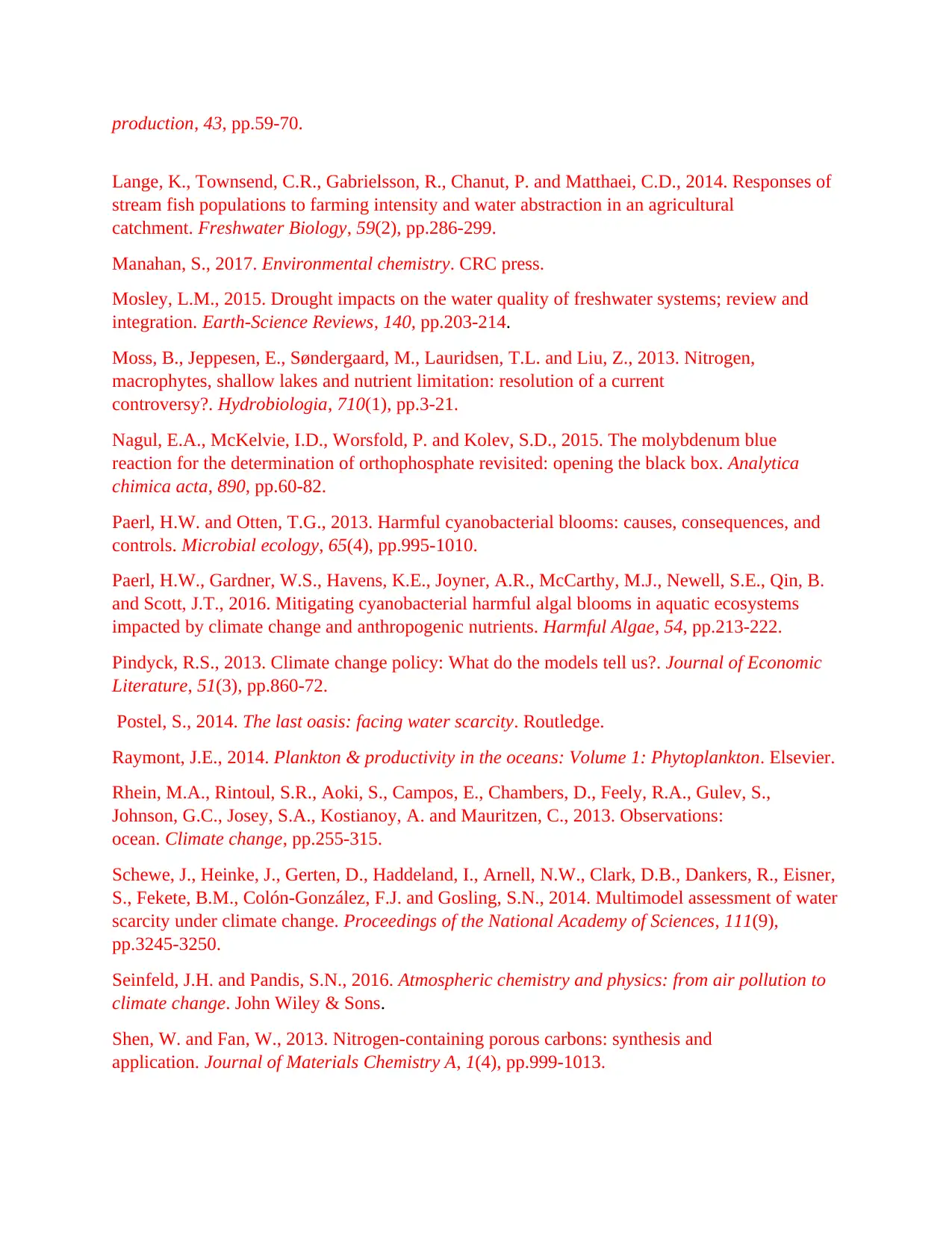
production, 43, pp.59-70.
Lange, K., Townsend, C.R., Gabrielsson, R., Chanut, P. and Matthaei, C.D., 2014. Responses of
stream fish populations to farming intensity and water abstraction in an agricultural
catchment. Freshwater Biology, 59(2), pp.286-299.
Manahan, S., 2017. Environmental chemistry. CRC press.
Mosley, L.M., 2015. Drought impacts on the water quality of freshwater systems; review and
integration. Earth-Science Reviews, 140, pp.203-214.
Moss, B., Jeppesen, E., Søndergaard, M., Lauridsen, T.L. and Liu, Z., 2013. Nitrogen,
macrophytes, shallow lakes and nutrient limitation: resolution of a current
controversy?. Hydrobiologia, 710(1), pp.3-21.
Nagul, E.A., McKelvie, I.D., Worsfold, P. and Kolev, S.D., 2015. The molybdenum blue
reaction for the determination of orthophosphate revisited: opening the black box. Analytica
chimica acta, 890, pp.60-82.
Paerl, H.W. and Otten, T.G., 2013. Harmful cyanobacterial blooms: causes, consequences, and
controls. Microbial ecology, 65(4), pp.995-1010.
Paerl, H.W., Gardner, W.S., Havens, K.E., Joyner, A.R., McCarthy, M.J., Newell, S.E., Qin, B.
and Scott, J.T., 2016. Mitigating cyanobacterial harmful algal blooms in aquatic ecosystems
impacted by climate change and anthropogenic nutrients. Harmful Algae, 54, pp.213-222.
Pindyck, R.S., 2013. Climate change policy: What do the models tell us?. Journal of Economic
Literature, 51(3), pp.860-72.
Postel, S., 2014. The last oasis: facing water scarcity. Routledge.
Raymont, J.E., 2014. Plankton & productivity in the oceans: Volume 1: Phytoplankton. Elsevier.
Rhein, M.A., Rintoul, S.R., Aoki, S., Campos, E., Chambers, D., Feely, R.A., Gulev, S.,
Johnson, G.C., Josey, S.A., Kostianoy, A. and Mauritzen, C., 2013. Observations:
ocean. Climate change, pp.255-315.
Schewe, J., Heinke, J., Gerten, D., Haddeland, I., Arnell, N.W., Clark, D.B., Dankers, R., Eisner,
S., Fekete, B.M., Colón-González, F.J. and Gosling, S.N., 2014. Multimodel assessment of water
scarcity under climate change. Proceedings of the National Academy of Sciences, 111(9),
pp.3245-3250.
Seinfeld, J.H. and Pandis, S.N., 2016. Atmospheric chemistry and physics: from air pollution to
climate change. John Wiley & Sons.
Shen, W. and Fan, W., 2013. Nitrogen-containing porous carbons: synthesis and
application. Journal of Materials Chemistry A, 1(4), pp.999-1013.
Lange, K., Townsend, C.R., Gabrielsson, R., Chanut, P. and Matthaei, C.D., 2014. Responses of
stream fish populations to farming intensity and water abstraction in an agricultural
catchment. Freshwater Biology, 59(2), pp.286-299.
Manahan, S., 2017. Environmental chemistry. CRC press.
Mosley, L.M., 2015. Drought impacts on the water quality of freshwater systems; review and
integration. Earth-Science Reviews, 140, pp.203-214.
Moss, B., Jeppesen, E., Søndergaard, M., Lauridsen, T.L. and Liu, Z., 2013. Nitrogen,
macrophytes, shallow lakes and nutrient limitation: resolution of a current
controversy?. Hydrobiologia, 710(1), pp.3-21.
Nagul, E.A., McKelvie, I.D., Worsfold, P. and Kolev, S.D., 2015. The molybdenum blue
reaction for the determination of orthophosphate revisited: opening the black box. Analytica
chimica acta, 890, pp.60-82.
Paerl, H.W. and Otten, T.G., 2013. Harmful cyanobacterial blooms: causes, consequences, and
controls. Microbial ecology, 65(4), pp.995-1010.
Paerl, H.W., Gardner, W.S., Havens, K.E., Joyner, A.R., McCarthy, M.J., Newell, S.E., Qin, B.
and Scott, J.T., 2016. Mitigating cyanobacterial harmful algal blooms in aquatic ecosystems
impacted by climate change and anthropogenic nutrients. Harmful Algae, 54, pp.213-222.
Pindyck, R.S., 2013. Climate change policy: What do the models tell us?. Journal of Economic
Literature, 51(3), pp.860-72.
Postel, S., 2014. The last oasis: facing water scarcity. Routledge.
Raymont, J.E., 2014. Plankton & productivity in the oceans: Volume 1: Phytoplankton. Elsevier.
Rhein, M.A., Rintoul, S.R., Aoki, S., Campos, E., Chambers, D., Feely, R.A., Gulev, S.,
Johnson, G.C., Josey, S.A., Kostianoy, A. and Mauritzen, C., 2013. Observations:
ocean. Climate change, pp.255-315.
Schewe, J., Heinke, J., Gerten, D., Haddeland, I., Arnell, N.W., Clark, D.B., Dankers, R., Eisner,
S., Fekete, B.M., Colón-González, F.J. and Gosling, S.N., 2014. Multimodel assessment of water
scarcity under climate change. Proceedings of the National Academy of Sciences, 111(9),
pp.3245-3250.
Seinfeld, J.H. and Pandis, S.N., 2016. Atmospheric chemistry and physics: from air pollution to
climate change. John Wiley & Sons.
Shen, W. and Fan, W., 2013. Nitrogen-containing porous carbons: synthesis and
application. Journal of Materials Chemistry A, 1(4), pp.999-1013.
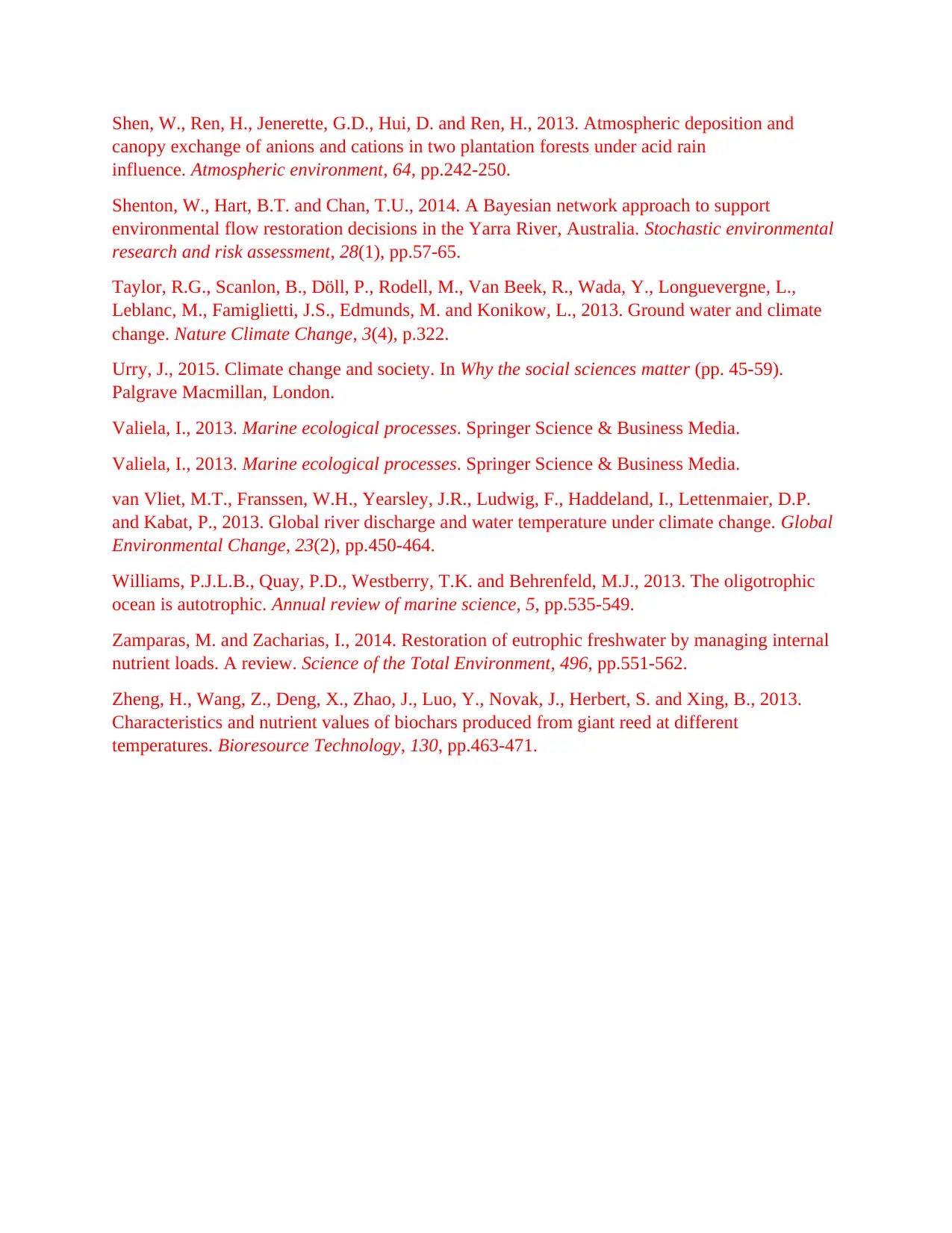
Shen, W., Ren, H., Jenerette, G.D., Hui, D. and Ren, H., 2013. Atmospheric deposition and
canopy exchange of anions and cations in two plantation forests under acid rain
influence. Atmospheric environment, 64, pp.242-250.
Shenton, W., Hart, B.T. and Chan, T.U., 2014. A Bayesian network approach to support
environmental flow restoration decisions in the Yarra River, Australia. Stochastic environmental
research and risk assessment, 28(1), pp.57-65.
Taylor, R.G., Scanlon, B., Döll, P., Rodell, M., Van Beek, R., Wada, Y., Longuevergne, L.,
Leblanc, M., Famiglietti, J.S., Edmunds, M. and Konikow, L., 2013. Ground water and climate
change. Nature Climate Change, 3(4), p.322.
Urry, J., 2015. Climate change and society. In Why the social sciences matter (pp. 45-59).
Palgrave Macmillan, London.
Valiela, I., 2013. Marine ecological processes. Springer Science & Business Media.
Valiela, I., 2013. Marine ecological processes. Springer Science & Business Media.
van Vliet, M.T., Franssen, W.H., Yearsley, J.R., Ludwig, F., Haddeland, I., Lettenmaier, D.P.
and Kabat, P., 2013. Global river discharge and water temperature under climate change. Global
Environmental Change, 23(2), pp.450-464.
Williams, P.J.L.B., Quay, P.D., Westberry, T.K. and Behrenfeld, M.J., 2013. The oligotrophic
ocean is autotrophic. Annual review of marine science, 5, pp.535-549.
Zamparas, M. and Zacharias, I., 2014. Restoration of eutrophic freshwater by managing internal
nutrient loads. A review. Science of the Total Environment, 496, pp.551-562.
Zheng, H., Wang, Z., Deng, X., Zhao, J., Luo, Y., Novak, J., Herbert, S. and Xing, B., 2013.
Characteristics and nutrient values of biochars produced from giant reed at different
temperatures. Bioresource Technology, 130, pp.463-471.
canopy exchange of anions and cations in two plantation forests under acid rain
influence. Atmospheric environment, 64, pp.242-250.
Shenton, W., Hart, B.T. and Chan, T.U., 2014. A Bayesian network approach to support
environmental flow restoration decisions in the Yarra River, Australia. Stochastic environmental
research and risk assessment, 28(1), pp.57-65.
Taylor, R.G., Scanlon, B., Döll, P., Rodell, M., Van Beek, R., Wada, Y., Longuevergne, L.,
Leblanc, M., Famiglietti, J.S., Edmunds, M. and Konikow, L., 2013. Ground water and climate
change. Nature Climate Change, 3(4), p.322.
Urry, J., 2015. Climate change and society. In Why the social sciences matter (pp. 45-59).
Palgrave Macmillan, London.
Valiela, I., 2013. Marine ecological processes. Springer Science & Business Media.
Valiela, I., 2013. Marine ecological processes. Springer Science & Business Media.
van Vliet, M.T., Franssen, W.H., Yearsley, J.R., Ludwig, F., Haddeland, I., Lettenmaier, D.P.
and Kabat, P., 2013. Global river discharge and water temperature under climate change. Global
Environmental Change, 23(2), pp.450-464.
Williams, P.J.L.B., Quay, P.D., Westberry, T.K. and Behrenfeld, M.J., 2013. The oligotrophic
ocean is autotrophic. Annual review of marine science, 5, pp.535-549.
Zamparas, M. and Zacharias, I., 2014. Restoration of eutrophic freshwater by managing internal
nutrient loads. A review. Science of the Total Environment, 496, pp.551-562.
Zheng, H., Wang, Z., Deng, X., Zhao, J., Luo, Y., Novak, J., Herbert, S. and Xing, B., 2013.
Characteristics and nutrient values of biochars produced from giant reed at different
temperatures. Bioresource Technology, 130, pp.463-471.
Paraphrase This Document
Need a fresh take? Get an instant paraphrase of this document with our AI Paraphraser

1 out of 44
Your All-in-One AI-Powered Toolkit for Academic Success.
+13062052269
info@desklib.com
Available 24*7 on WhatsApp / Email
![[object Object]](/_next/static/media/star-bottom.7253800d.svg)
Unlock your academic potential
© 2024 | Zucol Services PVT LTD | All rights reserved.